Tim Notier's Blog, page 9
November 24, 2019
20 Great Gifts for Motorcyclists
By Tim Notier With Black Friday and Cyber Monday upon us once again, it is time to start pondering what to get our two-wheeled riding loved ones for Christmas, Hanukkah, whatever gift-giving traditions that the church of the Flying Spaghetti Monster may have, and even for the atheist in your life that likes receiving gifts on a cold December day.
Here is a brief list for those motorcycle enthusiasts in your life. These are some of our favorite items which have served us well on our round-the-world trip. We are not sponsored by any of the products below, and bought each item ourselves with our hard-earned money. These are simply our fair, honest opinions after putting them through hell over the last two years. Stocking Stuffers Some great items that wont break the bank. The links to products and their reviews on Amazon are highlighted in Green. Don't just take our word for the items below, click on the links to see detailed pictures and further reviews that will help make an informative decision.
Phones are so expensive, even more so when waterproof. But for our GPS-dedicated device, we needed one. The Kyocera Duraforce had been unbreakable for over two years. But before we left to Africa, I upgraded to the Kyocera Duraforce XD that has a larger screen. For less than a hundred bucks, with the addition of Google offline maps, OSM+, iOverlander, and Maps.me, this, in my opinion, is the best navigation set-up available. It is waterproof, dust-proof, shock-proof, and life-proof. Plus, if stolen, you are only out ~$90 compared to $500-$1,000 or more. Navigation is key while riding, and keeping our phone locked in place is essential. After a bit of trial and error with other products, we bought the Perfect Squeeze, and it has kept our phone sturdily in place over potholes, river crossings, corrugated roads, and Latin American speed bumps (a.k.a. sleeping policemen) throughout our journey. To charge all of our electronics while we are wild camping for multiple nights in a row, we bought an EasyAcc Portable Charger. It has four USB outlets, and we can charge both of our phones, and both or our Senas at the same time. Magnetic Charging Cords come in real handy. They take away the wear and tear of constantly plugging in and disconnecting your gadgets. And if you keep your phone or GPS plugged in while riding, the bumps of the road can ruin the port. Please check these out, they are cheap and very convenient. For questionable tap water, we use a SteriPen Adventurer. This little gadget is great when you are uncertain of water quality. A quick bath in UV light kills more than 99.9% of harmful microorganisms. This makes us (and our stomachs) feel much better when drinking from questionable sources. To save all of our pictures and videos, we wanted a solid-state external hard drive. We had purchased the standard disk drives, and they failed us. You definitely do not want that happening and loosing all of your glorious footage!!! We bought a MyDigital SSD drive, and it has served us flawlessly. For a smaller, more portable thumb-drive, we each have a Samsung 128 gig flash drive. It's perfect for saving documents and other easier access items quickly, and is unbelievably small. To avoid snatch-and-grab would-be thieves while we walk around markets, or leave the bike unattended, we have two Big Panther carabiner locks with a metal bungie. We use them to secure our helmets, boots, and jackets to the bike. I also put a Grip Lock on the break lever so no one can push the motorcycle from where I left it. Both of these cheap deterrents help prevent people from snagging our stuff. A lot of people see our Hip Bags in photos and ask, “Where did we get those from?" We bought them cheap on Amazon, and there are plenty to choose from. Marisa uses hers as a purse around her shoulder when going around town, and then strapped to her leg while on the road. Under the Tree Communication on the road is important. And even more so, being able to listen to music. We have the ever so popular Sena Bluetooth Headsets and have been impressed with them from the beginning. Hours on the road have dramatically changed for the better when listening to anything from Guns and Roses to Jack Johnson, or in Marisa's case, it's one big epic movie soundtrack as she meanders around the world.
Navigation is key while riding, and keeping our phone locked in place is essential. After a bit of trial and error with other products, we bought the Perfect Squeeze, and it has kept our phone sturdily in place over potholes, river crossings, corrugated roads, and Latin American speed bumps (a.k.a. sleeping policemen) throughout our journey. To charge all of our electronics while we are wild camping for multiple nights in a row, we bought an EasyAcc Portable Charger. It has four USB outlets, and we can charge both of our phones, and both or our Senas at the same time. Magnetic Charging Cords come in real handy. They take away the wear and tear of constantly plugging in and disconnecting your gadgets. And if you keep your phone or GPS plugged in while riding, the bumps of the road can ruin the port. Please check these out, they are cheap and very convenient. For questionable tap water, we use a SteriPen Adventurer. This little gadget is great when you are uncertain of water quality. A quick bath in UV light kills more than 99.9% of harmful microorganisms. This makes us (and our stomachs) feel much better when drinking from questionable sources. To save all of our pictures and videos, we wanted a solid-state external hard drive. We had purchased the standard disk drives, and they failed us. You definitely do not want that happening and loosing all of your glorious footage!!! We bought a MyDigital SSD drive, and it has served us flawlessly. For a smaller, more portable thumb-drive, we each have a Samsung 128 gig flash drive. It's perfect for saving documents and other easier access items quickly, and is unbelievably small. To avoid snatch-and-grab would-be thieves while we walk around markets, or leave the bike unattended, we have two Big Panther carabiner locks with a metal bungie. We use them to secure our helmets, boots, and jackets to the bike. I also put a Grip Lock on the break lever so no one can push the motorcycle from where I left it. Both of these cheap deterrents help prevent people from snagging our stuff. A lot of people see our Hip Bags in photos and ask, “Where did we get those from?" We bought them cheap on Amazon, and there are plenty to choose from. Marisa uses hers as a purse around her shoulder when going around town, and then strapped to her leg while on the road. Under the Tree Communication on the road is important. And even more so, being able to listen to music. We have the ever so popular Sena Bluetooth Headsets and have been impressed with them from the beginning. Hours on the road have dramatically changed for the better when listening to anything from Guns and Roses to Jack Johnson, or in Marisa's case, it's one big epic movie soundtrack as she meanders around the world.
Our G4Free chairs have been some of our favorite bonus items we have. From sitting down at campsites, on beaches, or even hours-long roadblocks, we have never regretted bringing these with us.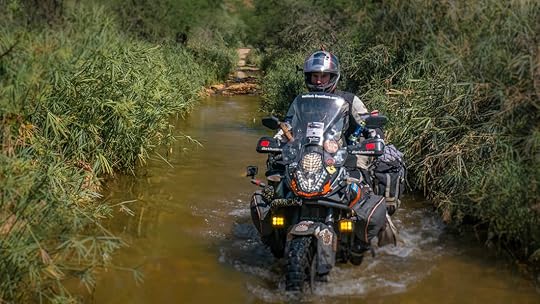 Me riding through a small puddle... Cooking on the road is also important. The MSR Whisperlight stove has been unstoppable and seems to be the go-to product for long distance travel. Paired with the MSR liquid fuel bottle, it can burn any fuel, and is pretty much hassle-free with the right maintenance. We do also carry an extra fuel pump, just in case the original acts up.
Me riding through a small puddle... Cooking on the road is also important. The MSR Whisperlight stove has been unstoppable and seems to be the go-to product for long distance travel. Paired with the MSR liquid fuel bottle, it can burn any fuel, and is pretty much hassle-free with the right maintenance. We do also carry an extra fuel pump, just in case the original acts up.
Water sources abroad are not always the cleanest, so to filter the muck, toxic minerals, and E-coli out, we have now upgraded to an MSR AutoFlow Gravity Water Filter. It sure beats the hell out of hand pumping our old filter that felt like I had thrown my arm out after every 2 liters. But from cooking to making the essence of life, coffee, it has served us very well and kept us healthy here in Africa. For extended camping, we just fill up our 6 liter MSR Dromedary bag to have plenty of water on hand.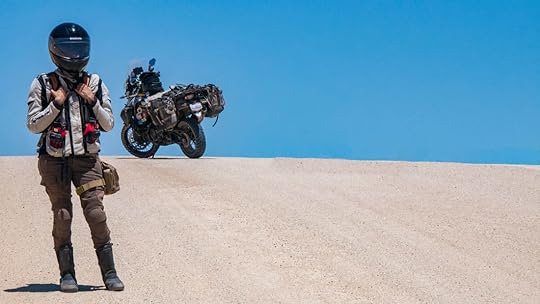 Marisa on a small astroid in the Namibian galaxy The "They have been really good" List
Marisa on a small astroid in the Namibian galaxy The "They have been really good" List
As a middleweight camera, not a DSLR but not a standard point and shoot, the Panasonic Lumix G7 4k mirrorless camera has been an amazing piece of hardware that has captured all of the great images that we have taken along the way. I love this camera.
For “action" videos, we splurged and bought a GoPro Hero6 (I know, it's expensive, but man is it worth it). It takes amazing footage and is much more reliable than the cheaper $100 range action cameras, two of which we went through before purchasing the GoPro. Plus, it has amazing stabilization and slow-motion.
Communication and tracking is both important to us as well as to our families, so we bought a Garmin inReach Explorer. With our data plan, we've been able to track our journey every turn of the wheel. We can also text (SMS) from anywhere in the world. And if something horrible were to happen, there is also an SOS button that will send the troops directly to our location. But most importantly, Marisa's mother knows exactly where we are each and every day. If you're trying to receive the Best Christmas Present of the Year award, check out Mosko Moto's line up of Motorcycle Panniers. These bags have solved many of our luggage issues and have survived the nightmare that we've put them through. When a great company, that is run by riders like you and I, come up with a flawless luggage system, you bet I am going to bang pots and pans and scream their name in the streets.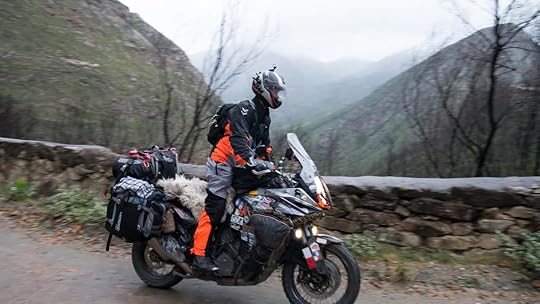 I personally can vouch for each and every one of these items. Some things on this trip have fallen apart or have not served us well, but not these items. They are travel-tried and true, and I'm sure that it would make any adventure motorcyclist grin from ear to ear to unwrap one of these gifts.
I personally can vouch for each and every one of these items. Some things on this trip have fallen apart or have not served us well, but not these items. They are travel-tried and true, and I'm sure that it would make any adventure motorcyclist grin from ear to ear to unwrap one of these gifts.
For a more detailed list of every item we bring with us, along with our ratings of what has worked and what hasn't, check out Our Gear page.
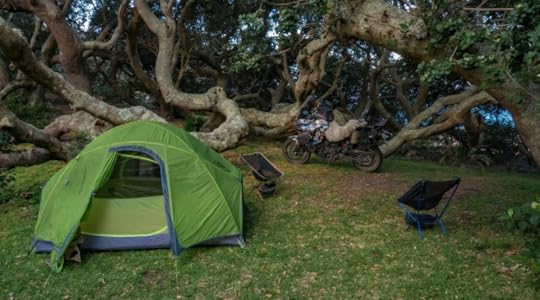 I of course have to plug our growing collection of adventure books and guides. Within the chapters of Maiden Voyage is even more insight into our original gear. You can read about how we were woefully unprepared for our trip around the American West. None of the gear we had purchased for that trip made it onto the current trip we are undertaking. Learn more about both books we have, along with their Amazon reviews, here: Books for Sale.
I of course have to plug our growing collection of adventure books and guides. Within the chapters of Maiden Voyage is even more insight into our original gear. You can read about how we were woefully unprepared for our trip around the American West. None of the gear we had purchased for that trip made it onto the current trip we are undertaking. Learn more about both books we have, along with their Amazon reviews, here: Books for Sale.
And for any visual inspiration, check out our Photos for Sale. Books for Sale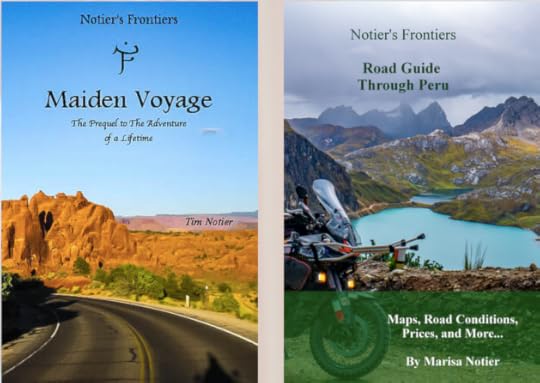 Photos for Sale
Photos for Sale 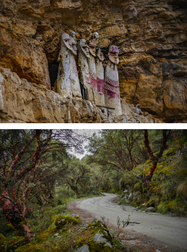
Here is a brief list for those motorcycle enthusiasts in your life. These are some of our favorite items which have served us well on our round-the-world trip. We are not sponsored by any of the products below, and bought each item ourselves with our hard-earned money. These are simply our fair, honest opinions after putting them through hell over the last two years. Stocking Stuffers Some great items that wont break the bank. The links to products and their reviews on Amazon are highlighted in Green. Don't just take our word for the items below, click on the links to see detailed pictures and further reviews that will help make an informative decision.
Phones are so expensive, even more so when waterproof. But for our GPS-dedicated device, we needed one. The Kyocera Duraforce had been unbreakable for over two years. But before we left to Africa, I upgraded to the Kyocera Duraforce XD that has a larger screen. For less than a hundred bucks, with the addition of Google offline maps, OSM+, iOverlander, and Maps.me, this, in my opinion, is the best navigation set-up available. It is waterproof, dust-proof, shock-proof, and life-proof. Plus, if stolen, you are only out ~$90 compared to $500-$1,000 or more.
 Navigation is key while riding, and keeping our phone locked in place is essential. After a bit of trial and error with other products, we bought the Perfect Squeeze, and it has kept our phone sturdily in place over potholes, river crossings, corrugated roads, and Latin American speed bumps (a.k.a. sleeping policemen) throughout our journey. To charge all of our electronics while we are wild camping for multiple nights in a row, we bought an EasyAcc Portable Charger. It has four USB outlets, and we can charge both of our phones, and both or our Senas at the same time. Magnetic Charging Cords come in real handy. They take away the wear and tear of constantly plugging in and disconnecting your gadgets. And if you keep your phone or GPS plugged in while riding, the bumps of the road can ruin the port. Please check these out, they are cheap and very convenient. For questionable tap water, we use a SteriPen Adventurer. This little gadget is great when you are uncertain of water quality. A quick bath in UV light kills more than 99.9% of harmful microorganisms. This makes us (and our stomachs) feel much better when drinking from questionable sources. To save all of our pictures and videos, we wanted a solid-state external hard drive. We had purchased the standard disk drives, and they failed us. You definitely do not want that happening and loosing all of your glorious footage!!! We bought a MyDigital SSD drive, and it has served us flawlessly. For a smaller, more portable thumb-drive, we each have a Samsung 128 gig flash drive. It's perfect for saving documents and other easier access items quickly, and is unbelievably small. To avoid snatch-and-grab would-be thieves while we walk around markets, or leave the bike unattended, we have two Big Panther carabiner locks with a metal bungie. We use them to secure our helmets, boots, and jackets to the bike. I also put a Grip Lock on the break lever so no one can push the motorcycle from where I left it. Both of these cheap deterrents help prevent people from snagging our stuff. A lot of people see our Hip Bags in photos and ask, “Where did we get those from?" We bought them cheap on Amazon, and there are plenty to choose from. Marisa uses hers as a purse around her shoulder when going around town, and then strapped to her leg while on the road. Under the Tree Communication on the road is important. And even more so, being able to listen to music. We have the ever so popular Sena Bluetooth Headsets and have been impressed with them from the beginning. Hours on the road have dramatically changed for the better when listening to anything from Guns and Roses to Jack Johnson, or in Marisa's case, it's one big epic movie soundtrack as she meanders around the world.
Navigation is key while riding, and keeping our phone locked in place is essential. After a bit of trial and error with other products, we bought the Perfect Squeeze, and it has kept our phone sturdily in place over potholes, river crossings, corrugated roads, and Latin American speed bumps (a.k.a. sleeping policemen) throughout our journey. To charge all of our electronics while we are wild camping for multiple nights in a row, we bought an EasyAcc Portable Charger. It has four USB outlets, and we can charge both of our phones, and both or our Senas at the same time. Magnetic Charging Cords come in real handy. They take away the wear and tear of constantly plugging in and disconnecting your gadgets. And if you keep your phone or GPS plugged in while riding, the bumps of the road can ruin the port. Please check these out, they are cheap and very convenient. For questionable tap water, we use a SteriPen Adventurer. This little gadget is great when you are uncertain of water quality. A quick bath in UV light kills more than 99.9% of harmful microorganisms. This makes us (and our stomachs) feel much better when drinking from questionable sources. To save all of our pictures and videos, we wanted a solid-state external hard drive. We had purchased the standard disk drives, and they failed us. You definitely do not want that happening and loosing all of your glorious footage!!! We bought a MyDigital SSD drive, and it has served us flawlessly. For a smaller, more portable thumb-drive, we each have a Samsung 128 gig flash drive. It's perfect for saving documents and other easier access items quickly, and is unbelievably small. To avoid snatch-and-grab would-be thieves while we walk around markets, or leave the bike unattended, we have two Big Panther carabiner locks with a metal bungie. We use them to secure our helmets, boots, and jackets to the bike. I also put a Grip Lock on the break lever so no one can push the motorcycle from where I left it. Both of these cheap deterrents help prevent people from snagging our stuff. A lot of people see our Hip Bags in photos and ask, “Where did we get those from?" We bought them cheap on Amazon, and there are plenty to choose from. Marisa uses hers as a purse around her shoulder when going around town, and then strapped to her leg while on the road. Under the Tree Communication on the road is important. And even more so, being able to listen to music. We have the ever so popular Sena Bluetooth Headsets and have been impressed with them from the beginning. Hours on the road have dramatically changed for the better when listening to anything from Guns and Roses to Jack Johnson, or in Marisa's case, it's one big epic movie soundtrack as she meanders around the world.Our G4Free chairs have been some of our favorite bonus items we have. From sitting down at campsites, on beaches, or even hours-long roadblocks, we have never regretted bringing these with us.
 Me riding through a small puddle... Cooking on the road is also important. The MSR Whisperlight stove has been unstoppable and seems to be the go-to product for long distance travel. Paired with the MSR liquid fuel bottle, it can burn any fuel, and is pretty much hassle-free with the right maintenance. We do also carry an extra fuel pump, just in case the original acts up.
Me riding through a small puddle... Cooking on the road is also important. The MSR Whisperlight stove has been unstoppable and seems to be the go-to product for long distance travel. Paired with the MSR liquid fuel bottle, it can burn any fuel, and is pretty much hassle-free with the right maintenance. We do also carry an extra fuel pump, just in case the original acts up. Water sources abroad are not always the cleanest, so to filter the muck, toxic minerals, and E-coli out, we have now upgraded to an MSR AutoFlow Gravity Water Filter. It sure beats the hell out of hand pumping our old filter that felt like I had thrown my arm out after every 2 liters. But from cooking to making the essence of life, coffee, it has served us very well and kept us healthy here in Africa. For extended camping, we just fill up our 6 liter MSR Dromedary bag to have plenty of water on hand.
 Marisa on a small astroid in the Namibian galaxy The "They have been really good" List
Marisa on a small astroid in the Namibian galaxy The "They have been really good" List As a middleweight camera, not a DSLR but not a standard point and shoot, the Panasonic Lumix G7 4k mirrorless camera has been an amazing piece of hardware that has captured all of the great images that we have taken along the way. I love this camera.
For “action" videos, we splurged and bought a GoPro Hero6 (I know, it's expensive, but man is it worth it). It takes amazing footage and is much more reliable than the cheaper $100 range action cameras, two of which we went through before purchasing the GoPro. Plus, it has amazing stabilization and slow-motion.
Communication and tracking is both important to us as well as to our families, so we bought a Garmin inReach Explorer. With our data plan, we've been able to track our journey every turn of the wheel. We can also text (SMS) from anywhere in the world. And if something horrible were to happen, there is also an SOS button that will send the troops directly to our location. But most importantly, Marisa's mother knows exactly where we are each and every day. If you're trying to receive the Best Christmas Present of the Year award, check out Mosko Moto's line up of Motorcycle Panniers. These bags have solved many of our luggage issues and have survived the nightmare that we've put them through. When a great company, that is run by riders like you and I, come up with a flawless luggage system, you bet I am going to bang pots and pans and scream their name in the streets.
 I personally can vouch for each and every one of these items. Some things on this trip have fallen apart or have not served us well, but not these items. They are travel-tried and true, and I'm sure that it would make any adventure motorcyclist grin from ear to ear to unwrap one of these gifts.
I personally can vouch for each and every one of these items. Some things on this trip have fallen apart or have not served us well, but not these items. They are travel-tried and true, and I'm sure that it would make any adventure motorcyclist grin from ear to ear to unwrap one of these gifts.For a more detailed list of every item we bring with us, along with our ratings of what has worked and what hasn't, check out Our Gear page.
 I of course have to plug our growing collection of adventure books and guides. Within the chapters of Maiden Voyage is even more insight into our original gear. You can read about how we were woefully unprepared for our trip around the American West. None of the gear we had purchased for that trip made it onto the current trip we are undertaking. Learn more about both books we have, along with their Amazon reviews, here: Books for Sale.
I of course have to plug our growing collection of adventure books and guides. Within the chapters of Maiden Voyage is even more insight into our original gear. You can read about how we were woefully unprepared for our trip around the American West. None of the gear we had purchased for that trip made it onto the current trip we are undertaking. Learn more about both books we have, along with their Amazon reviews, here: Books for Sale.And for any visual inspiration, check out our Photos for Sale. Books for Sale
 Photos for Sale
Photos for Sale 
Published on November 24, 2019 01:09
November 23, 2019
Africa's Cheapest Safari: Self-Drive in Namibia
By Marisa 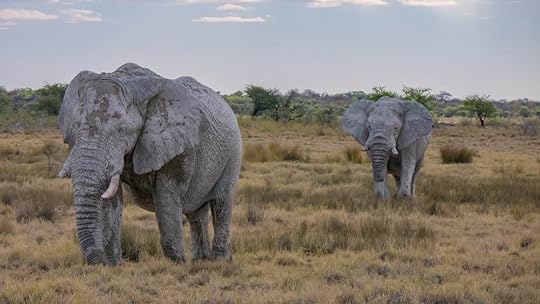 Most people who visit Africa usually go on a safari. And there's nothing else on the planet like it: driving through the flat grasslands of thorny acacia trees, telling your fellow travelers to hush when you think you see something, and then whipping out your camera and holding your breath as a several-ton elephant lumbers out of the trees. It's the stuff of legends.
Most people who visit Africa usually go on a safari. And there's nothing else on the planet like it: driving through the flat grasslands of thorny acacia trees, telling your fellow travelers to hush when you think you see something, and then whipping out your camera and holding your breath as a several-ton elephant lumbers out of the trees. It's the stuff of legends.
But there is a high price to be paid.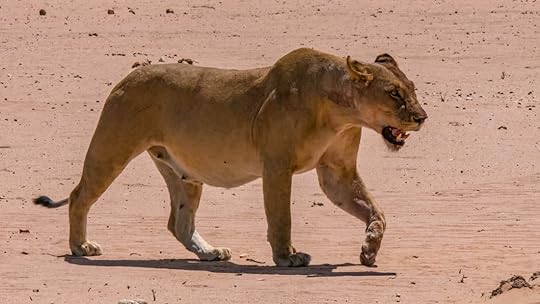 This ferocious mama is not to be messed with. Excluding the cost of actually getting to and from the African country in which you want to safari, and then finding transport, food, and accommodation, even just the safari itself may cost you upwards of $1,000. Per person, per day, of course.
This ferocious mama is not to be messed with. Excluding the cost of actually getting to and from the African country in which you want to safari, and then finding transport, food, and accommodation, even just the safari itself may cost you upwards of $1,000. Per person, per day, of course.
But there's a cheaper way: you can rent a car and do a self-drive tour through a place famous for its abundance of African wildlife: Etosha National Park in Namibia. You'll have control over everything, when you eat, where you go, how long you want to stay taking pictures of giraffes, and where you'll stay the night, all for a fraction of the cost.
4x4 Vehicle Rental (with rooftop tent): ~$100-$120 per day
Entrance to Etosha Park: $5.50 per person, per day
Camping within the park: $23 per person
Camping outside of the park: ~$15 per person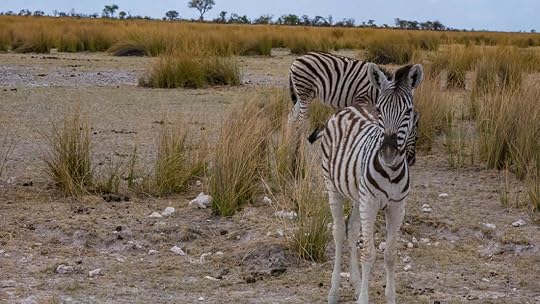 We went in November, and there were lots of baby animals around. And if you really want to have the knowledge and expertise of a professional guide take you through the park, then you can simply join an Etosha game drive for around $50.
We went in November, and there were lots of baby animals around. And if you really want to have the knowledge and expertise of a professional guide take you through the park, then you can simply join an Etosha game drive for around $50.
Much better than the thousands of dollars that you'll pay elsewhere. Step 1: Rent a Car in Windhoek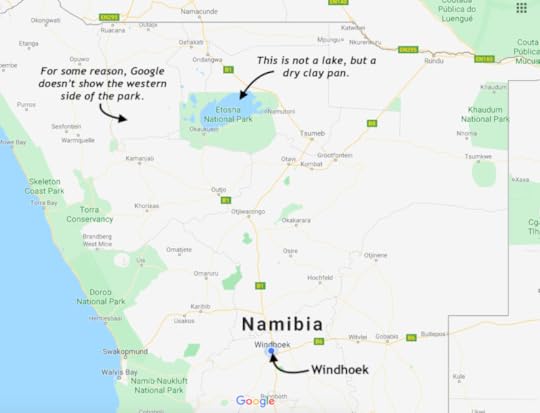 Because our motorcycle was broken in Namibia and we had to wait for a part to arrive, we decided to rent a car and explore by 4WD in the meantime. This turned out not to be as damaging to our schedule as we thought, because most of Namibia's sites are not accessible by motorcycle, including Etosha National Park. So having a 4x4 vehicle is really the way to go.
Because our motorcycle was broken in Namibia and we had to wait for a part to arrive, we decided to rent a car and explore by 4WD in the meantime. This turned out not to be as damaging to our schedule as we thought, because most of Namibia's sites are not accessible by motorcycle, including Etosha National Park. So having a 4x4 vehicle is really the way to go.
Windhoek is the capital city of Namibia, and is more or less in the middle of the country. That makes it fairly close to everything, and only a five-hour drive away from Etosha. So if you wanted to fly in, see the elephants for a couple days, and fly out, this could even be done in four days.
We rented our car for nine days, and this was enough time to see pretty much everything we wanted to see in the whole country, including the stunning red dunes of Sossuvlei, some beautiful mountain passes, fur seals on the skeleton coast, a visit to a Himba village, and three days in Etosha. Click here to see our itinerary.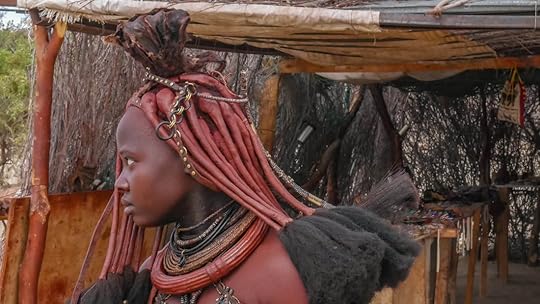 The beautiful Himba women of Namibia. If you have the time, three days in Etosha should be enough to have all your National Geographic dreams come true. And if you're lucky and see all your checklist animals on the first day, then you can use those extra days to relax by the pool, sleep in, or simply drive around to see it all again.
The beautiful Himba women of Namibia. If you have the time, three days in Etosha should be enough to have all your National Geographic dreams come true. And if you're lucky and see all your checklist animals on the first day, then you can use those extra days to relax by the pool, sleep in, or simply drive around to see it all again.
But in the end, what you see on a safari is about luck. And if you don't see anything but giraffes and springbok on the first two days, then you might want to dish out the money for a game drive on the last. This will increase your chances of seeing wildlife because the drivers are in constant communication with each other throughout the park as to where the local lion prides are, for example. So it's pretty much a guarantee to see elephants and lions.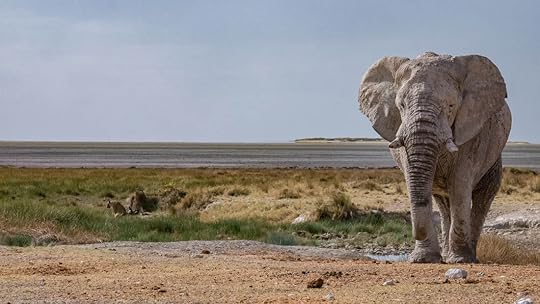 How about lions and elephants in the same shot? Yes, it can happen. Make sure you rent your car from a reputable agency (we didn't, and were stressing out the whole time about whether we'd get our deposit back). Namibian roads are very corrugated, and are known to eat up tires, so make sure you have at least one full-sized spare with you and a policy that covers a flat. Many rental agencies will provide you with two spares, and also look into coverage for chips in the windshield and other dents from rocks being flown at you.
How about lions and elephants in the same shot? Yes, it can happen. Make sure you rent your car from a reputable agency (we didn't, and were stressing out the whole time about whether we'd get our deposit back). Namibian roads are very corrugated, and are known to eat up tires, so make sure you have at least one full-sized spare with you and a policy that covers a flat. Many rental agencies will provide you with two spares, and also look into coverage for chips in the windshield and other dents from rocks being flown at you.
Most 4x4 rentals in Namibia will give you the option of having a rooftop tent. If you like to camp, this is definitely the cheapest (and in my opinion, most fun) way to go. Just make sure you zip up all of the netting since Etosha is in the malaria zone. Don't risk trading a cool breeze for a disease that may mess you up for a lot longer than an uncomfortably hot night. Step 2: Head to Etosha The thing about Etosha National Park which makes it so great for seeing wildlife is that unlike the Serengeti in Tanzania and Kenya, Kruger in South Africa, or the Okavango Delta in Botswana, Etosha is in a desert. That means that all the animals from the park must get their water needs at a watering hole, and lucky for us, they've built roads that lead directly to them. It's like driving up to The Lion King version of an outdoor theater at which you know the actors must show up.
The National Park opens from sunrise to sunset, and the only way to stay longer is to stay within the park at one of their campgrounds or lodges. Though it's more expensive than staying outside, this is recommended because they have floodlit waterholes there which certain more nocturnal animals frequent, such as rhinos and leopards.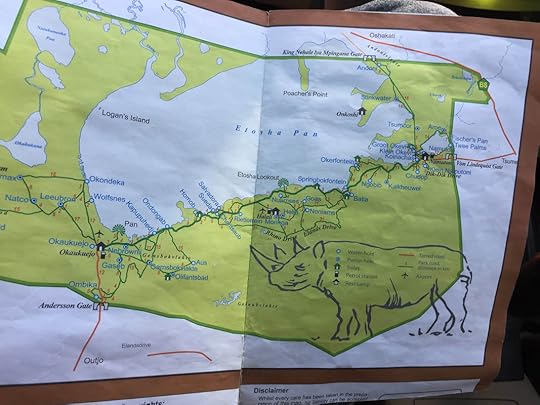 This is the eastern side of the park which is more popular with both animals and people. The park is broken up into two sections: the east that runs along the Etosha mud pan and has the most wildlife action, and the west which is more desolate, but also more intimate with less tour buses. You can find plenty of animals there too, but in general it's not as concentrated.
This is the eastern side of the park which is more popular with both animals and people. The park is broken up into two sections: the east that runs along the Etosha mud pan and has the most wildlife action, and the west which is more desolate, but also more intimate with less tour buses. You can find plenty of animals there too, but in general it's not as concentrated.
From Windhoek, you will most likely enter Etosha at Anderson Gate leading to Okaukuejo, which is right in the middle of the park on its southern edge. At the gate you'll fill out some paperwork, then pay once you get to Okaukuejo camp, which is 15 minutes up a paved road (one of the only paved roads). I suggest you stock up on food and snacks from outside the park, because even though there are restaurants and stores within, they are expensive and sorely lacking.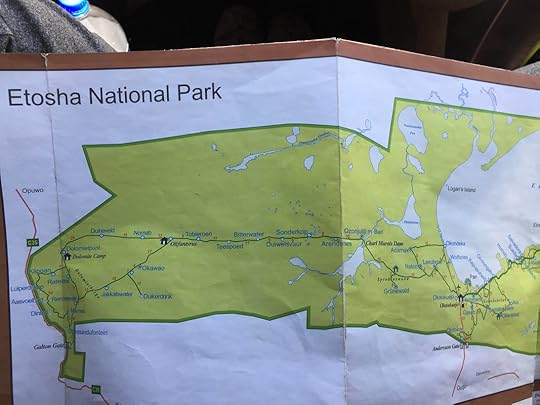 This is the western and less-frequented side of the park. Jakkalswater and Okawao are popular watering holes with wildlife. There are two other main camps on the eastern side: Halali, which is where you should stay if you want to see rhinos at night, and Namutoni on the eastern edge, which is atmospheric with its thatched huts. All three camps have petrol and supplies. A good plan of action would be to start early in the morning at Okaukuejo, and to try to stop at as many watering holes as you can on your way to Halali for a lunch break. Then you can continue going east and end up by Namutoni, or a campground outside of there for the night. The next day, do it all in reverse.
This is the western and less-frequented side of the park. Jakkalswater and Okawao are popular watering holes with wildlife. There are two other main camps on the eastern side: Halali, which is where you should stay if you want to see rhinos at night, and Namutoni on the eastern edge, which is atmospheric with its thatched huts. All three camps have petrol and supplies. A good plan of action would be to start early in the morning at Okaukuejo, and to try to stop at as many watering holes as you can on your way to Halali for a lunch break. Then you can continue going east and end up by Namutoni, or a campground outside of there for the night. The next day, do it all in reverse.
Having a map of the park is important, along with downloading offline Google maps of the area since many of the concrete “signs" in the park are worn away. And don't forget to pull over and talk to other safari-goers while at the watering holes. You might get some inside scoops on where the lions have been keeping their cubs, and where the elephant herds were last headed.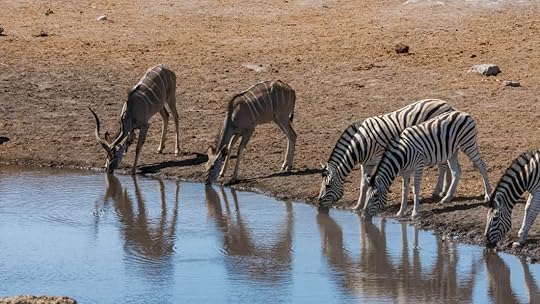 Kudus and Zebras. On the third day, either decide to hit up your favorite spots, or venture into the western side to have a more private experience without all the tour buses. There are two camps out there, Olifantsrus and Dolomite, but they're not nearly as well-equipped as the others. Plus, camping at Olifantsrus is more expensive than at the other camps for reasons I can't figure out, and you won't find gas at either.
Kudus and Zebras. On the third day, either decide to hit up your favorite spots, or venture into the western side to have a more private experience without all the tour buses. There are two camps out there, Olifantsrus and Dolomite, but they're not nearly as well-equipped as the others. Plus, camping at Olifantsrus is more expensive than at the other camps for reasons I can't figure out, and you won't find gas at either.
Alternatively, if you've been having bad luck, use your last day to join a game drive and let the experts take you to where they know the animals to be. Step 3: Follow the Rules Do not get out of your car - This is for obvious reasons. You can have your windows down, but no sitting on top of your car or sticking your arms out, even if you think you don't see any animals around. There are fenced-in rest areas scattered throughout the park where you can get out. If you get a flat, call the park's offices or wave someone down who can call for assistance.Be quiet - When you pull up to an area with wildlife, it's common courtesy to shut off your engine. This will also shut off your air-conditioning, yes, I realize that's a problem, but it's better for the animals. Best thing is to roll down your windows and be a part of your surroundings.Leave room for others - Everyone wants to get that perfect picture of the baby elephant, so if you find yourself in that prime location, once you're done taking pictures, make sure you pull away to let someone else share in the view.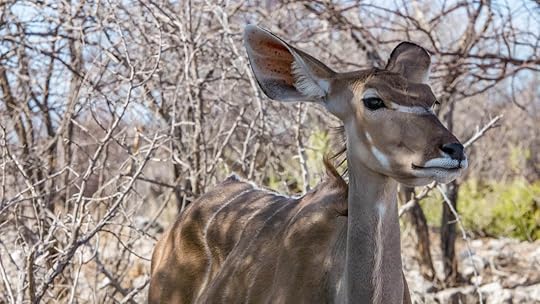 It's not all about lions and elephants. This is a female Kudu with all her Avatar-like war paint on. Isn't she gorgeous? Step 4: Enjoy the Wildlife! Because it's a desert, you won't find water-loving animals such as hippos, water buffalo, and crocodiles at Etosha.
It's not all about lions and elephants. This is a female Kudu with all her Avatar-like war paint on. Isn't she gorgeous? Step 4: Enjoy the Wildlife! Because it's a desert, you won't find water-loving animals such as hippos, water buffalo, and crocodiles at Etosha.
What you will see are antelope, zebras, giraffes, wildebeest, ostriches, warthogs, plus four of the “big five": elephants, lions, leopards, and rhino (no water buffalo).
To get a better idea of what you're looking at, here's a list starting at the bottom of the food chain: Antelope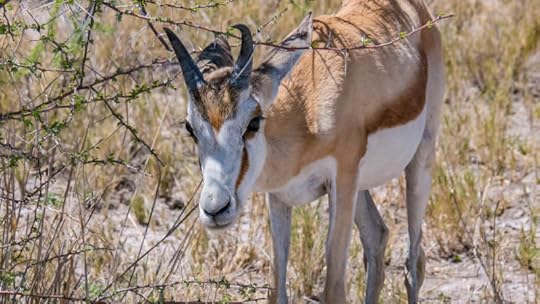
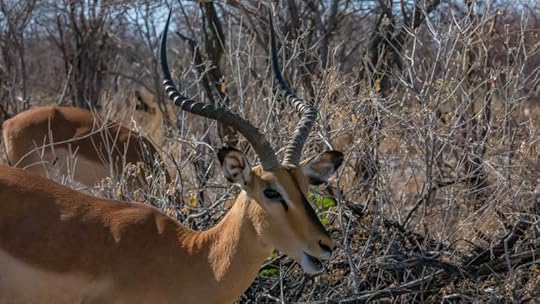
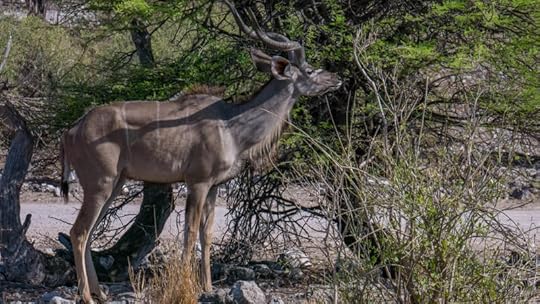
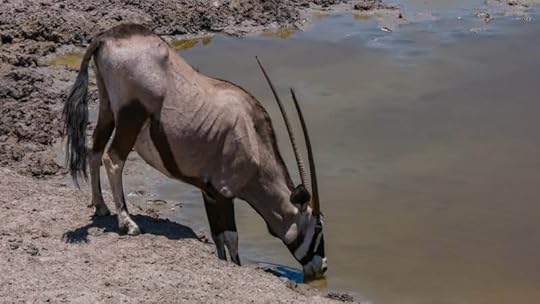
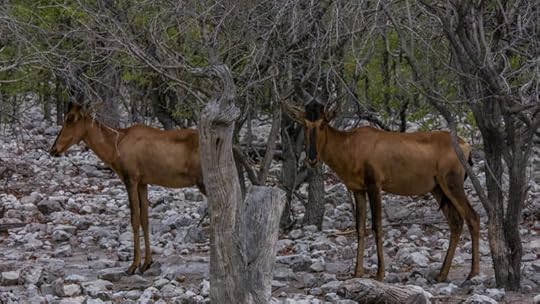
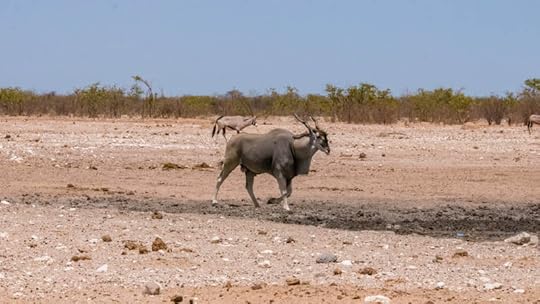 If you can't see the gallery above, click here.
If you can't see the gallery above, click here. 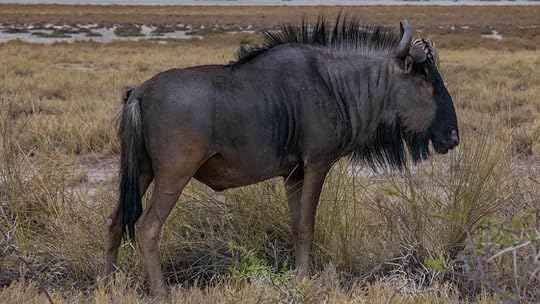 Wildebeest Other Herbavores
Wildebeest Other Herbavores 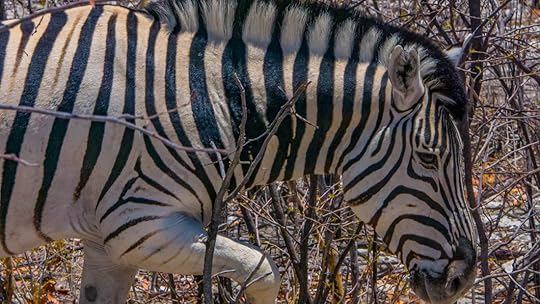 Zebras
Zebras 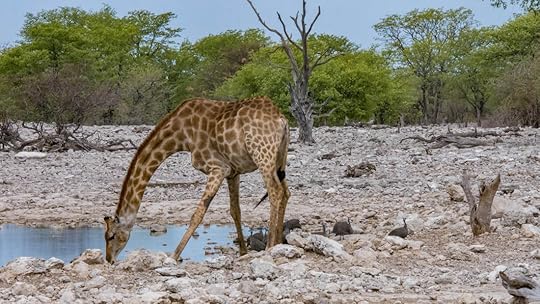 Giraffes
Giraffes 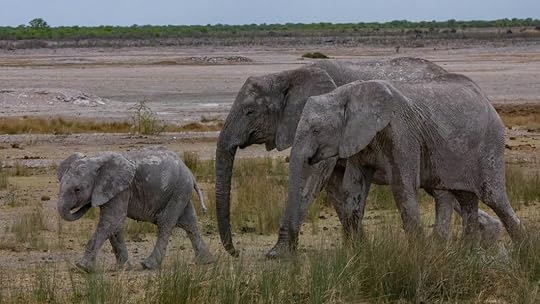 And of course elephants! Rhinos: Etosha is famous for having many rhinos, both black and white varieties (you can tell the difference by their nose shape, not color). They are somewhat elusive, and we didn't see any, though we met lots of people who did. Either you're lucky and one crosses the road in front of you, or the best way to see them is to stay at a camp at the park overnight and sit by the watering hole. Rhinos love to socialize around the watering hole at night, and rumor is the camp at Halali may offer your best chances of seeing them. Omnivores
And of course elephants! Rhinos: Etosha is famous for having many rhinos, both black and white varieties (you can tell the difference by their nose shape, not color). They are somewhat elusive, and we didn't see any, though we met lots of people who did. Either you're lucky and one crosses the road in front of you, or the best way to see them is to stay at a camp at the park overnight and sit by the watering hole. Rhinos love to socialize around the watering hole at night, and rumor is the camp at Halali may offer your best chances of seeing them. Omnivores 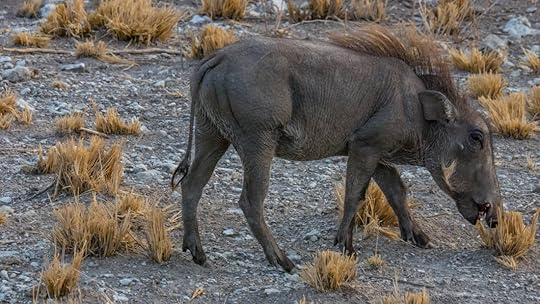 Warthogs
Warthogs 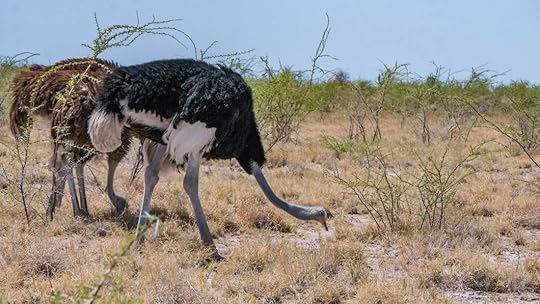 Ostriches Carnivores
Ostriches Carnivores 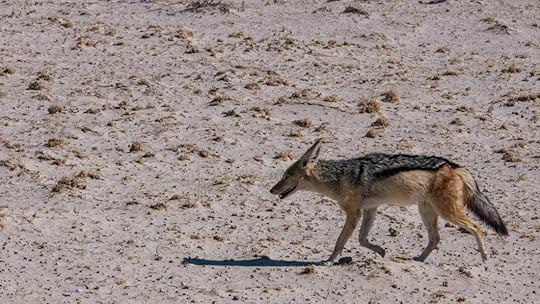 Black-Backed Jackal
Black-Backed Jackal 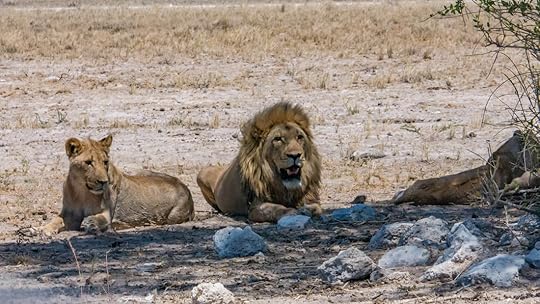 Lions
Lions 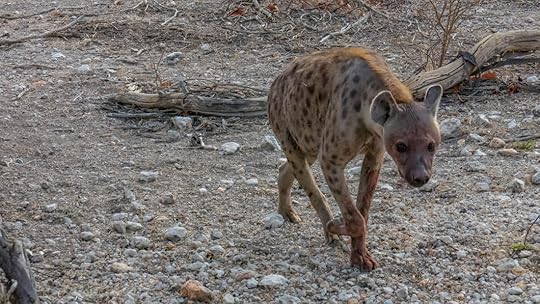 Hyenas There are also leopards and cheetahs at Etosha, but it's very rare to see them. To increase your chances, stay in the park overnight and watch the watering holes since leopards are mostly nocturnal. For cheetahs, I think you just have to be lucky.
Hyenas There are also leopards and cheetahs at Etosha, but it's very rare to see them. To increase your chances, stay in the park overnight and watch the watering holes since leopards are mostly nocturnal. For cheetahs, I think you just have to be lucky.
But you have a pretty good chance of seeing lions. We stayed three days, and after the first, we lost count of how many lions we'd seen. And once you figure out where they are on the first day, you can return to those same spots on the second and third day. Plus, the lions at Etosha are pretty used to big vehicles always around them, and they'll often just be hanging out right on the side of the road. It's very scary and surreal to be face to face with one staring right at you just meters away.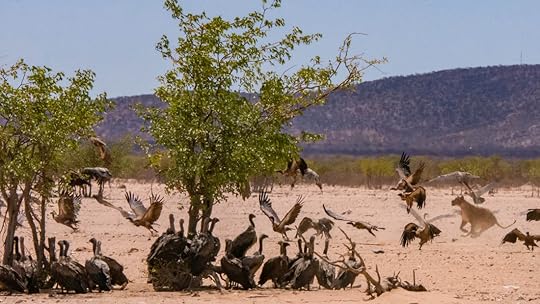 Once you see this, you can die happy. The Circle of Life When I was dreaming about going on a safari, mostly I just wanted to check off animals from my mental checklist, and take pictures of them to post on social media. But what surprised me was that once I got out there, I found the experience to be much deeper and more profound than that.
Once you see this, you can die happy. The Circle of Life When I was dreaming about going on a safari, mostly I just wanted to check off animals from my mental checklist, and take pictures of them to post on social media. But what surprised me was that once I got out there, I found the experience to be much deeper and more profound than that. 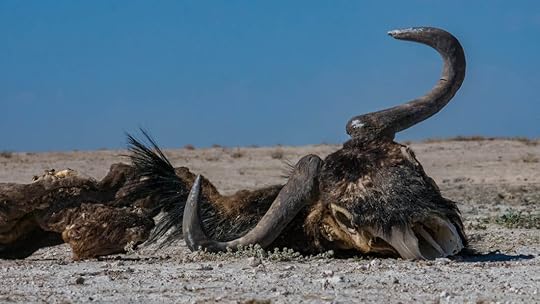 Because the wildlife at Etosha are all so concentrated together, we were immersed in both the beauty of life and the horror of death. And I realized that I felt passionately for both sides of the “war". I watched the little springboks cautiously take a drink, looking out for predators, and I admired the way they jumped and frolicked like innocent fawns from Fantasia.
Because the wildlife at Etosha are all so concentrated together, we were immersed in both the beauty of life and the horror of death. And I realized that I felt passionately for both sides of the “war". I watched the little springboks cautiously take a drink, looking out for predators, and I admired the way they jumped and frolicked like innocent fawns from Fantasia.
But then when I saw the lions with their adorable fuzzy cubs, I couldn't help but want to root for them also to get enough food to feed their young. It was like living inside a BBC David Attenborough nature documentary, and it was a real learning experience for me, showing me that within nature, good and evil are only a matter of perspective.
Safaris are perfect for all ages (except maybe babies). But if you have children, then what better way to spend your vacation time with them? Come to Namibia, and I promise your kids' eyes will widen with wonder and delight (and your eyes will too).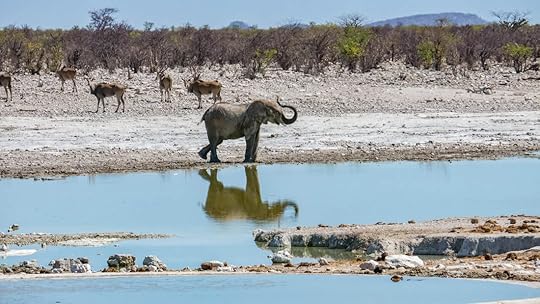 All in all, I feel deeply satisfied with my African safari, and the fact that I didn't break the bank to do it, is even better.
All in all, I feel deeply satisfied with my African safari, and the fact that I didn't break the bank to do it, is even better.
Next, Tim and I get back on our bike and head to Botswana! So stay tuned! Subscribe to Our Blog This week we'd like to thank Freida and Francis for being such wonderful hosts in Windhoek, Duard and Ruan for all your help with the bike, and Matt Wilks and Curt Ownby for supplying the stickers and photos we have for sale. Check them out! Notier's Frontiers Stickers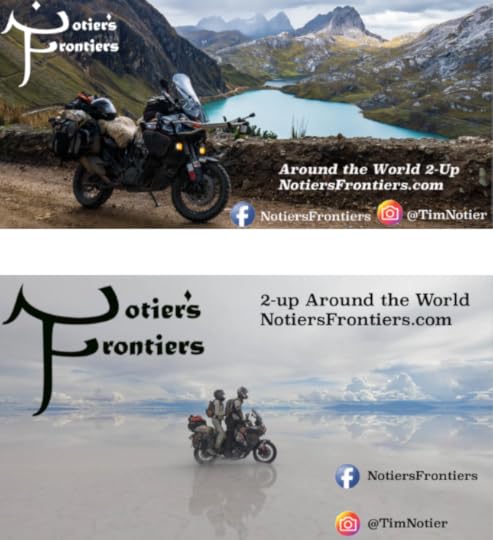 Photos for Sale
Photos for Sale 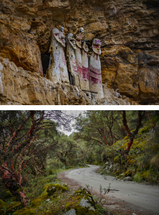
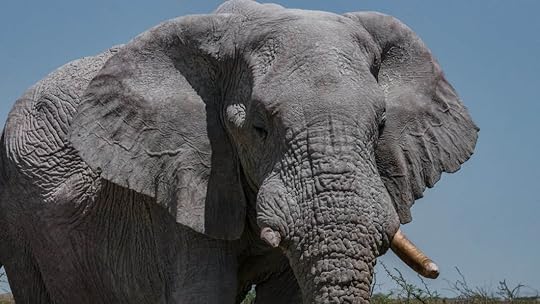
 Most people who visit Africa usually go on a safari. And there's nothing else on the planet like it: driving through the flat grasslands of thorny acacia trees, telling your fellow travelers to hush when you think you see something, and then whipping out your camera and holding your breath as a several-ton elephant lumbers out of the trees. It's the stuff of legends.
Most people who visit Africa usually go on a safari. And there's nothing else on the planet like it: driving through the flat grasslands of thorny acacia trees, telling your fellow travelers to hush when you think you see something, and then whipping out your camera and holding your breath as a several-ton elephant lumbers out of the trees. It's the stuff of legends.But there is a high price to be paid.
 This ferocious mama is not to be messed with. Excluding the cost of actually getting to and from the African country in which you want to safari, and then finding transport, food, and accommodation, even just the safari itself may cost you upwards of $1,000. Per person, per day, of course.
This ferocious mama is not to be messed with. Excluding the cost of actually getting to and from the African country in which you want to safari, and then finding transport, food, and accommodation, even just the safari itself may cost you upwards of $1,000. Per person, per day, of course.But there's a cheaper way: you can rent a car and do a self-drive tour through a place famous for its abundance of African wildlife: Etosha National Park in Namibia. You'll have control over everything, when you eat, where you go, how long you want to stay taking pictures of giraffes, and where you'll stay the night, all for a fraction of the cost.
4x4 Vehicle Rental (with rooftop tent): ~$100-$120 per day
Entrance to Etosha Park: $5.50 per person, per day
Camping within the park: $23 per person
Camping outside of the park: ~$15 per person
 We went in November, and there were lots of baby animals around. And if you really want to have the knowledge and expertise of a professional guide take you through the park, then you can simply join an Etosha game drive for around $50.
We went in November, and there were lots of baby animals around. And if you really want to have the knowledge and expertise of a professional guide take you through the park, then you can simply join an Etosha game drive for around $50.Much better than the thousands of dollars that you'll pay elsewhere. Step 1: Rent a Car in Windhoek
 Because our motorcycle was broken in Namibia and we had to wait for a part to arrive, we decided to rent a car and explore by 4WD in the meantime. This turned out not to be as damaging to our schedule as we thought, because most of Namibia's sites are not accessible by motorcycle, including Etosha National Park. So having a 4x4 vehicle is really the way to go.
Because our motorcycle was broken in Namibia and we had to wait for a part to arrive, we decided to rent a car and explore by 4WD in the meantime. This turned out not to be as damaging to our schedule as we thought, because most of Namibia's sites are not accessible by motorcycle, including Etosha National Park. So having a 4x4 vehicle is really the way to go.Windhoek is the capital city of Namibia, and is more or less in the middle of the country. That makes it fairly close to everything, and only a five-hour drive away from Etosha. So if you wanted to fly in, see the elephants for a couple days, and fly out, this could even be done in four days.
We rented our car for nine days, and this was enough time to see pretty much everything we wanted to see in the whole country, including the stunning red dunes of Sossuvlei, some beautiful mountain passes, fur seals on the skeleton coast, a visit to a Himba village, and three days in Etosha. Click here to see our itinerary.
 The beautiful Himba women of Namibia. If you have the time, three days in Etosha should be enough to have all your National Geographic dreams come true. And if you're lucky and see all your checklist animals on the first day, then you can use those extra days to relax by the pool, sleep in, or simply drive around to see it all again.
The beautiful Himba women of Namibia. If you have the time, three days in Etosha should be enough to have all your National Geographic dreams come true. And if you're lucky and see all your checklist animals on the first day, then you can use those extra days to relax by the pool, sleep in, or simply drive around to see it all again.But in the end, what you see on a safari is about luck. And if you don't see anything but giraffes and springbok on the first two days, then you might want to dish out the money for a game drive on the last. This will increase your chances of seeing wildlife because the drivers are in constant communication with each other throughout the park as to where the local lion prides are, for example. So it's pretty much a guarantee to see elephants and lions.
 How about lions and elephants in the same shot? Yes, it can happen. Make sure you rent your car from a reputable agency (we didn't, and were stressing out the whole time about whether we'd get our deposit back). Namibian roads are very corrugated, and are known to eat up tires, so make sure you have at least one full-sized spare with you and a policy that covers a flat. Many rental agencies will provide you with two spares, and also look into coverage for chips in the windshield and other dents from rocks being flown at you.
How about lions and elephants in the same shot? Yes, it can happen. Make sure you rent your car from a reputable agency (we didn't, and were stressing out the whole time about whether we'd get our deposit back). Namibian roads are very corrugated, and are known to eat up tires, so make sure you have at least one full-sized spare with you and a policy that covers a flat. Many rental agencies will provide you with two spares, and also look into coverage for chips in the windshield and other dents from rocks being flown at you.Most 4x4 rentals in Namibia will give you the option of having a rooftop tent. If you like to camp, this is definitely the cheapest (and in my opinion, most fun) way to go. Just make sure you zip up all of the netting since Etosha is in the malaria zone. Don't risk trading a cool breeze for a disease that may mess you up for a lot longer than an uncomfortably hot night. Step 2: Head to Etosha The thing about Etosha National Park which makes it so great for seeing wildlife is that unlike the Serengeti in Tanzania and Kenya, Kruger in South Africa, or the Okavango Delta in Botswana, Etosha is in a desert. That means that all the animals from the park must get their water needs at a watering hole, and lucky for us, they've built roads that lead directly to them. It's like driving up to The Lion King version of an outdoor theater at which you know the actors must show up.
The National Park opens from sunrise to sunset, and the only way to stay longer is to stay within the park at one of their campgrounds or lodges. Though it's more expensive than staying outside, this is recommended because they have floodlit waterholes there which certain more nocturnal animals frequent, such as rhinos and leopards.
 This is the eastern side of the park which is more popular with both animals and people. The park is broken up into two sections: the east that runs along the Etosha mud pan and has the most wildlife action, and the west which is more desolate, but also more intimate with less tour buses. You can find plenty of animals there too, but in general it's not as concentrated.
This is the eastern side of the park which is more popular with both animals and people. The park is broken up into two sections: the east that runs along the Etosha mud pan and has the most wildlife action, and the west which is more desolate, but also more intimate with less tour buses. You can find plenty of animals there too, but in general it's not as concentrated.From Windhoek, you will most likely enter Etosha at Anderson Gate leading to Okaukuejo, which is right in the middle of the park on its southern edge. At the gate you'll fill out some paperwork, then pay once you get to Okaukuejo camp, which is 15 minutes up a paved road (one of the only paved roads). I suggest you stock up on food and snacks from outside the park, because even though there are restaurants and stores within, they are expensive and sorely lacking.
 This is the western and less-frequented side of the park. Jakkalswater and Okawao are popular watering holes with wildlife. There are two other main camps on the eastern side: Halali, which is where you should stay if you want to see rhinos at night, and Namutoni on the eastern edge, which is atmospheric with its thatched huts. All three camps have petrol and supplies. A good plan of action would be to start early in the morning at Okaukuejo, and to try to stop at as many watering holes as you can on your way to Halali for a lunch break. Then you can continue going east and end up by Namutoni, or a campground outside of there for the night. The next day, do it all in reverse.
This is the western and less-frequented side of the park. Jakkalswater and Okawao are popular watering holes with wildlife. There are two other main camps on the eastern side: Halali, which is where you should stay if you want to see rhinos at night, and Namutoni on the eastern edge, which is atmospheric with its thatched huts. All three camps have petrol and supplies. A good plan of action would be to start early in the morning at Okaukuejo, and to try to stop at as many watering holes as you can on your way to Halali for a lunch break. Then you can continue going east and end up by Namutoni, or a campground outside of there for the night. The next day, do it all in reverse.Having a map of the park is important, along with downloading offline Google maps of the area since many of the concrete “signs" in the park are worn away. And don't forget to pull over and talk to other safari-goers while at the watering holes. You might get some inside scoops on where the lions have been keeping their cubs, and where the elephant herds were last headed.
 Kudus and Zebras. On the third day, either decide to hit up your favorite spots, or venture into the western side to have a more private experience without all the tour buses. There are two camps out there, Olifantsrus and Dolomite, but they're not nearly as well-equipped as the others. Plus, camping at Olifantsrus is more expensive than at the other camps for reasons I can't figure out, and you won't find gas at either.
Kudus and Zebras. On the third day, either decide to hit up your favorite spots, or venture into the western side to have a more private experience without all the tour buses. There are two camps out there, Olifantsrus and Dolomite, but they're not nearly as well-equipped as the others. Plus, camping at Olifantsrus is more expensive than at the other camps for reasons I can't figure out, and you won't find gas at either.Alternatively, if you've been having bad luck, use your last day to join a game drive and let the experts take you to where they know the animals to be. Step 3: Follow the Rules Do not get out of your car - This is for obvious reasons. You can have your windows down, but no sitting on top of your car or sticking your arms out, even if you think you don't see any animals around. There are fenced-in rest areas scattered throughout the park where you can get out. If you get a flat, call the park's offices or wave someone down who can call for assistance.Be quiet - When you pull up to an area with wildlife, it's common courtesy to shut off your engine. This will also shut off your air-conditioning, yes, I realize that's a problem, but it's better for the animals. Best thing is to roll down your windows and be a part of your surroundings.Leave room for others - Everyone wants to get that perfect picture of the baby elephant, so if you find yourself in that prime location, once you're done taking pictures, make sure you pull away to let someone else share in the view.
 It's not all about lions and elephants. This is a female Kudu with all her Avatar-like war paint on. Isn't she gorgeous? Step 4: Enjoy the Wildlife! Because it's a desert, you won't find water-loving animals such as hippos, water buffalo, and crocodiles at Etosha.
It's not all about lions and elephants. This is a female Kudu with all her Avatar-like war paint on. Isn't she gorgeous? Step 4: Enjoy the Wildlife! Because it's a desert, you won't find water-loving animals such as hippos, water buffalo, and crocodiles at Etosha.What you will see are antelope, zebras, giraffes, wildebeest, ostriches, warthogs, plus four of the “big five": elephants, lions, leopards, and rhino (no water buffalo).
To get a better idea of what you're looking at, here's a list starting at the bottom of the food chain: Antelope





 If you can't see the gallery above, click here.
If you can't see the gallery above, click here.  Wildebeest Other Herbavores
Wildebeest Other Herbavores  Zebras
Zebras  Giraffes
Giraffes  And of course elephants! Rhinos: Etosha is famous for having many rhinos, both black and white varieties (you can tell the difference by their nose shape, not color). They are somewhat elusive, and we didn't see any, though we met lots of people who did. Either you're lucky and one crosses the road in front of you, or the best way to see them is to stay at a camp at the park overnight and sit by the watering hole. Rhinos love to socialize around the watering hole at night, and rumor is the camp at Halali may offer your best chances of seeing them. Omnivores
And of course elephants! Rhinos: Etosha is famous for having many rhinos, both black and white varieties (you can tell the difference by their nose shape, not color). They are somewhat elusive, and we didn't see any, though we met lots of people who did. Either you're lucky and one crosses the road in front of you, or the best way to see them is to stay at a camp at the park overnight and sit by the watering hole. Rhinos love to socialize around the watering hole at night, and rumor is the camp at Halali may offer your best chances of seeing them. Omnivores  Warthogs
Warthogs  Ostriches Carnivores
Ostriches Carnivores  Black-Backed Jackal
Black-Backed Jackal  Lions
Lions  Hyenas There are also leopards and cheetahs at Etosha, but it's very rare to see them. To increase your chances, stay in the park overnight and watch the watering holes since leopards are mostly nocturnal. For cheetahs, I think you just have to be lucky.
Hyenas There are also leopards and cheetahs at Etosha, but it's very rare to see them. To increase your chances, stay in the park overnight and watch the watering holes since leopards are mostly nocturnal. For cheetahs, I think you just have to be lucky.But you have a pretty good chance of seeing lions. We stayed three days, and after the first, we lost count of how many lions we'd seen. And once you figure out where they are on the first day, you can return to those same spots on the second and third day. Plus, the lions at Etosha are pretty used to big vehicles always around them, and they'll often just be hanging out right on the side of the road. It's very scary and surreal to be face to face with one staring right at you just meters away.
 Once you see this, you can die happy. The Circle of Life When I was dreaming about going on a safari, mostly I just wanted to check off animals from my mental checklist, and take pictures of them to post on social media. But what surprised me was that once I got out there, I found the experience to be much deeper and more profound than that.
Once you see this, you can die happy. The Circle of Life When I was dreaming about going on a safari, mostly I just wanted to check off animals from my mental checklist, and take pictures of them to post on social media. But what surprised me was that once I got out there, I found the experience to be much deeper and more profound than that.  Because the wildlife at Etosha are all so concentrated together, we were immersed in both the beauty of life and the horror of death. And I realized that I felt passionately for both sides of the “war". I watched the little springboks cautiously take a drink, looking out for predators, and I admired the way they jumped and frolicked like innocent fawns from Fantasia.
Because the wildlife at Etosha are all so concentrated together, we were immersed in both the beauty of life and the horror of death. And I realized that I felt passionately for both sides of the “war". I watched the little springboks cautiously take a drink, looking out for predators, and I admired the way they jumped and frolicked like innocent fawns from Fantasia.But then when I saw the lions with their adorable fuzzy cubs, I couldn't help but want to root for them also to get enough food to feed their young. It was like living inside a BBC David Attenborough nature documentary, and it was a real learning experience for me, showing me that within nature, good and evil are only a matter of perspective.
Safaris are perfect for all ages (except maybe babies). But if you have children, then what better way to spend your vacation time with them? Come to Namibia, and I promise your kids' eyes will widen with wonder and delight (and your eyes will too).
 All in all, I feel deeply satisfied with my African safari, and the fact that I didn't break the bank to do it, is even better.
All in all, I feel deeply satisfied with my African safari, and the fact that I didn't break the bank to do it, is even better.Next, Tim and I get back on our bike and head to Botswana! So stay tuned! Subscribe to Our Blog This week we'd like to thank Freida and Francis for being such wonderful hosts in Windhoek, Duard and Ruan for all your help with the bike, and Matt Wilks and Curt Ownby for supplying the stickers and photos we have for sale. Check them out! Notier's Frontiers Stickers
 Photos for Sale
Photos for Sale 

Published on November 23, 2019 22:08
November 22, 2019
Namibia: Seals, Sea, and Sand
By Marisa 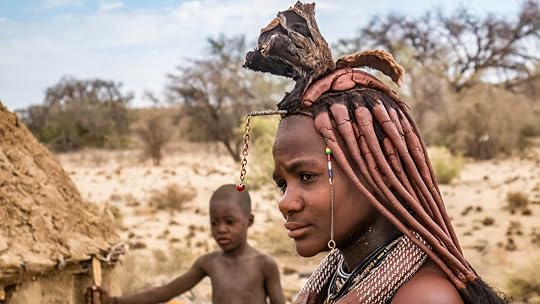 Among our Namibian adventures, we were fortunate enough to meet some of the Himba people. We were on our way to Namibia's famous red dunes at Sossusvlei when we took a nasty spill and broke our motorcycle's monoshock (rear suspension), which if you're unfamiliar with bike mechanics, is something that you can't just fix on the side of the road. So we had to tow our bike up to Namibia's capital city of Windhoek (which was quite an adventure in itself) and are still waiting for a new monoshock to be flown in from Austria.
Among our Namibian adventures, we were fortunate enough to meet some of the Himba people. We were on our way to Namibia's famous red dunes at Sossusvlei when we took a nasty spill and broke our motorcycle's monoshock (rear suspension), which if you're unfamiliar with bike mechanics, is something that you can't just fix on the side of the road. So we had to tow our bike up to Namibia's capital city of Windhoek (which was quite an adventure in itself) and are still waiting for a new monoshock to be flown in from Austria.
While we're waiting, we decided to rent a car here in Namibia to explore this beautiful country. And what a trip it's been!
It turns out that going by 4x4 is the way to see Namibia since most of the country's sights prohibit motorcycles to enter. This is due to a number of reasons (such as lions could chase you, a valid reason I suppose), so in order to see things, we would have had to either join a tour group or rent a car anyway. Even the place we were headed to when we had our accident, Sossusvlei, doesn't allow motorcycles in, it turns out. Maybe this broken monoshock was a blessing in disguise.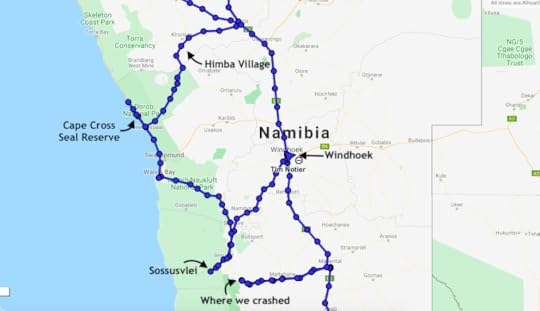 We started in the capital city of Windhoek (said like VIND-hook, it's a German word since Namibia used to be a German colony), and our first destination was to conquer those wretched sand dunes that we had wanted to see when we first broke down: Sossusvlei.
We started in the capital city of Windhoek (said like VIND-hook, it's a German word since Namibia used to be a German colony), and our first destination was to conquer those wretched sand dunes that we had wanted to see when we first broke down: Sossusvlei.
The name means “Dead-End Marsh", and if you look at an aerial image of Sossusvlei, you can see why. All along Namibia's Atlantic coast is an expanse of red sand dunes, and that is the Namib Desert. But then there is an area cutting into it where an ancient river once tried to push its way through the sand. That's Sossusvlei, and sometimes when it does rain, water still flows through that corridor, only to peter out at the end in a marshy pan of soaked sand. When it's not raining (most of the time as you can imagine), this area is a perfect peninsula of hard land sticking into the sea of sand, so you can drive into it and get up-close to the impressive dunes.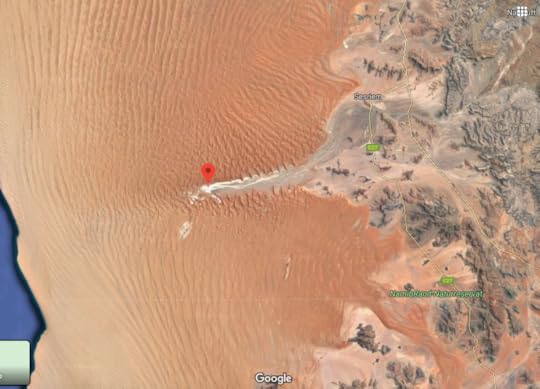 Here you can see the valley of Sossusvlei cutting into Namibia's "Sea of Sand". And when I say impressive dunes, I mean some of the largest sand dunes on earth. Not only is the Namib desert the world's oldest desert, and the red rusty color of the sand makes for incredible pictures, but because of the cross-winds keeping the dunes stable, the sand takes on gorgeous shapes as it piles up to towering heights. Big Daddy is the name of the largest dune of Sossusvlei, and at 325 meters high (that's 1,066 feet!), climbing up this dune takes many strenuous hours.
Here you can see the valley of Sossusvlei cutting into Namibia's "Sea of Sand". And when I say impressive dunes, I mean some of the largest sand dunes on earth. Not only is the Namib desert the world's oldest desert, and the red rusty color of the sand makes for incredible pictures, but because of the cross-winds keeping the dunes stable, the sand takes on gorgeous shapes as it piles up to towering heights. Big Daddy is the name of the largest dune of Sossusvlei, and at 325 meters high (that's 1,066 feet!), climbing up this dune takes many strenuous hours.
That was not something that really appealed to us, but we did climb a much smaller, yet still big sand dune with a much more boring name: Dune 40.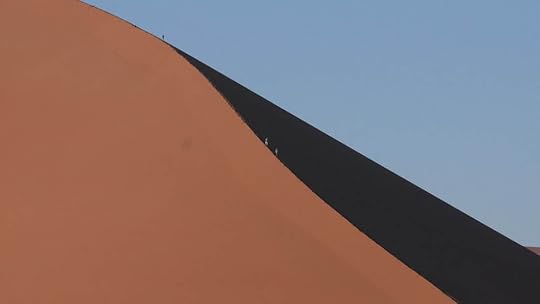 The people scaling this dune look miniscule. The key is to get to the dunes early, right at sunrise when the sand is fiery red in the slanted sunlight but icy cool to the touch (by 10:00 AM it's scorching, so hot you can't climb the dune without wearing boots). While we climbed, one side of Dune 40 looked glittering and velvety smooth in the sun, while the other side was still obscured in shadow. After only about a half hour of trudging, we reached the top, and at the crest of it there was this perfect sweeping line where the bright desert sun met the darkness of night. It was stunning, and well worth the effort of getting up there.
The people scaling this dune look miniscule. The key is to get to the dunes early, right at sunrise when the sand is fiery red in the slanted sunlight but icy cool to the touch (by 10:00 AM it's scorching, so hot you can't climb the dune without wearing boots). While we climbed, one side of Dune 40 looked glittering and velvety smooth in the sun, while the other side was still obscured in shadow. After only about a half hour of trudging, we reached the top, and at the crest of it there was this perfect sweeping line where the bright desert sun met the darkness of night. It was stunning, and well worth the effort of getting up there. 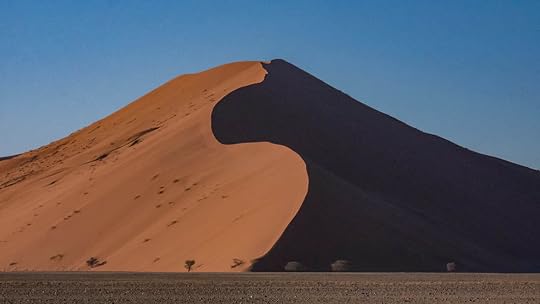 The gorgeous shapes and colors of Sossusvlei, Namibia.
The gorgeous shapes and colors of Sossusvlei, Namibia. 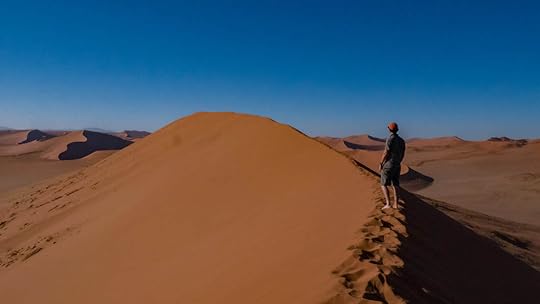 Tim walking along the edge of Dune 40, Sussusvlei, Namibia. A Sea of Sand is the perfect description for the Namib desert, and you would think there'd be nothing else out here, but amazingly, we saw quite a bit of life amidst the dunes. Little lizards, beetles, and all types of birds had made their way to Sossusvlei, but what was most surprising was to see giant Oryx antelope hanging out. They're gorgeous: with two huge straight horns coming out of their skulls in a massive V, ridged to mark their age like the rings of a tree, and black and white paint on their faces like they're going out for the Day of the Dead. What they ate out there, I have no idea, but the Oryx (Gemsbok in Afrikaans) are particularly adapted to life in the desert, and in fact, they prefer it.
Tim walking along the edge of Dune 40, Sussusvlei, Namibia. A Sea of Sand is the perfect description for the Namib desert, and you would think there'd be nothing else out here, but amazingly, we saw quite a bit of life amidst the dunes. Little lizards, beetles, and all types of birds had made their way to Sossusvlei, but what was most surprising was to see giant Oryx antelope hanging out. They're gorgeous: with two huge straight horns coming out of their skulls in a massive V, ridged to mark their age like the rings of a tree, and black and white paint on their faces like they're going out for the Day of the Dead. What they ate out there, I have no idea, but the Oryx (Gemsbok in Afrikaans) are particularly adapted to life in the desert, and in fact, they prefer it. 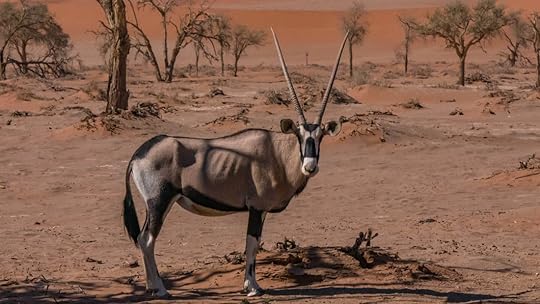 The beautiful Oryx of the Namib Desert.
The beautiful Oryx of the Namib Desert. 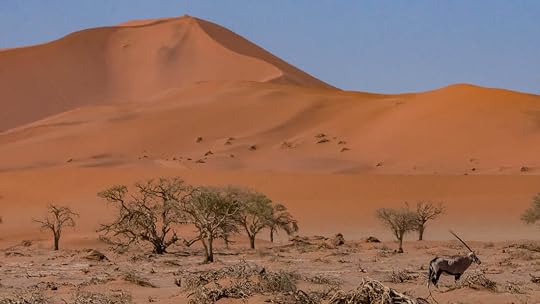 Picture-perfect Sossusvlei, Namibia. Nearby to the dunes is a narrow canyon called Sesriem Canyon. Now that the sun was overhead, it was a nice respite from the desert heat down in the canyon, and made for a pleasant hike.
Picture-perfect Sossusvlei, Namibia. Nearby to the dunes is a narrow canyon called Sesriem Canyon. Now that the sun was overhead, it was a nice respite from the desert heat down in the canyon, and made for a pleasant hike. 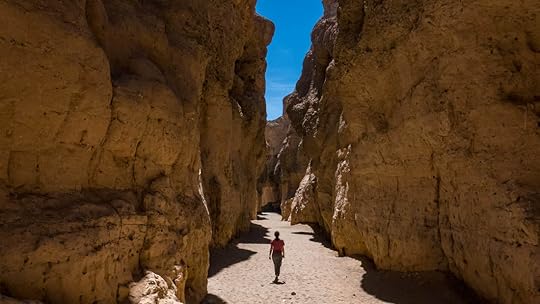 Me walking through Sesriem Canyon, Namibia. After all the dust and dryness of Sossusvlei, we headed to the Atlantic coast to freshen up with some cool ocean breezes.
Me walking through Sesriem Canyon, Namibia. After all the dust and dryness of Sossusvlei, we headed to the Atlantic coast to freshen up with some cool ocean breezes.
We had rented a car from a local taxi company in Windhoek instead of a name brand rental agency because it was a good deal, but we definitely got what we paid for. The air conditioning was broken and would only blow on our feet, so we had to constantly keep the windows open so that we didn't roast alive in there.
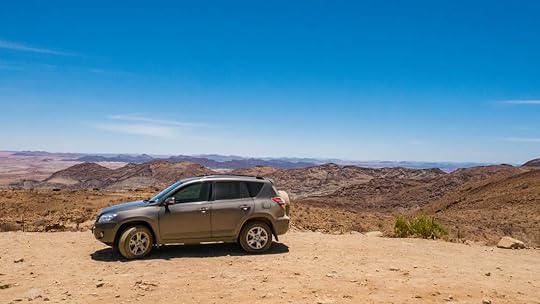 Our rental car, a Toyota Rav4 in front of Spreetshoogte Pass, Namibia. This made things dusty, very dusty. The road from Sossusvlei to Walvis Bay, although beautiful as it went over Kuiseb Pass, was not a good road. It was corrugated, rippled like a perfect washboard that jostled us around continuously for four hours straight.
Our rental car, a Toyota Rav4 in front of Spreetshoogte Pass, Namibia. This made things dusty, very dusty. The road from Sossusvlei to Walvis Bay, although beautiful as it went over Kuiseb Pass, was not a good road. It was corrugated, rippled like a perfect washboard that jostled us around continuously for four hours straight. 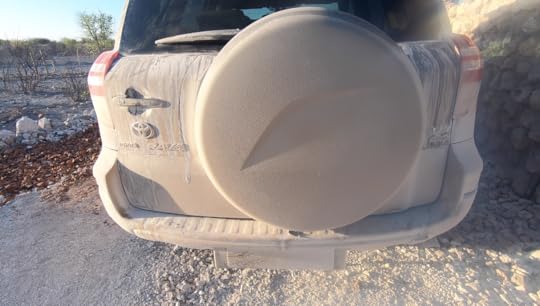 Where did our license plate go? Blown out tires were strewn across the side of the road like it was a rubber graveyard. We passed several people with flats who were cranking their jacks and turning their lug wrenches. And we should have taken warning, because on one of those long desolate stretches, suddenly we could feel the car bottom out, and knew we had a flat.
Where did our license plate go? Blown out tires were strewn across the side of the road like it was a rubber graveyard. We passed several people with flats who were cranking their jacks and turning their lug wrenches. And we should have taken warning, because on one of those long desolate stretches, suddenly we could feel the car bottom out, and knew we had a flat. 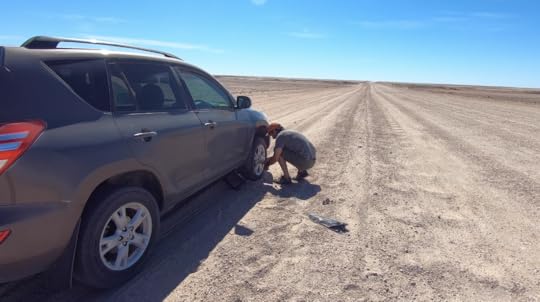 A flat tire in the middle of nowhere... But this is normal for Namibia, and simply a part of life out here. Everyone gets flats, that's just the way the roads are. All vehicles come with full spares, many with two, and most car rentals insure you up to two flats because they know it's bound to happen. Since we'd gone cheap, we told our rental/cab company that we'd pay for all damages, and ended up dishing out a bit of money for this flat. But in the end we were lucky to only have one. We met a guy who had rented a 4x4 and was on his fifth new tire.
A flat tire in the middle of nowhere... But this is normal for Namibia, and simply a part of life out here. Everyone gets flats, that's just the way the roads are. All vehicles come with full spares, many with two, and most car rentals insure you up to two flats because they know it's bound to happen. Since we'd gone cheap, we told our rental/cab company that we'd pay for all damages, and ended up dishing out a bit of money for this flat. But in the end we were lucky to only have one. We met a guy who had rented a 4x4 and was on his fifth new tire.
At Walvis Bay, and all along the Namibian coast, the sand dunes meet the sea in a cloud of mist. You might think that sand and sea go together to make a perfect beach scene, and normally they do. But these massive Sahara-like sand dunes emptying into a frigid, almost antarctic Atlantic waters make for a very bizarre, foreboding scene.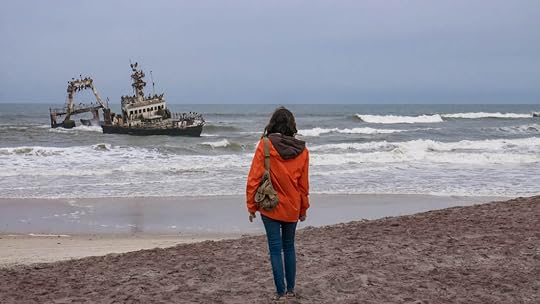 One of the many shipwrecks along Namibia's Atlantic coast. Here, a thick fog of clouds constantly hover over the shoreline, and the condensation it creates is the only source of water for any wildlife that dare to live here. North of Walvis Bay, we drove along this barren, dreary scene to what is known as the Skeleton Coast. This is because any sailors who had the misfortune of shipwrecking here were immediately doomed. If it was not the storms of the sea that killed them, they would be greeted by a wasteland of sand dunes once reaching land. Nowhere to go, nothing to drink, the skeletons of both men and shipwrecks can be found across the landscape.
One of the many shipwrecks along Namibia's Atlantic coast. Here, a thick fog of clouds constantly hover over the shoreline, and the condensation it creates is the only source of water for any wildlife that dare to live here. North of Walvis Bay, we drove along this barren, dreary scene to what is known as the Skeleton Coast. This is because any sailors who had the misfortune of shipwrecking here were immediately doomed. If it was not the storms of the sea that killed them, they would be greeted by a wasteland of sand dunes once reaching land. Nowhere to go, nothing to drink, the skeletons of both men and shipwrecks can be found across the landscape. 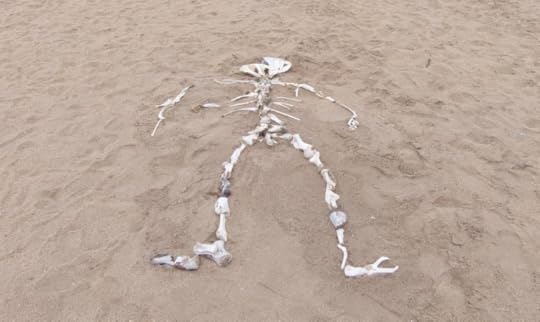 I'm hoping this is simply a well-arranged grouping of cow bones? But then amidst all the desolation of the Skeleton Coast, suddenly we came to the Cape Cross Seal Reserve, and found ourselves immersed in a loud cacophony of wriggling creatures all chatting and arguing with each other, like a Venice Beach for seals.
I'm hoping this is simply a well-arranged grouping of cow bones? But then amidst all the desolation of the Skeleton Coast, suddenly we came to the Cape Cross Seal Reserve, and found ourselves immersed in a loud cacophony of wriggling creatures all chatting and arguing with each other, like a Venice Beach for seals. 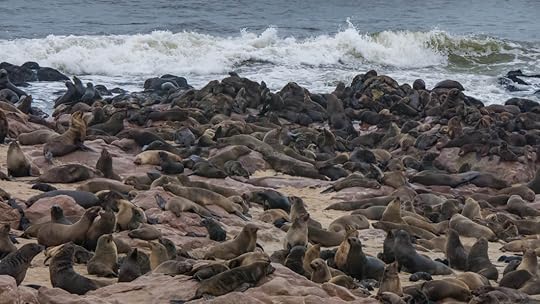 The mass collection of Brown Fur Seals at Cape Cross, Namibia. Visiting this Brown Fur Seal colony was perhaps one of my favorite things I've done on my travels. It was just so jarring and fascinating. The intoxicating odor of them all (and I mean that in the worst way possible, because they stank like fish rotting in a decaying corpse), and their strange noises, like Wookies and children and grunting bears all together, it made me feel like I had walked into that bar in the original Star Wars and was suddenly surrounded by alien species.
The mass collection of Brown Fur Seals at Cape Cross, Namibia. Visiting this Brown Fur Seal colony was perhaps one of my favorite things I've done on my travels. It was just so jarring and fascinating. The intoxicating odor of them all (and I mean that in the worst way possible, because they stank like fish rotting in a decaying corpse), and their strange noises, like Wookies and children and grunting bears all together, it made me feel like I had walked into that bar in the original Star Wars and was suddenly surrounded by alien species. 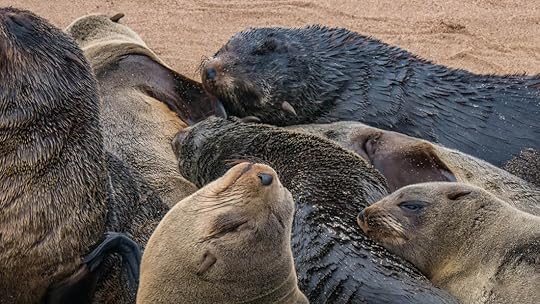 This was a fairly peaceful group amidst the seal chaos at the colony.
This was a fairly peaceful group amidst the seal chaos at the colony. 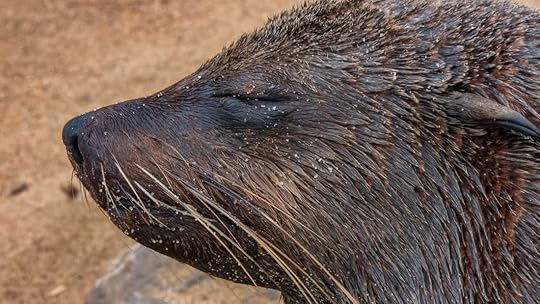 Apparently Brown Fur Seals are not true seals because they have ears. Though it looked like some were trying to take a nap or quietly nurse their young, others were loudly complaining as they slopped their way around, pushing whoever was in their way, or completely walking over each other with flippers in faces. And still others were arguing, growling at each other and snapping like dogs.
Apparently Brown Fur Seals are not true seals because they have ears. Though it looked like some were trying to take a nap or quietly nurse their young, others were loudly complaining as they slopped their way around, pushing whoever was in their way, or completely walking over each other with flippers in faces. And still others were arguing, growling at each other and snapping like dogs.
The wooden walkways at Cape Cross didn't go into the seal colony as much as the seal colony had taken over the walkways. You could see that there had once been an attempt at building a roofed picnic area there, but the seals now completely owned that space and there was no taking it back. I was definitely in their world now, and was very thankful for the wooden bars that barely separated us, because some of those seals were absolutely huge with a mouth full of bloody fangs. Fish carcasses and strewn-apart entrails were everywhere, and you could see that sometimes the blood on their mouths was not just from having dinner, but from attacking each other.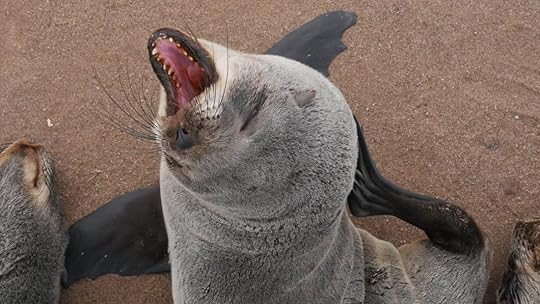 It's amazing how similar to dogs their muzzles look. And check out the nails on its flipper. After the seal colony, it took a few hours to get the putrid smell out of our noses as we headed inland, back to where the sun beat down on the rocks, and dust filled our car and clothes. That evening, as we camped in a town that hadn't seen rain in eight years (Uis), I realized that my hair smelled like it was burnt. Straw-like and crispy dry to the touch, both of us had hair that now appeared streaked in grey, though it was just dust and sand. Even a good shower didn't fix it.
It's amazing how similar to dogs their muzzles look. And check out the nails on its flipper. After the seal colony, it took a few hours to get the putrid smell out of our noses as we headed inland, back to where the sun beat down on the rocks, and dust filled our car and clothes. That evening, as we camped in a town that hadn't seen rain in eight years (Uis), I realized that my hair smelled like it was burnt. Straw-like and crispy dry to the touch, both of us had hair that now appeared streaked in grey, though it was just dust and sand. Even a good shower didn't fix it.
Our final adventure in Namibia with our rental car was going to be Etosha National Park, a safari paradise of lions, elephants, rhinos, and giraffes. That will all be for my next blog post, part two of our rental car excursion, but on our way there, we had another Namibian surprise in store for us: the Himba.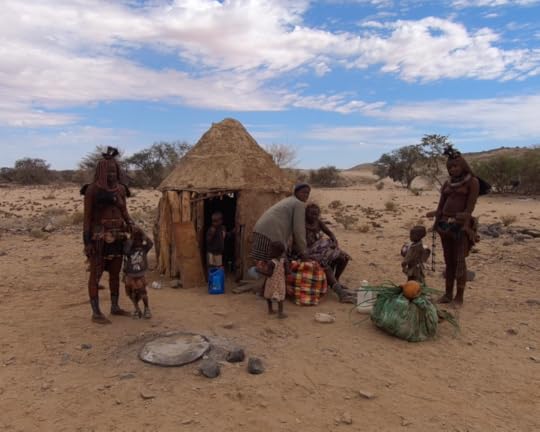 Women in front of a traditional house of the Himba village. The Himba people are an indigenous group of semi-nomadic Namibians who call the northern reaches their home. But what makes these people so iconic is the way the women cover their bodies with red ochre butter, and use this ochre mud to make long dreads in their hair. Decorated from head to toe in beads and hides, these bare-breasted women are a beautiful sight to behold.
Women in front of a traditional house of the Himba village. The Himba people are an indigenous group of semi-nomadic Namibians who call the northern reaches their home. But what makes these people so iconic is the way the women cover their bodies with red ochre butter, and use this ochre mud to make long dreads in their hair. Decorated from head to toe in beads and hides, these bare-breasted women are a beautiful sight to behold. 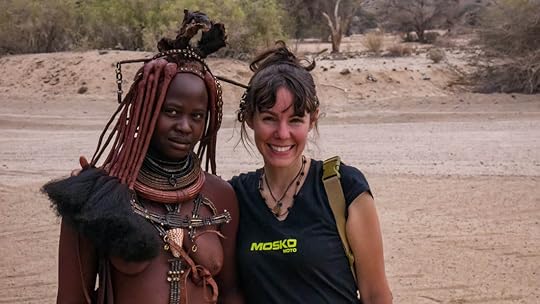 These days, the Himba women put fake hair extensions into their hair and spend time every day brushing it into poofy pom-poms at the ends. Unfortunately, their traditional way of life is disappearing. For the past eight years Namibia has been in a severe drought, which has forced many of the Himba to give up grazing their traditional lands. Now you can see them oftentimes camped along the side of the road, as they use money from tourists and the bartering of goods to support themselves. So as we made our way from Uis to Etosha, we saw a tiny village of mud huts along the road and a little market of trinkets set up, and decided to stop and pay for a tour.
These days, the Himba women put fake hair extensions into their hair and spend time every day brushing it into poofy pom-poms at the ends. Unfortunately, their traditional way of life is disappearing. For the past eight years Namibia has been in a severe drought, which has forced many of the Himba to give up grazing their traditional lands. Now you can see them oftentimes camped along the side of the road, as they use money from tourists and the bartering of goods to support themselves. So as we made our way from Uis to Etosha, we saw a tiny village of mud huts along the road and a little market of trinkets set up, and decided to stop and pay for a tour.
This was both fascinating and awkward. Our tour guide was a man from the village who spoke English (along with five other languages), and he took us around, showing us how the village was organized with a sacred fire in the central space, and how women dressed with cow or goat hide skirts and headdresses. We also got to see how the women used incense to “bathe", as they actually never take a bath, and simply reapply the ochre butter mixture on their skin every day, and then waft themselves with smoke.
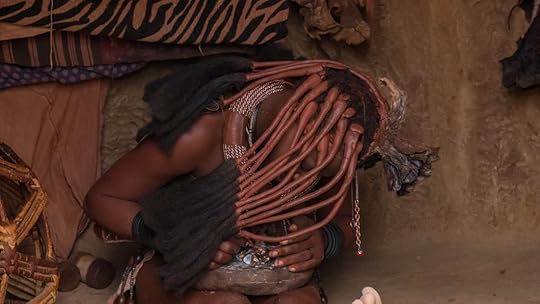 This is how the Himba women "bathe" themselves in smoke, by sitting over the incense and letting the heat of it open up their pores. They do this daily, and it's said to have started in order to conserve water.
This is how the Himba women "bathe" themselves in smoke, by sitting over the incense and letting the heat of it open up their pores. They do this daily, and it's said to have started in order to conserve water. 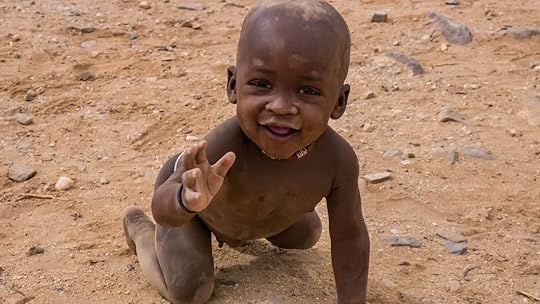 This little guy was too cute. The children were adorable, but I felt uneasy about being presented with women as if they were a circus attraction, and the fact that they rarely smiled or looked happy about us being there made it worse. Plus, paying to take pictures of half-naked women just seemed like something I never thought I would find myself doing.
This little guy was too cute. The children were adorable, but I felt uneasy about being presented with women as if they were a circus attraction, and the fact that they rarely smiled or looked happy about us being there made it worse. Plus, paying to take pictures of half-naked women just seemed like something I never thought I would find myself doing.
They weren't all half-naked though. Some women dressed in what they called “Victorian" garb, which was their interpretation of the dresses European settlers had encouraged them to wear in the 1800's. But with very bright colors and really cool hats that were built to be supportive for carrying things on their heads, you could tell that they had taken the designs and made it their own.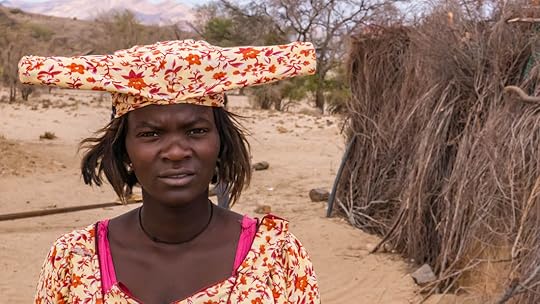 This is a woman in "Victorian" dress which includes a super awesome hat. We were just about done with our tour and feeling satisfied with our glimpse into this new and different culture when the guide asked us to do him a favor, (and no, it wasn't for dirt on Joe Biden). We had told him where we were headed and he said, “There's a woman here with a month-old baby, and she wants to go to the Himba village outside Etosha Park. Could you bring her there?"
This is a woman in "Victorian" dress which includes a super awesome hat. We were just about done with our tour and feeling satisfied with our glimpse into this new and different culture when the guide asked us to do him a favor, (and no, it wasn't for dirt on Joe Biden). We had told him where we were headed and he said, “There's a woman here with a month-old baby, and she wants to go to the Himba village outside Etosha Park. Could you bring her there?"
We were shocked. Yes, we were going there, but that was three-and-a-half hours away, and this woman couldn't speak English, and she was covered in red mud and we were in a rental car, and she didn't have a shirt on... but hey, why not?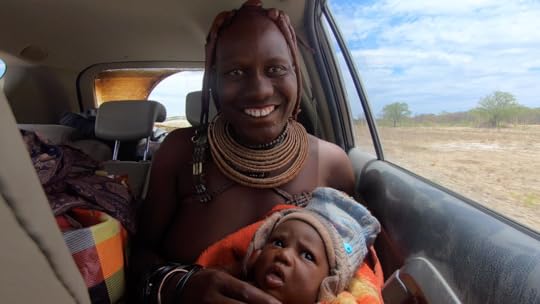 We had some super special passengers in our car that day. And so this became the authentic Himba experience that I was looking for. Despite having little to no English, this woman was full of smiles and her baby was adorable (with a very very long name that I could not remember), and she smelled like a mixture of incense and body odor. But truth be told, she probably smelled better than me at that moment. And with some blankets put over the seats so that she didn't get red everywhere, we had an enjoyable time listening to the Namibian CD that was left in the car by the taxi company, and waving to the other Himba people that we passed. I just felt bad that our air-conditioning didn't work and the car was super dusty, but she was probably very used to heat and dust.
We had some super special passengers in our car that day. And so this became the authentic Himba experience that I was looking for. Despite having little to no English, this woman was full of smiles and her baby was adorable (with a very very long name that I could not remember), and she smelled like a mixture of incense and body odor. But truth be told, she probably smelled better than me at that moment. And with some blankets put over the seats so that she didn't get red everywhere, we had an enjoyable time listening to the Namibian CD that was left in the car by the taxi company, and waving to the other Himba people that we passed. I just felt bad that our air-conditioning didn't work and the car was super dusty, but she was probably very used to heat and dust.
When we arrived at Etosha, we dropped her off with her bags of ground corn flour and basket-weaving materials, and waved goodbye to our new friend.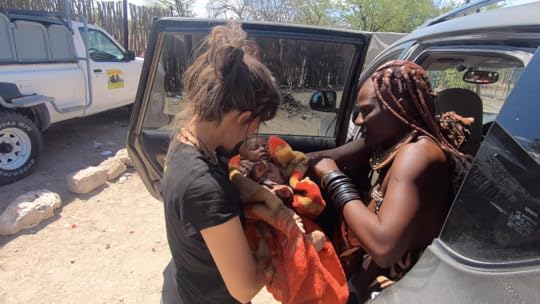 This moment was more intimate and special to me than any Himba tour could have been. In the end, as much as we love traveling on our motorcycle, going to Sossusvlei, the Cape Cross Seal Reserve, and transporting a Himba woman to another village all would not have been possible on our bike. So I was becoming very thankful for our rental car, and the best was still to come: our self-drive safari in Etosha National Park!
This moment was more intimate and special to me than any Himba tour could have been. In the end, as much as we love traveling on our motorcycle, going to Sossusvlei, the Cape Cross Seal Reserve, and transporting a Himba woman to another village all would not have been possible on our bike. So I was becoming very thankful for our rental car, and the best was still to come: our self-drive safari in Etosha National Park!
So stay tuned until next time! Subscribe to Our Blog Bonus news!
Tim is almost finished with his second book: Two-Up and Overloaded. It will cover our first year of travel from Chicago to Panama.
If you haven't done so already, take a look at his first book Maiden Voyage to get to know the who, what, and why that inspired us to be on the trip we are currently on.
 Among our Namibian adventures, we were fortunate enough to meet some of the Himba people. We were on our way to Namibia's famous red dunes at Sossusvlei when we took a nasty spill and broke our motorcycle's monoshock (rear suspension), which if you're unfamiliar with bike mechanics, is something that you can't just fix on the side of the road. So we had to tow our bike up to Namibia's capital city of Windhoek (which was quite an adventure in itself) and are still waiting for a new monoshock to be flown in from Austria.
Among our Namibian adventures, we were fortunate enough to meet some of the Himba people. We were on our way to Namibia's famous red dunes at Sossusvlei when we took a nasty spill and broke our motorcycle's monoshock (rear suspension), which if you're unfamiliar with bike mechanics, is something that you can't just fix on the side of the road. So we had to tow our bike up to Namibia's capital city of Windhoek (which was quite an adventure in itself) and are still waiting for a new monoshock to be flown in from Austria.While we're waiting, we decided to rent a car here in Namibia to explore this beautiful country. And what a trip it's been!
It turns out that going by 4x4 is the way to see Namibia since most of the country's sights prohibit motorcycles to enter. This is due to a number of reasons (such as lions could chase you, a valid reason I suppose), so in order to see things, we would have had to either join a tour group or rent a car anyway. Even the place we were headed to when we had our accident, Sossusvlei, doesn't allow motorcycles in, it turns out. Maybe this broken monoshock was a blessing in disguise.
 We started in the capital city of Windhoek (said like VIND-hook, it's a German word since Namibia used to be a German colony), and our first destination was to conquer those wretched sand dunes that we had wanted to see when we first broke down: Sossusvlei.
We started in the capital city of Windhoek (said like VIND-hook, it's a German word since Namibia used to be a German colony), and our first destination was to conquer those wretched sand dunes that we had wanted to see when we first broke down: Sossusvlei.The name means “Dead-End Marsh", and if you look at an aerial image of Sossusvlei, you can see why. All along Namibia's Atlantic coast is an expanse of red sand dunes, and that is the Namib Desert. But then there is an area cutting into it where an ancient river once tried to push its way through the sand. That's Sossusvlei, and sometimes when it does rain, water still flows through that corridor, only to peter out at the end in a marshy pan of soaked sand. When it's not raining (most of the time as you can imagine), this area is a perfect peninsula of hard land sticking into the sea of sand, so you can drive into it and get up-close to the impressive dunes.
 Here you can see the valley of Sossusvlei cutting into Namibia's "Sea of Sand". And when I say impressive dunes, I mean some of the largest sand dunes on earth. Not only is the Namib desert the world's oldest desert, and the red rusty color of the sand makes for incredible pictures, but because of the cross-winds keeping the dunes stable, the sand takes on gorgeous shapes as it piles up to towering heights. Big Daddy is the name of the largest dune of Sossusvlei, and at 325 meters high (that's 1,066 feet!), climbing up this dune takes many strenuous hours.
Here you can see the valley of Sossusvlei cutting into Namibia's "Sea of Sand". And when I say impressive dunes, I mean some of the largest sand dunes on earth. Not only is the Namib desert the world's oldest desert, and the red rusty color of the sand makes for incredible pictures, but because of the cross-winds keeping the dunes stable, the sand takes on gorgeous shapes as it piles up to towering heights. Big Daddy is the name of the largest dune of Sossusvlei, and at 325 meters high (that's 1,066 feet!), climbing up this dune takes many strenuous hours.That was not something that really appealed to us, but we did climb a much smaller, yet still big sand dune with a much more boring name: Dune 40.
 The people scaling this dune look miniscule. The key is to get to the dunes early, right at sunrise when the sand is fiery red in the slanted sunlight but icy cool to the touch (by 10:00 AM it's scorching, so hot you can't climb the dune without wearing boots). While we climbed, one side of Dune 40 looked glittering and velvety smooth in the sun, while the other side was still obscured in shadow. After only about a half hour of trudging, we reached the top, and at the crest of it there was this perfect sweeping line where the bright desert sun met the darkness of night. It was stunning, and well worth the effort of getting up there.
The people scaling this dune look miniscule. The key is to get to the dunes early, right at sunrise when the sand is fiery red in the slanted sunlight but icy cool to the touch (by 10:00 AM it's scorching, so hot you can't climb the dune without wearing boots). While we climbed, one side of Dune 40 looked glittering and velvety smooth in the sun, while the other side was still obscured in shadow. After only about a half hour of trudging, we reached the top, and at the crest of it there was this perfect sweeping line where the bright desert sun met the darkness of night. It was stunning, and well worth the effort of getting up there.  The gorgeous shapes and colors of Sossusvlei, Namibia.
The gorgeous shapes and colors of Sossusvlei, Namibia.  Tim walking along the edge of Dune 40, Sussusvlei, Namibia. A Sea of Sand is the perfect description for the Namib desert, and you would think there'd be nothing else out here, but amazingly, we saw quite a bit of life amidst the dunes. Little lizards, beetles, and all types of birds had made their way to Sossusvlei, but what was most surprising was to see giant Oryx antelope hanging out. They're gorgeous: with two huge straight horns coming out of their skulls in a massive V, ridged to mark their age like the rings of a tree, and black and white paint on their faces like they're going out for the Day of the Dead. What they ate out there, I have no idea, but the Oryx (Gemsbok in Afrikaans) are particularly adapted to life in the desert, and in fact, they prefer it.
Tim walking along the edge of Dune 40, Sussusvlei, Namibia. A Sea of Sand is the perfect description for the Namib desert, and you would think there'd be nothing else out here, but amazingly, we saw quite a bit of life amidst the dunes. Little lizards, beetles, and all types of birds had made their way to Sossusvlei, but what was most surprising was to see giant Oryx antelope hanging out. They're gorgeous: with two huge straight horns coming out of their skulls in a massive V, ridged to mark their age like the rings of a tree, and black and white paint on their faces like they're going out for the Day of the Dead. What they ate out there, I have no idea, but the Oryx (Gemsbok in Afrikaans) are particularly adapted to life in the desert, and in fact, they prefer it.  The beautiful Oryx of the Namib Desert.
The beautiful Oryx of the Namib Desert.  Picture-perfect Sossusvlei, Namibia. Nearby to the dunes is a narrow canyon called Sesriem Canyon. Now that the sun was overhead, it was a nice respite from the desert heat down in the canyon, and made for a pleasant hike.
Picture-perfect Sossusvlei, Namibia. Nearby to the dunes is a narrow canyon called Sesriem Canyon. Now that the sun was overhead, it was a nice respite from the desert heat down in the canyon, and made for a pleasant hike.  Me walking through Sesriem Canyon, Namibia. After all the dust and dryness of Sossusvlei, we headed to the Atlantic coast to freshen up with some cool ocean breezes.
Me walking through Sesriem Canyon, Namibia. After all the dust and dryness of Sossusvlei, we headed to the Atlantic coast to freshen up with some cool ocean breezes.We had rented a car from a local taxi company in Windhoek instead of a name brand rental agency because it was a good deal, but we definitely got what we paid for. The air conditioning was broken and would only blow on our feet, so we had to constantly keep the windows open so that we didn't roast alive in there.
 Our rental car, a Toyota Rav4 in front of Spreetshoogte Pass, Namibia. This made things dusty, very dusty. The road from Sossusvlei to Walvis Bay, although beautiful as it went over Kuiseb Pass, was not a good road. It was corrugated, rippled like a perfect washboard that jostled us around continuously for four hours straight.
Our rental car, a Toyota Rav4 in front of Spreetshoogte Pass, Namibia. This made things dusty, very dusty. The road from Sossusvlei to Walvis Bay, although beautiful as it went over Kuiseb Pass, was not a good road. It was corrugated, rippled like a perfect washboard that jostled us around continuously for four hours straight.  Where did our license plate go? Blown out tires were strewn across the side of the road like it was a rubber graveyard. We passed several people with flats who were cranking their jacks and turning their lug wrenches. And we should have taken warning, because on one of those long desolate stretches, suddenly we could feel the car bottom out, and knew we had a flat.
Where did our license plate go? Blown out tires were strewn across the side of the road like it was a rubber graveyard. We passed several people with flats who were cranking their jacks and turning their lug wrenches. And we should have taken warning, because on one of those long desolate stretches, suddenly we could feel the car bottom out, and knew we had a flat.  A flat tire in the middle of nowhere... But this is normal for Namibia, and simply a part of life out here. Everyone gets flats, that's just the way the roads are. All vehicles come with full spares, many with two, and most car rentals insure you up to two flats because they know it's bound to happen. Since we'd gone cheap, we told our rental/cab company that we'd pay for all damages, and ended up dishing out a bit of money for this flat. But in the end we were lucky to only have one. We met a guy who had rented a 4x4 and was on his fifth new tire.
A flat tire in the middle of nowhere... But this is normal for Namibia, and simply a part of life out here. Everyone gets flats, that's just the way the roads are. All vehicles come with full spares, many with two, and most car rentals insure you up to two flats because they know it's bound to happen. Since we'd gone cheap, we told our rental/cab company that we'd pay for all damages, and ended up dishing out a bit of money for this flat. But in the end we were lucky to only have one. We met a guy who had rented a 4x4 and was on his fifth new tire.At Walvis Bay, and all along the Namibian coast, the sand dunes meet the sea in a cloud of mist. You might think that sand and sea go together to make a perfect beach scene, and normally they do. But these massive Sahara-like sand dunes emptying into a frigid, almost antarctic Atlantic waters make for a very bizarre, foreboding scene.
 One of the many shipwrecks along Namibia's Atlantic coast. Here, a thick fog of clouds constantly hover over the shoreline, and the condensation it creates is the only source of water for any wildlife that dare to live here. North of Walvis Bay, we drove along this barren, dreary scene to what is known as the Skeleton Coast. This is because any sailors who had the misfortune of shipwrecking here were immediately doomed. If it was not the storms of the sea that killed them, they would be greeted by a wasteland of sand dunes once reaching land. Nowhere to go, nothing to drink, the skeletons of both men and shipwrecks can be found across the landscape.
One of the many shipwrecks along Namibia's Atlantic coast. Here, a thick fog of clouds constantly hover over the shoreline, and the condensation it creates is the only source of water for any wildlife that dare to live here. North of Walvis Bay, we drove along this barren, dreary scene to what is known as the Skeleton Coast. This is because any sailors who had the misfortune of shipwrecking here were immediately doomed. If it was not the storms of the sea that killed them, they would be greeted by a wasteland of sand dunes once reaching land. Nowhere to go, nothing to drink, the skeletons of both men and shipwrecks can be found across the landscape.  I'm hoping this is simply a well-arranged grouping of cow bones? But then amidst all the desolation of the Skeleton Coast, suddenly we came to the Cape Cross Seal Reserve, and found ourselves immersed in a loud cacophony of wriggling creatures all chatting and arguing with each other, like a Venice Beach for seals.
I'm hoping this is simply a well-arranged grouping of cow bones? But then amidst all the desolation of the Skeleton Coast, suddenly we came to the Cape Cross Seal Reserve, and found ourselves immersed in a loud cacophony of wriggling creatures all chatting and arguing with each other, like a Venice Beach for seals.  The mass collection of Brown Fur Seals at Cape Cross, Namibia. Visiting this Brown Fur Seal colony was perhaps one of my favorite things I've done on my travels. It was just so jarring and fascinating. The intoxicating odor of them all (and I mean that in the worst way possible, because they stank like fish rotting in a decaying corpse), and their strange noises, like Wookies and children and grunting bears all together, it made me feel like I had walked into that bar in the original Star Wars and was suddenly surrounded by alien species.
The mass collection of Brown Fur Seals at Cape Cross, Namibia. Visiting this Brown Fur Seal colony was perhaps one of my favorite things I've done on my travels. It was just so jarring and fascinating. The intoxicating odor of them all (and I mean that in the worst way possible, because they stank like fish rotting in a decaying corpse), and their strange noises, like Wookies and children and grunting bears all together, it made me feel like I had walked into that bar in the original Star Wars and was suddenly surrounded by alien species.  This was a fairly peaceful group amidst the seal chaos at the colony.
This was a fairly peaceful group amidst the seal chaos at the colony.  Apparently Brown Fur Seals are not true seals because they have ears. Though it looked like some were trying to take a nap or quietly nurse their young, others were loudly complaining as they slopped their way around, pushing whoever was in their way, or completely walking over each other with flippers in faces. And still others were arguing, growling at each other and snapping like dogs.
Apparently Brown Fur Seals are not true seals because they have ears. Though it looked like some were trying to take a nap or quietly nurse their young, others were loudly complaining as they slopped their way around, pushing whoever was in their way, or completely walking over each other with flippers in faces. And still others were arguing, growling at each other and snapping like dogs.The wooden walkways at Cape Cross didn't go into the seal colony as much as the seal colony had taken over the walkways. You could see that there had once been an attempt at building a roofed picnic area there, but the seals now completely owned that space and there was no taking it back. I was definitely in their world now, and was very thankful for the wooden bars that barely separated us, because some of those seals were absolutely huge with a mouth full of bloody fangs. Fish carcasses and strewn-apart entrails were everywhere, and you could see that sometimes the blood on their mouths was not just from having dinner, but from attacking each other.
 It's amazing how similar to dogs their muzzles look. And check out the nails on its flipper. After the seal colony, it took a few hours to get the putrid smell out of our noses as we headed inland, back to where the sun beat down on the rocks, and dust filled our car and clothes. That evening, as we camped in a town that hadn't seen rain in eight years (Uis), I realized that my hair smelled like it was burnt. Straw-like and crispy dry to the touch, both of us had hair that now appeared streaked in grey, though it was just dust and sand. Even a good shower didn't fix it.
It's amazing how similar to dogs their muzzles look. And check out the nails on its flipper. After the seal colony, it took a few hours to get the putrid smell out of our noses as we headed inland, back to where the sun beat down on the rocks, and dust filled our car and clothes. That evening, as we camped in a town that hadn't seen rain in eight years (Uis), I realized that my hair smelled like it was burnt. Straw-like and crispy dry to the touch, both of us had hair that now appeared streaked in grey, though it was just dust and sand. Even a good shower didn't fix it.Our final adventure in Namibia with our rental car was going to be Etosha National Park, a safari paradise of lions, elephants, rhinos, and giraffes. That will all be for my next blog post, part two of our rental car excursion, but on our way there, we had another Namibian surprise in store for us: the Himba.
 Women in front of a traditional house of the Himba village. The Himba people are an indigenous group of semi-nomadic Namibians who call the northern reaches their home. But what makes these people so iconic is the way the women cover their bodies with red ochre butter, and use this ochre mud to make long dreads in their hair. Decorated from head to toe in beads and hides, these bare-breasted women are a beautiful sight to behold.
Women in front of a traditional house of the Himba village. The Himba people are an indigenous group of semi-nomadic Namibians who call the northern reaches their home. But what makes these people so iconic is the way the women cover their bodies with red ochre butter, and use this ochre mud to make long dreads in their hair. Decorated from head to toe in beads and hides, these bare-breasted women are a beautiful sight to behold.  These days, the Himba women put fake hair extensions into their hair and spend time every day brushing it into poofy pom-poms at the ends. Unfortunately, their traditional way of life is disappearing. For the past eight years Namibia has been in a severe drought, which has forced many of the Himba to give up grazing their traditional lands. Now you can see them oftentimes camped along the side of the road, as they use money from tourists and the bartering of goods to support themselves. So as we made our way from Uis to Etosha, we saw a tiny village of mud huts along the road and a little market of trinkets set up, and decided to stop and pay for a tour.
These days, the Himba women put fake hair extensions into their hair and spend time every day brushing it into poofy pom-poms at the ends. Unfortunately, their traditional way of life is disappearing. For the past eight years Namibia has been in a severe drought, which has forced many of the Himba to give up grazing their traditional lands. Now you can see them oftentimes camped along the side of the road, as they use money from tourists and the bartering of goods to support themselves. So as we made our way from Uis to Etosha, we saw a tiny village of mud huts along the road and a little market of trinkets set up, and decided to stop and pay for a tour.This was both fascinating and awkward. Our tour guide was a man from the village who spoke English (along with five other languages), and he took us around, showing us how the village was organized with a sacred fire in the central space, and how women dressed with cow or goat hide skirts and headdresses. We also got to see how the women used incense to “bathe", as they actually never take a bath, and simply reapply the ochre butter mixture on their skin every day, and then waft themselves with smoke.
 This is how the Himba women "bathe" themselves in smoke, by sitting over the incense and letting the heat of it open up their pores. They do this daily, and it's said to have started in order to conserve water.
This is how the Himba women "bathe" themselves in smoke, by sitting over the incense and letting the heat of it open up their pores. They do this daily, and it's said to have started in order to conserve water.  This little guy was too cute. The children were adorable, but I felt uneasy about being presented with women as if they were a circus attraction, and the fact that they rarely smiled or looked happy about us being there made it worse. Plus, paying to take pictures of half-naked women just seemed like something I never thought I would find myself doing.
This little guy was too cute. The children were adorable, but I felt uneasy about being presented with women as if they were a circus attraction, and the fact that they rarely smiled or looked happy about us being there made it worse. Plus, paying to take pictures of half-naked women just seemed like something I never thought I would find myself doing.They weren't all half-naked though. Some women dressed in what they called “Victorian" garb, which was their interpretation of the dresses European settlers had encouraged them to wear in the 1800's. But with very bright colors and really cool hats that were built to be supportive for carrying things on their heads, you could tell that they had taken the designs and made it their own.
 This is a woman in "Victorian" dress which includes a super awesome hat. We were just about done with our tour and feeling satisfied with our glimpse into this new and different culture when the guide asked us to do him a favor, (and no, it wasn't for dirt on Joe Biden). We had told him where we were headed and he said, “There's a woman here with a month-old baby, and she wants to go to the Himba village outside Etosha Park. Could you bring her there?"
This is a woman in "Victorian" dress which includes a super awesome hat. We were just about done with our tour and feeling satisfied with our glimpse into this new and different culture when the guide asked us to do him a favor, (and no, it wasn't for dirt on Joe Biden). We had told him where we were headed and he said, “There's a woman here with a month-old baby, and she wants to go to the Himba village outside Etosha Park. Could you bring her there?"We were shocked. Yes, we were going there, but that was three-and-a-half hours away, and this woman couldn't speak English, and she was covered in red mud and we were in a rental car, and she didn't have a shirt on... but hey, why not?
 We had some super special passengers in our car that day. And so this became the authentic Himba experience that I was looking for. Despite having little to no English, this woman was full of smiles and her baby was adorable (with a very very long name that I could not remember), and she smelled like a mixture of incense and body odor. But truth be told, she probably smelled better than me at that moment. And with some blankets put over the seats so that she didn't get red everywhere, we had an enjoyable time listening to the Namibian CD that was left in the car by the taxi company, and waving to the other Himba people that we passed. I just felt bad that our air-conditioning didn't work and the car was super dusty, but she was probably very used to heat and dust.
We had some super special passengers in our car that day. And so this became the authentic Himba experience that I was looking for. Despite having little to no English, this woman was full of smiles and her baby was adorable (with a very very long name that I could not remember), and she smelled like a mixture of incense and body odor. But truth be told, she probably smelled better than me at that moment. And with some blankets put over the seats so that she didn't get red everywhere, we had an enjoyable time listening to the Namibian CD that was left in the car by the taxi company, and waving to the other Himba people that we passed. I just felt bad that our air-conditioning didn't work and the car was super dusty, but she was probably very used to heat and dust.When we arrived at Etosha, we dropped her off with her bags of ground corn flour and basket-weaving materials, and waved goodbye to our new friend.
 This moment was more intimate and special to me than any Himba tour could have been. In the end, as much as we love traveling on our motorcycle, going to Sossusvlei, the Cape Cross Seal Reserve, and transporting a Himba woman to another village all would not have been possible on our bike. So I was becoming very thankful for our rental car, and the best was still to come: our self-drive safari in Etosha National Park!
This moment was more intimate and special to me than any Himba tour could have been. In the end, as much as we love traveling on our motorcycle, going to Sossusvlei, the Cape Cross Seal Reserve, and transporting a Himba woman to another village all would not have been possible on our bike. So I was becoming very thankful for our rental car, and the best was still to come: our self-drive safari in Etosha National Park!So stay tuned until next time! Subscribe to Our Blog Bonus news!
Tim is almost finished with his second book: Two-Up and Overloaded. It will cover our first year of travel from Chicago to Panama.
If you haven't done so already, take a look at his first book Maiden Voyage to get to know the who, what, and why that inspired us to be on the trip we are currently on.
Published on November 22, 2019 19:45
November 10, 2019
Disaster in Namibian Sands
By Marisa 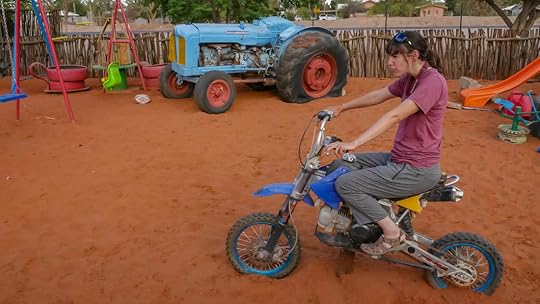 Our bike broke down and we had to trade it in for this one! Once again we've broken down in the middle of nowhere, this time it was out in the scorching Kalahari desert after a nasty fall into the sand... But let me start at the beginning, and it was a good beginning: the Drakensberg, meaning Dragon Mountains in Afrikaans.
Our bike broke down and we had to trade it in for this one! Once again we've broken down in the middle of nowhere, this time it was out in the scorching Kalahari desert after a nasty fall into the sand... But let me start at the beginning, and it was a good beginning: the Drakensberg, meaning Dragon Mountains in Afrikaans.
Back in South Africa, these jagged peaks definitely earned their name. Like towering stone monoliths ruling over the landscape from their lofty thrones, they say that it was the scenery of South Africa that inspired J. R. R. Tolkein to create Middle Earth in his fantasy books The Hobbit and Lord of the Rings. And I certainly agree that there seemed to be magic there, like I could just picture a dragon hiding behind the crags, protecting his hoard of gold and treasure.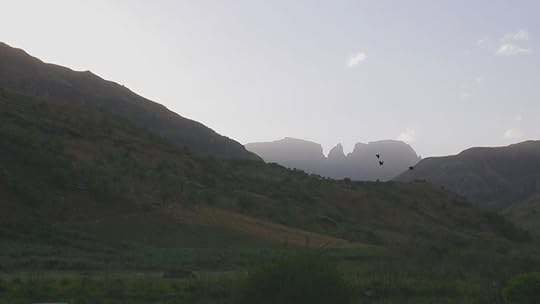 Giant's Castle, Drakensberg, South Africa
Giant's Castle, Drakensberg, South Africa 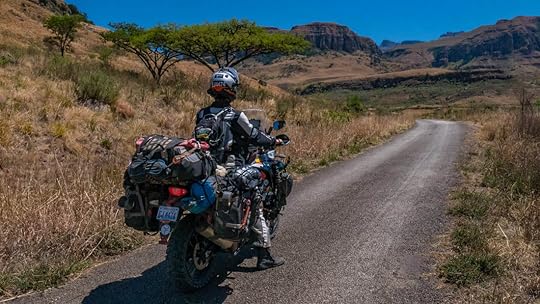 The road to Giant's Castle was gorgeous. The heart of the Drakensberg range is called Giant's Castle, another suitable name. And from there we rode through Golden Gate Park, which reminded us of Capitol Reef National Park in Utah: orange and beige cliffs hugging a road that twisted effortlessly through it, each rock smoothed out by the wind to make the landscape look like it had once been a lava lamp frozen in place.
The road to Giant's Castle was gorgeous. The heart of the Drakensberg range is called Giant's Castle, another suitable name. And from there we rode through Golden Gate Park, which reminded us of Capitol Reef National Park in Utah: orange and beige cliffs hugging a road that twisted effortlessly through it, each rock smoothed out by the wind to make the landscape look like it had once been a lava lamp frozen in place. 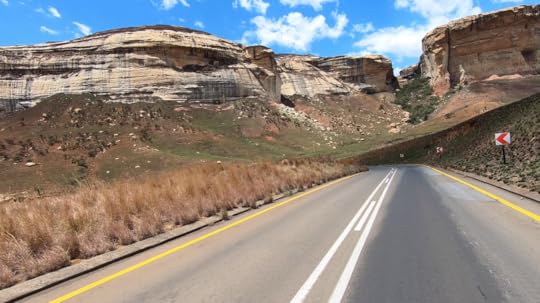 This is just a tiny snapshot of the thrill of driving through Golden Gate, South Africa. Unfortunately, the road was so winding and it was such a windy day, that I started feeling nauseous from being swung back and forth. So when we spotted our first wild zebras just hanging out on the side of the road, I was excited, but ended up throwing up right there as we took pictures of them. Not my finest hour, but Tim had a great moment.
This is just a tiny snapshot of the thrill of driving through Golden Gate, South Africa. Unfortunately, the road was so winding and it was such a windy day, that I started feeling nauseous from being swung back and forth. So when we spotted our first wild zebras just hanging out on the side of the road, I was excited, but ended up throwing up right there as we took pictures of them. Not my finest hour, but Tim had a great moment. 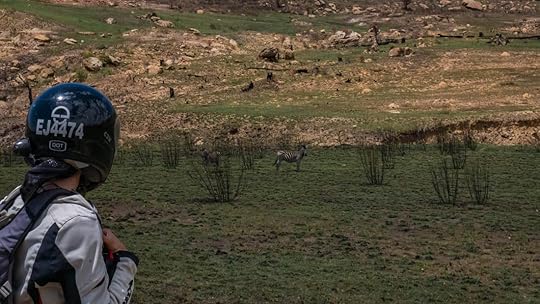 Past Golden Gate we were now in South Africa's high-altitude plain, similar to the South American altiplano. Instead of llamas though, there were springbok everywhere: a lovely antelope that jumps like it's a child on a trampoline, and when they “spring", it's like they float on air (they're what the South African rugby team that just won the world cup are named for).
Past Golden Gate we were now in South Africa's high-altitude plain, similar to the South American altiplano. Instead of llamas though, there were springbok everywhere: a lovely antelope that jumps like it's a child on a trampoline, and when they “spring", it's like they float on air (they're what the South African rugby team that just won the world cup are named for).
The breezes were refreshingly cool when we hit Bloemfontein, and we met up with one of the great motorcyclists of South Africa: Stefan Boshoff. Besides the awards he's won for motorcycle competitions around the world, he also won us over with his friendliness, hospitality, awesome family, and all around great stories. Because of people like him and his welcoming family, we will forever think fondly of the wonderful town of Bloemfontein.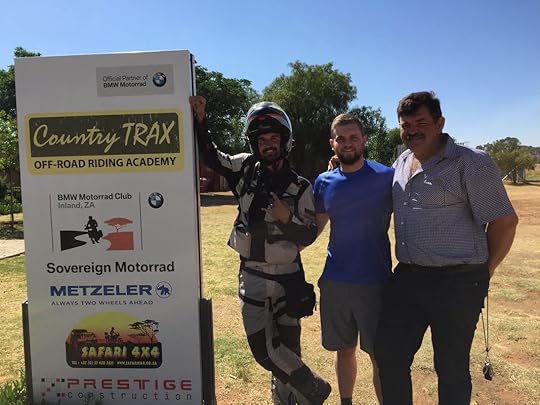 Stephan and his son Behan run an off-road riding school in Bloemfontein, South Africa. Our time in South Africa was coming to an end as we headed through the arid plains into Namibia. We had been warned about riding in Namibia: “The roads there chew tires up like bubble gum," “Don't let yourself get dehydrated. The Namibian sun is brutal." And perhaps the worst of all, “You'll hit lots of deep sand out of nowhere, and dunes can even blow over the paved roads."
Stephan and his son Behan run an off-road riding school in Bloemfontein, South Africa. Our time in South Africa was coming to an end as we headed through the arid plains into Namibia. We had been warned about riding in Namibia: “The roads there chew tires up like bubble gum," “Don't let yourself get dehydrated. The Namibian sun is brutal." And perhaps the worst of all, “You'll hit lots of deep sand out of nowhere, and dunes can even blow over the paved roads."
If you don't know what Namibia's like, have you seen the movie Mad Max: Fury Road? Well it was filmed there, and is a pretty perfect representation of Namibia's long stretches of gorgeous desert nothingness.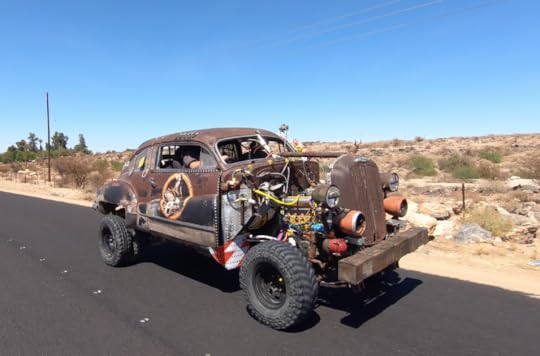 I'm pretty sure this guy that we passed has seen the Mad Max movies.
I'm pretty sure this guy that we passed has seen the Mad Max movies. 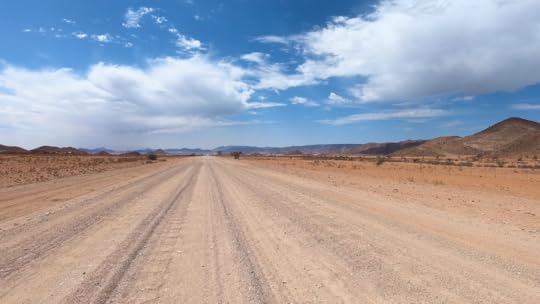 This is your typical Namibia. Wide open desert.
This is your typical Namibia. Wide open desert. 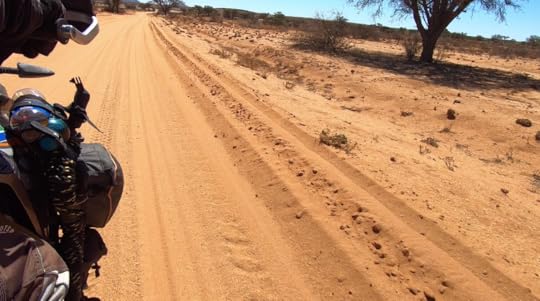 Oh yeah, did I mention that Namibia has sand? But we knew that Namibia was going to be worth it because of one simple fact: vast amounts of nature. It's a country two times the size of California with a population of less than Chicago, and as such, Namibia is the second most scarcely populated country on earth after Mongolia (another one of our dream destinations).
Oh yeah, did I mention that Namibia has sand? But we knew that Namibia was going to be worth it because of one simple fact: vast amounts of nature. It's a country two times the size of California with a population of less than Chicago, and as such, Namibia is the second most scarcely populated country on earth after Mongolia (another one of our dream destinations).
No amount of warnings were going to deter us.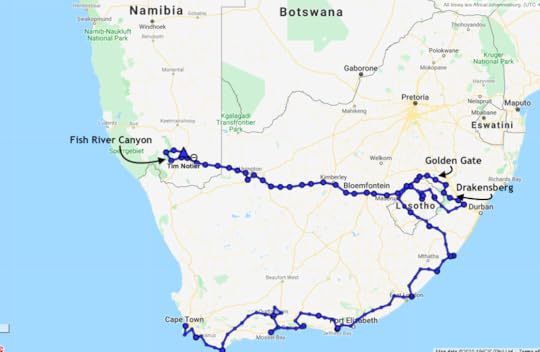 Our journey from the Drakensberg, South Africa to Namibia. But of course, the warnings were all correct. Before our disaster struck, we luckily had a few perfect days in Namibia at an awesome desert campsite with fiery sunsets and sleeping under the stars. And we took a day-trip to Africa's largest canyon, Fish River Canyon, which even after seeing the Grand Canyon, definitely didn't disappoint.
Our journey from the Drakensberg, South Africa to Namibia. But of course, the warnings were all correct. Before our disaster struck, we luckily had a few perfect days in Namibia at an awesome desert campsite with fiery sunsets and sleeping under the stars. And we took a day-trip to Africa's largest canyon, Fish River Canyon, which even after seeing the Grand Canyon, definitely didn't disappoint. 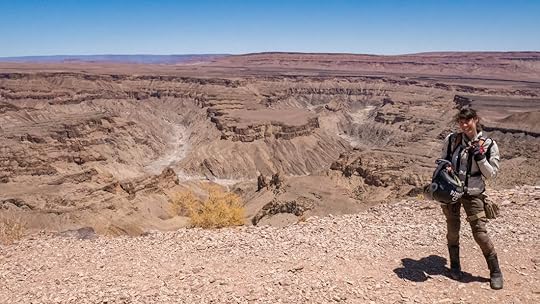 Me at Fish River Canyon, Namibia
Me at Fish River Canyon, Namibia 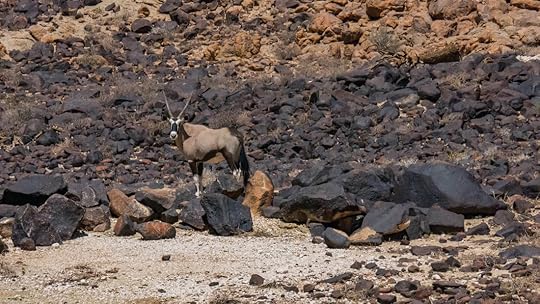 There were lots of Oryx, aka Gemsbok, in the area around Fish River Canyon, Namibia.
There were lots of Oryx, aka Gemsbok, in the area around Fish River Canyon, Namibia. 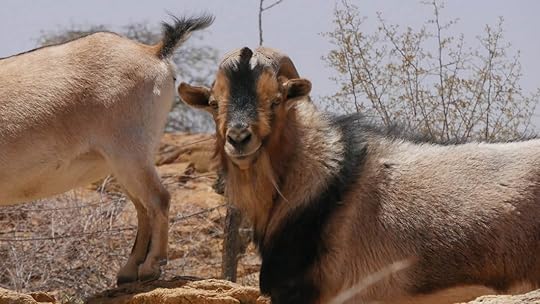 At our campsite in southern Namibia, we had some very cute neighbors. After the canyon, it didn't take long for things to take a turn for the worse. We were riding to one of Nambia's most famous spots called Sossusvlei. It's a collection of red dunes among a sea of other red dunes that is one of Namibia's most iconic images.
At our campsite in southern Namibia, we had some very cute neighbors. After the canyon, it didn't take long for things to take a turn for the worse. We were riding to one of Nambia's most famous spots called Sossusvlei. It's a collection of red dunes among a sea of other red dunes that is one of Namibia's most iconic images.
We'd been told the road there was bad, but it didn't look that bad at first. Just a wide straight stretch of gravel. 4x4's were flying past us, leaving us coughing in the dust they created. There were no big rocks, river crossings, patches of slippery mud, and certainly no ice. Yeah it was bumpy with corrugations, but that wasn't dangerous. So what could go wrong?
Oh yeah, sand.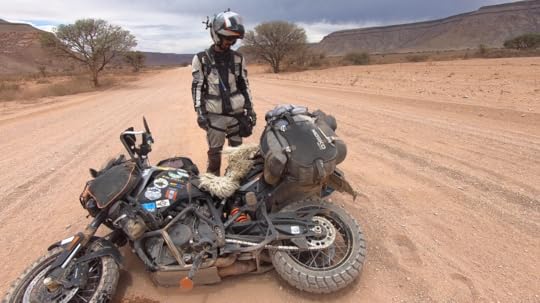 The infamous road to Sossusvlei, Namibia. Motorcycles and sand are like Batman and the Joker: enemies to the bone. Tim was powering through the bits of sand like any good rider should do, until we hit one long stretch that just wouldn't give up. It started with one wobble, then another, until finally the front tire was swaying so sharply, there was no saving us and we went sliding to the ground. Tim had throttled through as long as he could... but the front tire refused to plow forward in a straight line.
The infamous road to Sossusvlei, Namibia. Motorcycles and sand are like Batman and the Joker: enemies to the bone. Tim was powering through the bits of sand like any good rider should do, until we hit one long stretch that just wouldn't give up. It started with one wobble, then another, until finally the front tire was swaying so sharply, there was no saving us and we went sliding to the ground. Tim had throttled through as long as he could... but the front tire refused to plow forward in a straight line.
Only a sore right ankle for Tim, and a bunch of hurt pride were the noticeable consequences from our fall (not so much a fall as an NHL-style power slide). We took a drink, ate some lunch, and after feeling better, we hopped back on to continue to Sossusvlei when not half an hour later we felt it: crunch! And the horrible grinding of a broken monoshock rung in our ears.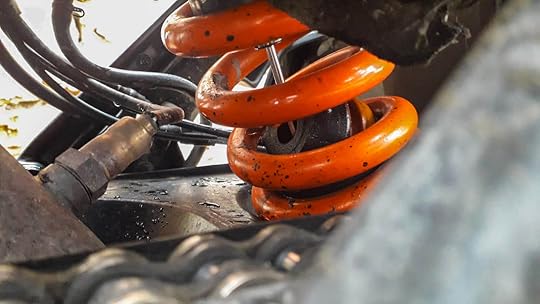 KTM states that this rod is not weight bearing, but... it has snapped twice. We stopped and noticed that now fluid had exploded out of our monoshock (rear suspension) and the internal metal rod was broken. This was not good, and we were familiar with this horrible situation from when our monoshock blew in Ecuador. We had to be towed five hours in the night to the nearest dealership, and $1,000 and two weeks later, things were fixed. Not an ideal scenario.
KTM states that this rod is not weight bearing, but... it has snapped twice. We stopped and noticed that now fluid had exploded out of our monoshock (rear suspension) and the internal metal rod was broken. This was not good, and we were familiar with this horrible situation from when our monoshock blew in Ecuador. We had to be towed five hours in the night to the nearest dealership, and $1,000 and two weeks later, things were fixed. Not an ideal scenario.
Now we were in a country without a KTM dealership, and would have to order the part from Cape Town to be flown in from Austria, then shipped to Windhoek. There were a lot of moving parts to replace our part that wouldn't move. And moreover, we were in the middle of nowhere, many hours from anything. How were we going to get ourselves and our broken bike back to civilization?
And perhaps worst of all, we were running low on water.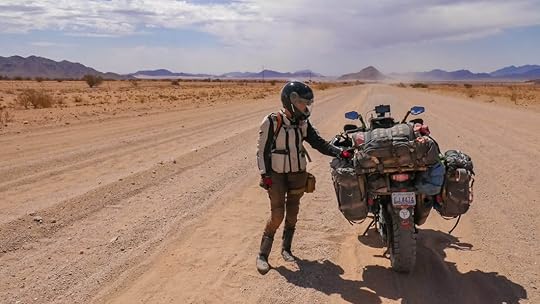 It was beautiful, but desolate. But whenever something terrible happens to us, we seem to get infinitely lucky at the same time. It's one of those strange lessons that traveling has taught us.
It was beautiful, but desolate. But whenever something terrible happens to us, we seem to get infinitely lucky at the same time. It's one of those strange lessons that traveling has taught us.
We looked at the positives: the bike still worked, it was just grinding on its hinges as we rode it, creaking and complaining. But after a few minutes of plugging along, we noticed a gate to a building. Private property certainly. But oh well, we just opened that gate and rode right in.
The owner came out and was extremely helpful. He called all five people who lived in the surrounding thousand hectors to see if any of them knew a guy with a tow truck, and told us there was a man down the road who owned a farm/campsite who just happened to be leaving for Windhoek (Namibia's capital city) with a nearly empty trailer the following morning. I couldn't believe our luck!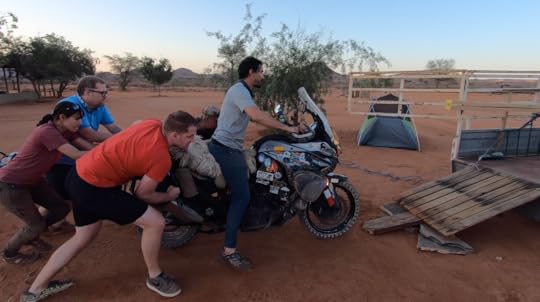 Yet another time we have to load our bike into a truck. Sad times. Oh yeah, and somehow in the vast barren desert, he was six minutes away. It took us ten minutes to get there at a cringing snail's pace, but we did. And then we met Allen, who absolutely is the Indiana Jones of Africa. Having grown up in Rhodesia, he spent his adult life in Namibia studying the geology of the earth, then used that knowledge to drill for diamonds and water. Yup, a bonafide treasure hunter, and his leather hat and satchel were the icing to the cake.
Yet another time we have to load our bike into a truck. Sad times. Oh yeah, and somehow in the vast barren desert, he was six minutes away. It took us ten minutes to get there at a cringing snail's pace, but we did. And then we met Allen, who absolutely is the Indiana Jones of Africa. Having grown up in Rhodesia, he spent his adult life in Namibia studying the geology of the earth, then used that knowledge to drill for diamonds and water. Yup, a bonafide treasure hunter, and his leather hat and satchel were the icing to the cake.
Allen graciously allowed us to put our broken motorcycle in his trailer, and the following morning at sunrise we drove six hours to Windhoek. We will forever be thankful for this man's incredible and serendipitous generosity. And that wasn't the end of our good luck. We got some advice from our new friend and motorcycle enthusiast Erik, a French man living in Namibia, and he told us where to go and who to call. Even though there's no KTM dealership (at the moment), KTM in South Africa said they could ship us the part in two weeks. Then we took the bike to Yamaha who told us it would be no problem to fix our shock. How perfect!
And that wasn't the end of our good luck. We got some advice from our new friend and motorcycle enthusiast Erik, a French man living in Namibia, and he told us where to go and who to call. Even though there's no KTM dealership (at the moment), KTM in South Africa said they could ship us the part in two weeks. Then we took the bike to Yamaha who told us it would be no problem to fix our shock. How perfect!
So now we just have to wait, and during that time, we're going to rent a car to go see Sossusvlei and other things in Namibia so that our time isn't a complete waste. Not the same as being on the bike, but it'll be something at least.
Stay tuned, and we'll keep you posted on how the adventure goes... Subscribe to Our Blog This week we'd like to thank Stephan for bringing us into his home like family, Harvey for teaching us about barking geckos at the Barking Gecko, Allen for saving us in our moment of need, and Erik for showing us the real Windhoek. And thank you to all of you out there who come along for the ride every blog post!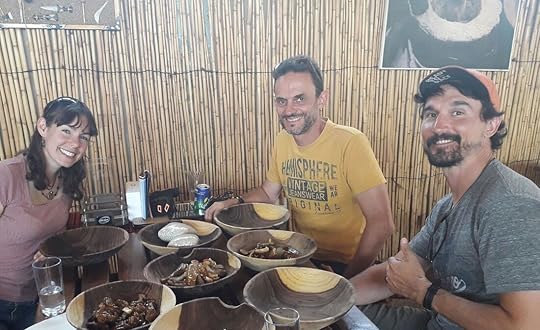 Me, Erik, and Tim in Windhoek eating tradition Namibian food.
Me, Erik, and Tim in Windhoek eating tradition Namibian food.
 Our bike broke down and we had to trade it in for this one! Once again we've broken down in the middle of nowhere, this time it was out in the scorching Kalahari desert after a nasty fall into the sand... But let me start at the beginning, and it was a good beginning: the Drakensberg, meaning Dragon Mountains in Afrikaans.
Our bike broke down and we had to trade it in for this one! Once again we've broken down in the middle of nowhere, this time it was out in the scorching Kalahari desert after a nasty fall into the sand... But let me start at the beginning, and it was a good beginning: the Drakensberg, meaning Dragon Mountains in Afrikaans.Back in South Africa, these jagged peaks definitely earned their name. Like towering stone monoliths ruling over the landscape from their lofty thrones, they say that it was the scenery of South Africa that inspired J. R. R. Tolkein to create Middle Earth in his fantasy books The Hobbit and Lord of the Rings. And I certainly agree that there seemed to be magic there, like I could just picture a dragon hiding behind the crags, protecting his hoard of gold and treasure.
 Giant's Castle, Drakensberg, South Africa
Giant's Castle, Drakensberg, South Africa  The road to Giant's Castle was gorgeous. The heart of the Drakensberg range is called Giant's Castle, another suitable name. And from there we rode through Golden Gate Park, which reminded us of Capitol Reef National Park in Utah: orange and beige cliffs hugging a road that twisted effortlessly through it, each rock smoothed out by the wind to make the landscape look like it had once been a lava lamp frozen in place.
The road to Giant's Castle was gorgeous. The heart of the Drakensberg range is called Giant's Castle, another suitable name. And from there we rode through Golden Gate Park, which reminded us of Capitol Reef National Park in Utah: orange and beige cliffs hugging a road that twisted effortlessly through it, each rock smoothed out by the wind to make the landscape look like it had once been a lava lamp frozen in place.  This is just a tiny snapshot of the thrill of driving through Golden Gate, South Africa. Unfortunately, the road was so winding and it was such a windy day, that I started feeling nauseous from being swung back and forth. So when we spotted our first wild zebras just hanging out on the side of the road, I was excited, but ended up throwing up right there as we took pictures of them. Not my finest hour, but Tim had a great moment.
This is just a tiny snapshot of the thrill of driving through Golden Gate, South Africa. Unfortunately, the road was so winding and it was such a windy day, that I started feeling nauseous from being swung back and forth. So when we spotted our first wild zebras just hanging out on the side of the road, I was excited, but ended up throwing up right there as we took pictures of them. Not my finest hour, but Tim had a great moment.  Past Golden Gate we were now in South Africa's high-altitude plain, similar to the South American altiplano. Instead of llamas though, there were springbok everywhere: a lovely antelope that jumps like it's a child on a trampoline, and when they “spring", it's like they float on air (they're what the South African rugby team that just won the world cup are named for).
Past Golden Gate we were now in South Africa's high-altitude plain, similar to the South American altiplano. Instead of llamas though, there were springbok everywhere: a lovely antelope that jumps like it's a child on a trampoline, and when they “spring", it's like they float on air (they're what the South African rugby team that just won the world cup are named for).The breezes were refreshingly cool when we hit Bloemfontein, and we met up with one of the great motorcyclists of South Africa: Stefan Boshoff. Besides the awards he's won for motorcycle competitions around the world, he also won us over with his friendliness, hospitality, awesome family, and all around great stories. Because of people like him and his welcoming family, we will forever think fondly of the wonderful town of Bloemfontein.
 Stephan and his son Behan run an off-road riding school in Bloemfontein, South Africa. Our time in South Africa was coming to an end as we headed through the arid plains into Namibia. We had been warned about riding in Namibia: “The roads there chew tires up like bubble gum," “Don't let yourself get dehydrated. The Namibian sun is brutal." And perhaps the worst of all, “You'll hit lots of deep sand out of nowhere, and dunes can even blow over the paved roads."
Stephan and his son Behan run an off-road riding school in Bloemfontein, South Africa. Our time in South Africa was coming to an end as we headed through the arid plains into Namibia. We had been warned about riding in Namibia: “The roads there chew tires up like bubble gum," “Don't let yourself get dehydrated. The Namibian sun is brutal." And perhaps the worst of all, “You'll hit lots of deep sand out of nowhere, and dunes can even blow over the paved roads."If you don't know what Namibia's like, have you seen the movie Mad Max: Fury Road? Well it was filmed there, and is a pretty perfect representation of Namibia's long stretches of gorgeous desert nothingness.
 I'm pretty sure this guy that we passed has seen the Mad Max movies.
I'm pretty sure this guy that we passed has seen the Mad Max movies.  This is your typical Namibia. Wide open desert.
This is your typical Namibia. Wide open desert.  Oh yeah, did I mention that Namibia has sand? But we knew that Namibia was going to be worth it because of one simple fact: vast amounts of nature. It's a country two times the size of California with a population of less than Chicago, and as such, Namibia is the second most scarcely populated country on earth after Mongolia (another one of our dream destinations).
Oh yeah, did I mention that Namibia has sand? But we knew that Namibia was going to be worth it because of one simple fact: vast amounts of nature. It's a country two times the size of California with a population of less than Chicago, and as such, Namibia is the second most scarcely populated country on earth after Mongolia (another one of our dream destinations).No amount of warnings were going to deter us.
 Our journey from the Drakensberg, South Africa to Namibia. But of course, the warnings were all correct. Before our disaster struck, we luckily had a few perfect days in Namibia at an awesome desert campsite with fiery sunsets and sleeping under the stars. And we took a day-trip to Africa's largest canyon, Fish River Canyon, which even after seeing the Grand Canyon, definitely didn't disappoint.
Our journey from the Drakensberg, South Africa to Namibia. But of course, the warnings were all correct. Before our disaster struck, we luckily had a few perfect days in Namibia at an awesome desert campsite with fiery sunsets and sleeping under the stars. And we took a day-trip to Africa's largest canyon, Fish River Canyon, which even after seeing the Grand Canyon, definitely didn't disappoint.  Me at Fish River Canyon, Namibia
Me at Fish River Canyon, Namibia  There were lots of Oryx, aka Gemsbok, in the area around Fish River Canyon, Namibia.
There were lots of Oryx, aka Gemsbok, in the area around Fish River Canyon, Namibia.  At our campsite in southern Namibia, we had some very cute neighbors. After the canyon, it didn't take long for things to take a turn for the worse. We were riding to one of Nambia's most famous spots called Sossusvlei. It's a collection of red dunes among a sea of other red dunes that is one of Namibia's most iconic images.
At our campsite in southern Namibia, we had some very cute neighbors. After the canyon, it didn't take long for things to take a turn for the worse. We were riding to one of Nambia's most famous spots called Sossusvlei. It's a collection of red dunes among a sea of other red dunes that is one of Namibia's most iconic images.We'd been told the road there was bad, but it didn't look that bad at first. Just a wide straight stretch of gravel. 4x4's were flying past us, leaving us coughing in the dust they created. There were no big rocks, river crossings, patches of slippery mud, and certainly no ice. Yeah it was bumpy with corrugations, but that wasn't dangerous. So what could go wrong?
Oh yeah, sand.
 The infamous road to Sossusvlei, Namibia. Motorcycles and sand are like Batman and the Joker: enemies to the bone. Tim was powering through the bits of sand like any good rider should do, until we hit one long stretch that just wouldn't give up. It started with one wobble, then another, until finally the front tire was swaying so sharply, there was no saving us and we went sliding to the ground. Tim had throttled through as long as he could... but the front tire refused to plow forward in a straight line.
The infamous road to Sossusvlei, Namibia. Motorcycles and sand are like Batman and the Joker: enemies to the bone. Tim was powering through the bits of sand like any good rider should do, until we hit one long stretch that just wouldn't give up. It started with one wobble, then another, until finally the front tire was swaying so sharply, there was no saving us and we went sliding to the ground. Tim had throttled through as long as he could... but the front tire refused to plow forward in a straight line.Only a sore right ankle for Tim, and a bunch of hurt pride were the noticeable consequences from our fall (not so much a fall as an NHL-style power slide). We took a drink, ate some lunch, and after feeling better, we hopped back on to continue to Sossusvlei when not half an hour later we felt it: crunch! And the horrible grinding of a broken monoshock rung in our ears.
 KTM states that this rod is not weight bearing, but... it has snapped twice. We stopped and noticed that now fluid had exploded out of our monoshock (rear suspension) and the internal metal rod was broken. This was not good, and we were familiar with this horrible situation from when our monoshock blew in Ecuador. We had to be towed five hours in the night to the nearest dealership, and $1,000 and two weeks later, things were fixed. Not an ideal scenario.
KTM states that this rod is not weight bearing, but... it has snapped twice. We stopped and noticed that now fluid had exploded out of our monoshock (rear suspension) and the internal metal rod was broken. This was not good, and we were familiar with this horrible situation from when our monoshock blew in Ecuador. We had to be towed five hours in the night to the nearest dealership, and $1,000 and two weeks later, things were fixed. Not an ideal scenario.Now we were in a country without a KTM dealership, and would have to order the part from Cape Town to be flown in from Austria, then shipped to Windhoek. There were a lot of moving parts to replace our part that wouldn't move. And moreover, we were in the middle of nowhere, many hours from anything. How were we going to get ourselves and our broken bike back to civilization?
And perhaps worst of all, we were running low on water.
 It was beautiful, but desolate. But whenever something terrible happens to us, we seem to get infinitely lucky at the same time. It's one of those strange lessons that traveling has taught us.
It was beautiful, but desolate. But whenever something terrible happens to us, we seem to get infinitely lucky at the same time. It's one of those strange lessons that traveling has taught us.We looked at the positives: the bike still worked, it was just grinding on its hinges as we rode it, creaking and complaining. But after a few minutes of plugging along, we noticed a gate to a building. Private property certainly. But oh well, we just opened that gate and rode right in.
The owner came out and was extremely helpful. He called all five people who lived in the surrounding thousand hectors to see if any of them knew a guy with a tow truck, and told us there was a man down the road who owned a farm/campsite who just happened to be leaving for Windhoek (Namibia's capital city) with a nearly empty trailer the following morning. I couldn't believe our luck!
 Yet another time we have to load our bike into a truck. Sad times. Oh yeah, and somehow in the vast barren desert, he was six minutes away. It took us ten minutes to get there at a cringing snail's pace, but we did. And then we met Allen, who absolutely is the Indiana Jones of Africa. Having grown up in Rhodesia, he spent his adult life in Namibia studying the geology of the earth, then used that knowledge to drill for diamonds and water. Yup, a bonafide treasure hunter, and his leather hat and satchel were the icing to the cake.
Yet another time we have to load our bike into a truck. Sad times. Oh yeah, and somehow in the vast barren desert, he was six minutes away. It took us ten minutes to get there at a cringing snail's pace, but we did. And then we met Allen, who absolutely is the Indiana Jones of Africa. Having grown up in Rhodesia, he spent his adult life in Namibia studying the geology of the earth, then used that knowledge to drill for diamonds and water. Yup, a bonafide treasure hunter, and his leather hat and satchel were the icing to the cake.Allen graciously allowed us to put our broken motorcycle in his trailer, and the following morning at sunrise we drove six hours to Windhoek. We will forever be thankful for this man's incredible and serendipitous generosity.
 And that wasn't the end of our good luck. We got some advice from our new friend and motorcycle enthusiast Erik, a French man living in Namibia, and he told us where to go and who to call. Even though there's no KTM dealership (at the moment), KTM in South Africa said they could ship us the part in two weeks. Then we took the bike to Yamaha who told us it would be no problem to fix our shock. How perfect!
And that wasn't the end of our good luck. We got some advice from our new friend and motorcycle enthusiast Erik, a French man living in Namibia, and he told us where to go and who to call. Even though there's no KTM dealership (at the moment), KTM in South Africa said they could ship us the part in two weeks. Then we took the bike to Yamaha who told us it would be no problem to fix our shock. How perfect!So now we just have to wait, and during that time, we're going to rent a car to go see Sossusvlei and other things in Namibia so that our time isn't a complete waste. Not the same as being on the bike, but it'll be something at least.
Stay tuned, and we'll keep you posted on how the adventure goes... Subscribe to Our Blog This week we'd like to thank Stephan for bringing us into his home like family, Harvey for teaching us about barking geckos at the Barking Gecko, Allen for saving us in our moment of need, and Erik for showing us the real Windhoek. And thank you to all of you out there who come along for the ride every blog post!
 Me, Erik, and Tim in Windhoek eating tradition Namibian food.
Me, Erik, and Tim in Windhoek eating tradition Namibian food.
Published on November 10, 2019 08:04
October 25, 2019
Crossing the Kingdom in the Sky: Lesotho
By Marisa 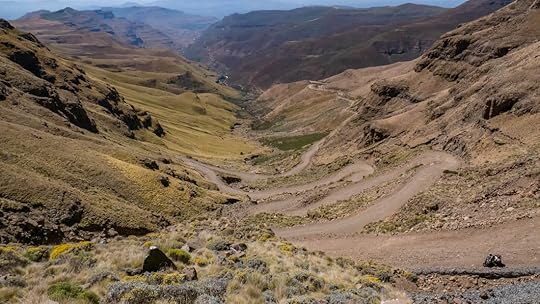 The wall of jagged mountains in the distance loomed closer and closer as we rode from South Africa toward Qachas Nek Pass into Lesotho. As our bike climbed in elevation, swerving back and forth along switchbacks, we realized that it was going to be a long time before we'd dip back down in altitude. Because now we were entering Lesotho: the Kingdom in the Sky, a tiny country completely surrounded by South Africa, and a mysterious land of mountains that feels lofty and untouched by the rest of the world.
The wall of jagged mountains in the distance loomed closer and closer as we rode from South Africa toward Qachas Nek Pass into Lesotho. As our bike climbed in elevation, swerving back and forth along switchbacks, we realized that it was going to be a long time before we'd dip back down in altitude. Because now we were entering Lesotho: the Kingdom in the Sky, a tiny country completely surrounded by South Africa, and a mysterious land of mountains that feels lofty and untouched by the rest of the world.
And despite almost dying on the first day and afterwards Tim coming down with Spotted Fever, Lesotho deeply impressed us, and has become one of our favorite countries.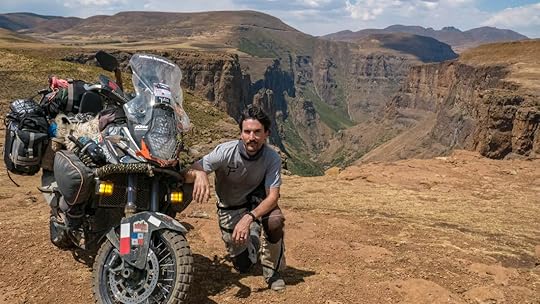 Tim in front of the gorge at Semonkong, Lesotho. If you're not South African, I wouldn't blame you if you'd never heard of Lesotho, and I'd be shocked if you knew how to pronounce it. Said like le-SU-tu, yet written Lesotho, one would think it should be spelled differently. But spelling aside, I hope after you read this post that you'll never forget this regal country that feels lost in time.
Tim in front of the gorge at Semonkong, Lesotho. If you're not South African, I wouldn't blame you if you'd never heard of Lesotho, and I'd be shocked if you knew how to pronounce it. Said like le-SU-tu, yet written Lesotho, one would think it should be spelled differently. But spelling aside, I hope after you read this post that you'll never forget this regal country that feels lost in time. 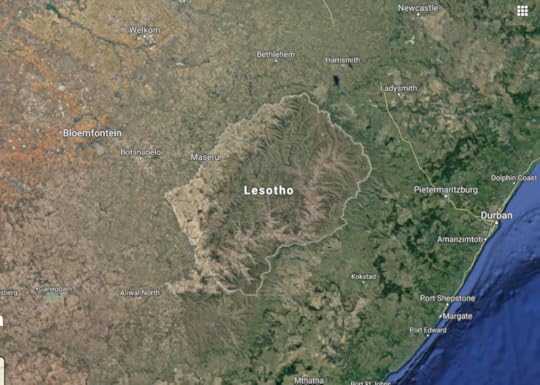 Even from space, mountainous Lesotho seems markedly different from the surrounding South African landscape.
Even from space, mountainous Lesotho seems markedly different from the surrounding South African landscape. 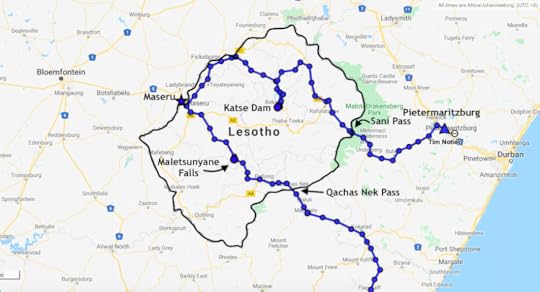 This was our ride through Lesotho, which took only six days, five nights. If you've seen the Marvel superhero movie Black Panther, then you might be familiar with the fictional African country of Wakanda, which was inspired by Lesotho. Though Lesotho is not some super technologically-advanced nation, it is an African kingdom that has been somewhat overlooked and forgotten by the rest of the world. And it feels as if Lesotho is content to keep it that way.
This was our ride through Lesotho, which took only six days, five nights. If you've seen the Marvel superhero movie Black Panther, then you might be familiar with the fictional African country of Wakanda, which was inspired by Lesotho. Though Lesotho is not some super technologically-advanced nation, it is an African kingdom that has been somewhat overlooked and forgotten by the rest of the world. And it feels as if Lesotho is content to keep it that way.
Plus, if you watch the movie again, you'll see plenty of characters dressed in the traditional blankets that everyone in Lesotho wears. They're beautiful, practical, but I also think anyone wearing them looks like a superhero.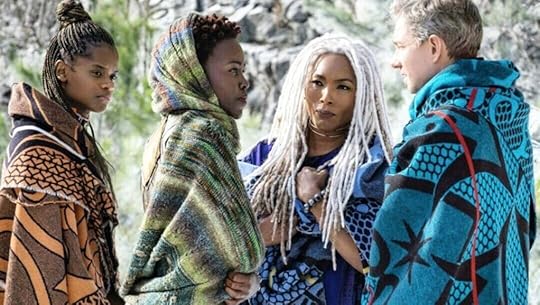 A scene from Black Panther showcasing the Basotho blankets.
A scene from Black Panther showcasing the Basotho blankets. 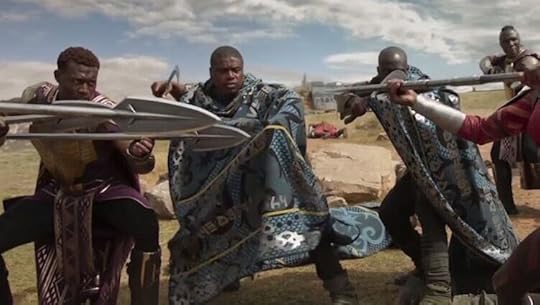 Another scene from Black Panther showcasing the Basotho blankets. I can completely see why someone might believe this kingdom is full of near-magical secrets. Though the Basotho people are mostly shepherds and herders, they look far from ordinary as they walk the mountain crests tall, lean, with walking sticks and staves, their blankets like cloaks billowing behind them in the wind. They sometimes wear their iconic straw hats (a symbol on their flag), either that or they cover their faces ninja-style, all giving them an air of mystery and majesty.
Another scene from Black Panther showcasing the Basotho blankets. I can completely see why someone might believe this kingdom is full of near-magical secrets. Though the Basotho people are mostly shepherds and herders, they look far from ordinary as they walk the mountain crests tall, lean, with walking sticks and staves, their blankets like cloaks billowing behind them in the wind. They sometimes wear their iconic straw hats (a symbol on their flag), either that or they cover their faces ninja-style, all giving them an air of mystery and majesty. 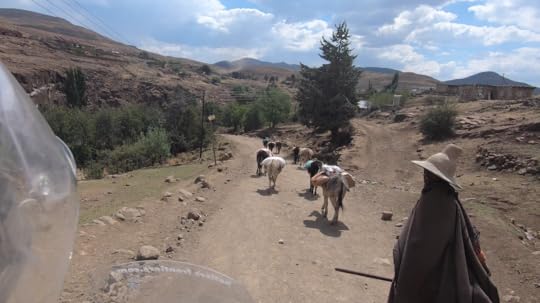 A shepherd in the traditional Basotho hat, along with his caravan of donkeys.
A shepherd in the traditional Basotho hat, along with his caravan of donkeys. 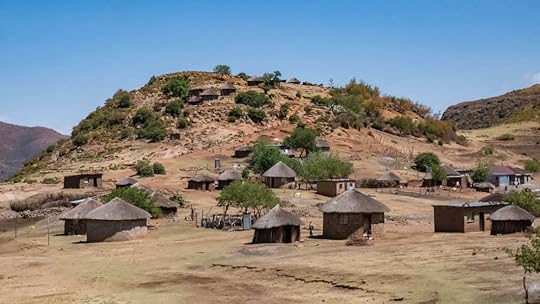 The traditional rondaval huts that dot the landscape of Lesotho. Besides walking the mountains, the Basotho people also ride finely-bred horses, and you might see them galloping across the valleys while waving their whips in the air, hollering at their cattle to move in a certain direction. These are truly rugged cowboys of the wild west, except African-style. And instead of being gritty outlaws having shootouts in saloons, the Basotho people are friendly, generous, and kind.
The traditional rondaval huts that dot the landscape of Lesotho. Besides walking the mountains, the Basotho people also ride finely-bred horses, and you might see them galloping across the valleys while waving their whips in the air, hollering at their cattle to move in a certain direction. These are truly rugged cowboys of the wild west, except African-style. And instead of being gritty outlaws having shootouts in saloons, the Basotho people are friendly, generous, and kind. 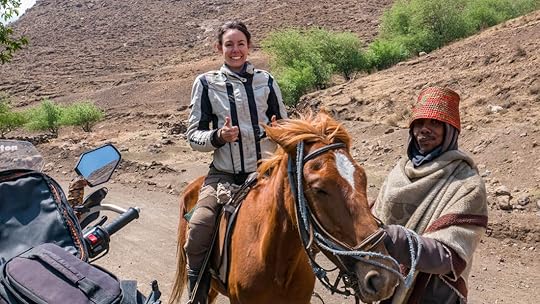 Me jumping on our new friend's horse. I kid you not, absolutely every single person we passed in Lesotho smiled and waved at us. These people may sometimes look intimidating by having scarves covering their faces, but they are as welcoming as can be. The women who wear their blankets like colorful dresses will wave with their free hand while the other holds a water jug atop their head, and children come running up to the motorcycle, not begging for food or candy, but with joyous smiles and a thumbs up.
Me jumping on our new friend's horse. I kid you not, absolutely every single person we passed in Lesotho smiled and waved at us. These people may sometimes look intimidating by having scarves covering their faces, but they are as welcoming as can be. The women who wear their blankets like colorful dresses will wave with their free hand while the other holds a water jug atop their head, and children come running up to the motorcycle, not begging for food or candy, but with joyous smiles and a thumbs up. 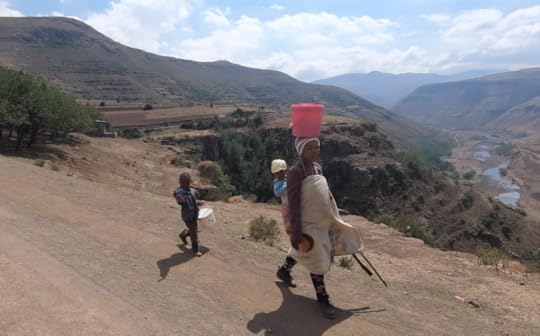 For a country that's not very modern, Lesotho surprisingly has perfectly paved highways that zigzag up and down the country. For motorcyclists, these tarmac roads are heaven, making your tires happy as you lean into the curves, and the changing landscape of green valleys and reddened peaks is like candy for the eyes.
For a country that's not very modern, Lesotho surprisingly has perfectly paved highways that zigzag up and down the country. For motorcyclists, these tarmac roads are heaven, making your tires happy as you lean into the curves, and the changing landscape of green valleys and reddened peaks is like candy for the eyes.
And for off-road adventurers, Lesotho can also provide some of the toughest tracks out there (as they say here, only a monkey with a stick can get through them).
All of Lesotho is mountainous, and over 80% of it is above 5,000 ft. in elevation (1,500 meters). They even have ski resorts, and hitting ice and snow is not infrequent. Luckily, the entirety of our time there was blessed with perfectly warm days with blue skies.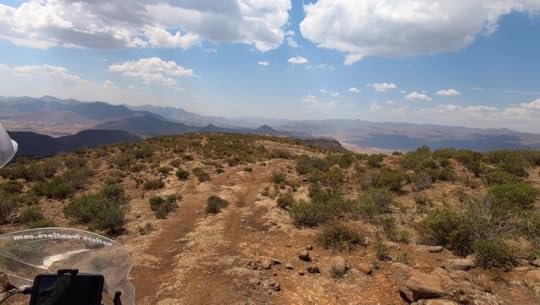 One of the many not-so-paved roads we took through gorgeous Lesotho. Yet if it wasn't for the incredible people, stunning scenery, and perfect weather, we might have hated our time there. Because our first destination in Lesotho was one of the deadliest stops we've ever made, and I hope not to break that record. It's called Maletsunyane Falls, and it's not the lovely waterfall that made it dangerous. It was our own stupidity to want to get a picture of the bike right in front of it, right along a cliff's edge.
One of the many not-so-paved roads we took through gorgeous Lesotho. Yet if it wasn't for the incredible people, stunning scenery, and perfect weather, we might have hated our time there. Because our first destination in Lesotho was one of the deadliest stops we've ever made, and I hope not to break that record. It's called Maletsunyane Falls, and it's not the lovely waterfall that made it dangerous. It was our own stupidity to want to get a picture of the bike right in front of it, right along a cliff's edge.
The picture turned out great (below), but the problem was that the steeply sloping ground leading to the sheer cliff was made of loose rocks and shale. Not the best material for the tires to grip onto. Tim asked me to turn on his helmet cam while he maneuvered his bike around to get back up the hill because he knew that it would either capture his success or his death... what it ended up capturing was right in-between. Because as the back tire kept kicking out rocks, it lost its grip, and eventually Tim and the motorcycle toppled over and tumbled down toward the cliff's edge!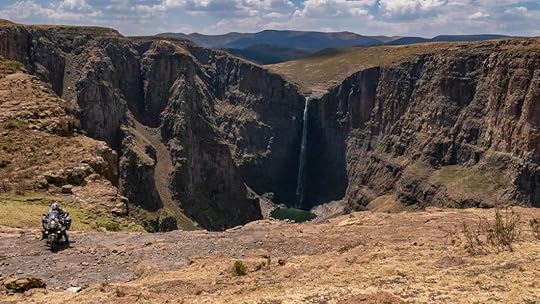 This was taken just before disaster struck at Maletsunyane Falls, Lesotho.
This was taken just before disaster struck at Maletsunyane Falls, Lesotho. 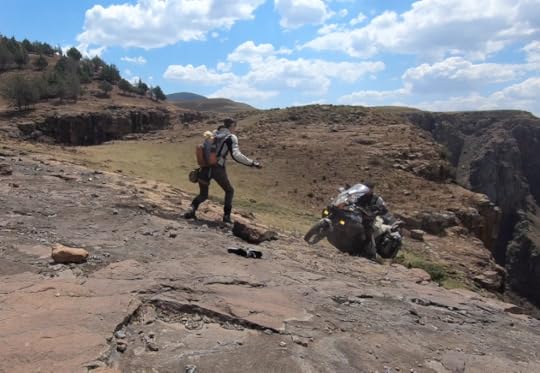 This was one of the scariest moments of my life as I watched Tim slide down toward the cliff. I screamed, thinking I was going to lose my husband, but thankfully both the bike and Tim stopped their slide right before the edge. It took us about 15 horrible minutes of pushing and pulling to finally get the motorcycle into a position where Tim could ride it up and away from the cliff.
This was one of the scariest moments of my life as I watched Tim slide down toward the cliff. I screamed, thinking I was going to lose my husband, but thankfully both the bike and Tim stopped their slide right before the edge. It took us about 15 horrible minutes of pushing and pulling to finally get the motorcycle into a position where Tim could ride it up and away from the cliff.
Once we were back up the hill, we took a breather at the top to drink water with shaky hands, and I said good riddance to the waterfall where Tim nearly died. This was pure stupidity on our part (Tim admits it was mostly his part). And to think that he almost became one of those people that died at the Grand Canyon from taking a selfie! Horrible.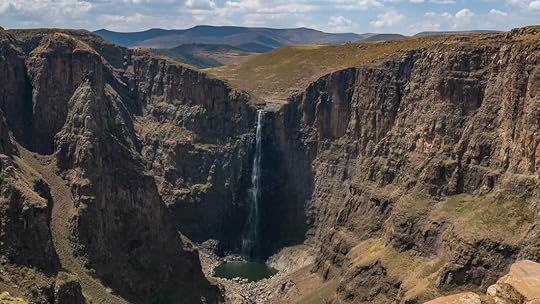 Maletsunyane Falls sure is pretty though. We spent the night appreciating being alive as we camped at a traditionally thatched lodge in the village of Semonkong. You had to go down a donkey trail into a ravine to get there, and it was such a surprise when we arrived to see a proper bar with blond people sipping pints of beer under Coca-Cola awnings, I just couldn't believe my eyes. The place offered hikes, abseiling, pony rides, and even did something called a Donkey Pub Crawl. Yup, you guessed it, they take tourists from pub to pub on donkeys.
Maletsunyane Falls sure is pretty though. We spent the night appreciating being alive as we camped at a traditionally thatched lodge in the village of Semonkong. You had to go down a donkey trail into a ravine to get there, and it was such a surprise when we arrived to see a proper bar with blond people sipping pints of beer under Coca-Cola awnings, I just couldn't believe my eyes. The place offered hikes, abseiling, pony rides, and even did something called a Donkey Pub Crawl. Yup, you guessed it, they take tourists from pub to pub on donkeys.
The next day we wove our way north past the grimy capital city of Maseru, and into a canyon-filled area that reminded me of New Mexico. We hadn't done any difficult roads, in fact, the day had been easy, but Tim kept complaining of feeling overwhelming exhaustion.
And that night, his fevers started.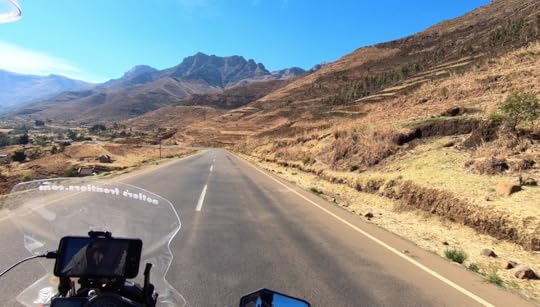 Around every curve in the road in Lesotho, we were presented with another stunning view. I thought maybe it was just road fatigue. So we decided to stay in Hlotse another day to give Tim some rest, but when his fever got worse the following night, I started getting really worried.
Around every curve in the road in Lesotho, we were presented with another stunning view. I thought maybe it was just road fatigue. So we decided to stay in Hlotse another day to give Tim some rest, but when his fever got worse the following night, I started getting really worried.
A fever in Africa could be a sign of any number of awful things, from the Sleeping Sickness, to Dengue Fever, to malaria. Tim continued to feel chills and was foggy-headed on the third day, but he said he was well enough to move on.
So we headed to Katse Dam, which is an impressive dam, but more importantly for us, the road there is stunning.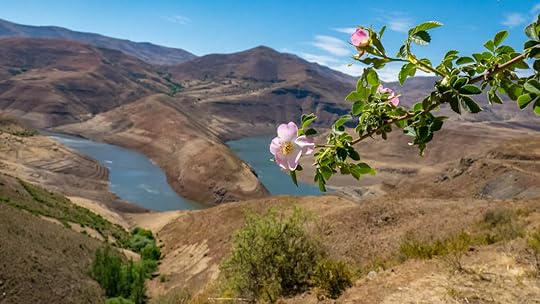 Katse Lake created by Katse Dam, Lesotho. We wild camped that night near a stream with sheep and cows grazing all around us, their bells around their necks sounding like soothing wind chimes. But poor Tim could not enjoy any of this as his nightly fever returned with a vengeance, and I found myself staying up all night making sure he was breathing. This was certainly not your typical flu. This was bad.
Katse Lake created by Katse Dam, Lesotho. We wild camped that night near a stream with sheep and cows grazing all around us, their bells around their necks sounding like soothing wind chimes. But poor Tim could not enjoy any of this as his nightly fever returned with a vengeance, and I found myself staying up all night making sure he was breathing. This was certainly not your typical flu. This was bad.
I thought about mosquito bites and the diseases they carry, but then I started thinking about a particularly nasty bite on Tim's leg. I noticed how red and swollen it had gotten. Wasn't that where I had pulled a tiny tick off him just five days prior?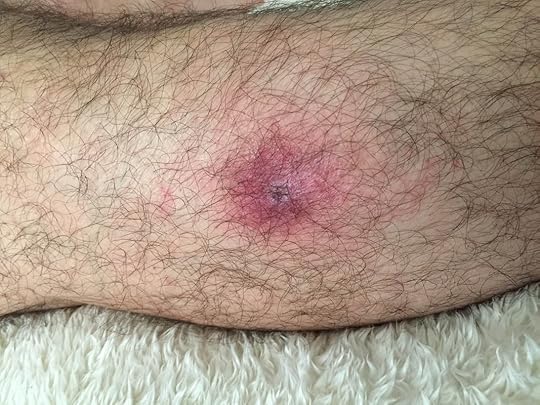 To all those who are squeamish, I apologize for this picture. I inspected his leg closer and noticed another swollen red splotch on his foot where I had previously taken a second tick off him. Though I was sure I'd gotten the heads out with both these ticks, maybe his wounds had gotten infected. Surely they looked infected. But could it be possible that these infections had become severe enough to cause his fever?
To all those who are squeamish, I apologize for this picture. I inspected his leg closer and noticed another swollen red splotch on his foot where I had previously taken a second tick off him. Though I was sure I'd gotten the heads out with both these ticks, maybe his wounds had gotten infected. Surely they looked infected. But could it be possible that these infections had become severe enough to cause his fever?
Either way, I smothered his bites in disinfectant, and then started Tim immediately on a round of antibiotics that we carry for emergencies like these.
The next morning he felt a bit better, but still had a headache. We had a difficult dirt road ahead of us as we made our way east from one major highway to another, but Tim tackled the challenge with flying colors. I was now feeling confident that he was suffering from an infection caused by the tick bites, and that the medicine was helping.
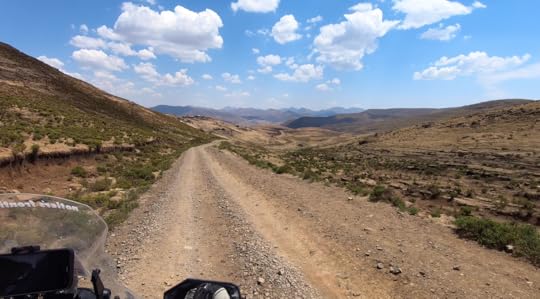 This was the easy part of the Lejone road from highway A25 to A1, Lesotho. Again, simply beautiful. That night as we stayed near Mokhotlong, we finally got internet, and first thing I did was Google “African tick bite". The results couldn't have been more exact to Tim's bites and his symptoms; Wikipedia should have just written his name in there.
This was the easy part of the Lejone road from highway A25 to A1, Lesotho. Again, simply beautiful. That night as we stayed near Mokhotlong, we finally got internet, and first thing I did was Google “African tick bite". The results couldn't have been more exact to Tim's bites and his symptoms; Wikipedia should have just written his name in there.
It turned out that he had ATBF, African Tick Bite Fever, which is a form of Spotted Fever caused by a bacteria transmitted through a specific type of South African tick. So we had a diagnosis, but best of all, it's easily treatable with the antibiotics Tim was already taking. Thank goodness!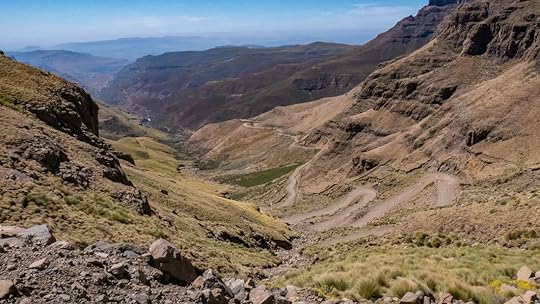 This is Sani Pass. Usually enveloped in clouds and mist, we picked a pretty perfect day to ride down it. Our last day out of Lesotho was going to be our most challenging, because we had decided to do the infamous Sani Pass that leads from the Lesotho highlands down into South Africa. It's hard enough going up the pass as most people do, but we decided to be extra crazy and go down it. Actually, we didn't really have much of a choice at this point since it was the way we were headed, and the only way out of Lesotho in that direction.
This is Sani Pass. Usually enveloped in clouds and mist, we picked a pretty perfect day to ride down it. Our last day out of Lesotho was going to be our most challenging, because we had decided to do the infamous Sani Pass that leads from the Lesotho highlands down into South Africa. It's hard enough going up the pass as most people do, but we decided to be extra crazy and go down it. Actually, we didn't really have much of a choice at this point since it was the way we were headed, and the only way out of Lesotho in that direction.
The first part was full of tight, steep switchbacks with loose rocks and gravel. Where the rocks were too loose for traction, I would hop off and walk portions of the switchbacks. It was convenient for me to take pictures as well. Even so, Tim fell three times. I even fell while walking! I slipped on the loose rocks walking downhill and landed hard on my side like I had been skating on ice. Sani Pass is no joke!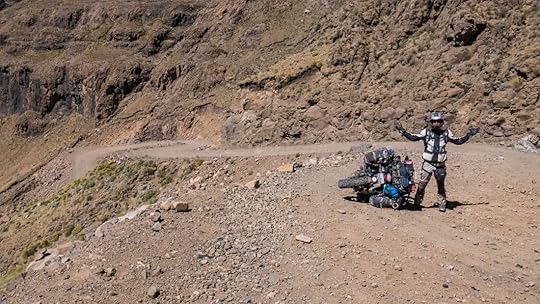 Ahhh, Sani Pass. It's earned its reputation, for sure. It was pretty gnarly in sections, but Tim handled it like a pro. Fortunately, he was feeling great by this time as the antibiotics were working their magic, and we made it all the way down Sani Pass and into South Africa once again.
Ahhh, Sani Pass. It's earned its reputation, for sure. It was pretty gnarly in sections, but Tim handled it like a pro. Fortunately, he was feeling great by this time as the antibiotics were working their magic, and we made it all the way down Sani Pass and into South Africa once again. 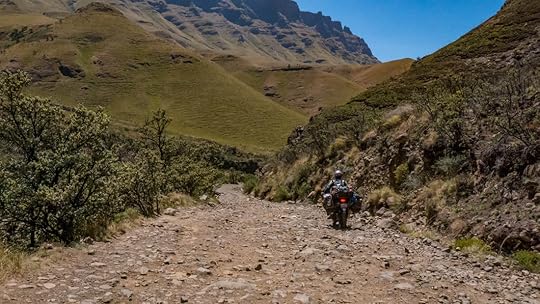 This was the “easy" section of Sani Pass towards the end where it leveled out. Now we're in Pietermaritzburg, preparing ourselves and the bike for our next ventures. Yet as I think back, I cannot fathom that there will be many places on this earth that will have touched me as Lesotho has. It's been adventurous, gorgeous, friendly, almost deadly at times, and all around an experience to remember. Subscribe This week we'd like to thank Tabby and Elijah for giving us a taste of local Lesotho cuisine and helping Tim when he was not well, and to Barry for your kind hospitality and assisting us with our motorcycle repairs.
This was the “easy" section of Sani Pass towards the end where it leveled out. Now we're in Pietermaritzburg, preparing ourselves and the bike for our next ventures. Yet as I think back, I cannot fathom that there will be many places on this earth that will have touched me as Lesotho has. It's been adventurous, gorgeous, friendly, almost deadly at times, and all around an experience to remember. Subscribe This week we'd like to thank Tabby and Elijah for giving us a taste of local Lesotho cuisine and helping Tim when he was not well, and to Barry for your kind hospitality and assisting us with our motorcycle repairs.
And thanks to all of you out there who keep up with our adventures! Stay tuned, and we'll keep you updated!
Next up: Dragon Country (Drakensberg)...
 The wall of jagged mountains in the distance loomed closer and closer as we rode from South Africa toward Qachas Nek Pass into Lesotho. As our bike climbed in elevation, swerving back and forth along switchbacks, we realized that it was going to be a long time before we'd dip back down in altitude. Because now we were entering Lesotho: the Kingdom in the Sky, a tiny country completely surrounded by South Africa, and a mysterious land of mountains that feels lofty and untouched by the rest of the world.
The wall of jagged mountains in the distance loomed closer and closer as we rode from South Africa toward Qachas Nek Pass into Lesotho. As our bike climbed in elevation, swerving back and forth along switchbacks, we realized that it was going to be a long time before we'd dip back down in altitude. Because now we were entering Lesotho: the Kingdom in the Sky, a tiny country completely surrounded by South Africa, and a mysterious land of mountains that feels lofty and untouched by the rest of the world.And despite almost dying on the first day and afterwards Tim coming down with Spotted Fever, Lesotho deeply impressed us, and has become one of our favorite countries.
 Tim in front of the gorge at Semonkong, Lesotho. If you're not South African, I wouldn't blame you if you'd never heard of Lesotho, and I'd be shocked if you knew how to pronounce it. Said like le-SU-tu, yet written Lesotho, one would think it should be spelled differently. But spelling aside, I hope after you read this post that you'll never forget this regal country that feels lost in time.
Tim in front of the gorge at Semonkong, Lesotho. If you're not South African, I wouldn't blame you if you'd never heard of Lesotho, and I'd be shocked if you knew how to pronounce it. Said like le-SU-tu, yet written Lesotho, one would think it should be spelled differently. But spelling aside, I hope after you read this post that you'll never forget this regal country that feels lost in time.  Even from space, mountainous Lesotho seems markedly different from the surrounding South African landscape.
Even from space, mountainous Lesotho seems markedly different from the surrounding South African landscape.  This was our ride through Lesotho, which took only six days, five nights. If you've seen the Marvel superhero movie Black Panther, then you might be familiar with the fictional African country of Wakanda, which was inspired by Lesotho. Though Lesotho is not some super technologically-advanced nation, it is an African kingdom that has been somewhat overlooked and forgotten by the rest of the world. And it feels as if Lesotho is content to keep it that way.
This was our ride through Lesotho, which took only six days, five nights. If you've seen the Marvel superhero movie Black Panther, then you might be familiar with the fictional African country of Wakanda, which was inspired by Lesotho. Though Lesotho is not some super technologically-advanced nation, it is an African kingdom that has been somewhat overlooked and forgotten by the rest of the world. And it feels as if Lesotho is content to keep it that way.Plus, if you watch the movie again, you'll see plenty of characters dressed in the traditional blankets that everyone in Lesotho wears. They're beautiful, practical, but I also think anyone wearing them looks like a superhero.
 A scene from Black Panther showcasing the Basotho blankets.
A scene from Black Panther showcasing the Basotho blankets.  Another scene from Black Panther showcasing the Basotho blankets. I can completely see why someone might believe this kingdom is full of near-magical secrets. Though the Basotho people are mostly shepherds and herders, they look far from ordinary as they walk the mountain crests tall, lean, with walking sticks and staves, their blankets like cloaks billowing behind them in the wind. They sometimes wear their iconic straw hats (a symbol on their flag), either that or they cover their faces ninja-style, all giving them an air of mystery and majesty.
Another scene from Black Panther showcasing the Basotho blankets. I can completely see why someone might believe this kingdom is full of near-magical secrets. Though the Basotho people are mostly shepherds and herders, they look far from ordinary as they walk the mountain crests tall, lean, with walking sticks and staves, their blankets like cloaks billowing behind them in the wind. They sometimes wear their iconic straw hats (a symbol on their flag), either that or they cover their faces ninja-style, all giving them an air of mystery and majesty.  A shepherd in the traditional Basotho hat, along with his caravan of donkeys.
A shepherd in the traditional Basotho hat, along with his caravan of donkeys.  The traditional rondaval huts that dot the landscape of Lesotho. Besides walking the mountains, the Basotho people also ride finely-bred horses, and you might see them galloping across the valleys while waving their whips in the air, hollering at their cattle to move in a certain direction. These are truly rugged cowboys of the wild west, except African-style. And instead of being gritty outlaws having shootouts in saloons, the Basotho people are friendly, generous, and kind.
The traditional rondaval huts that dot the landscape of Lesotho. Besides walking the mountains, the Basotho people also ride finely-bred horses, and you might see them galloping across the valleys while waving their whips in the air, hollering at their cattle to move in a certain direction. These are truly rugged cowboys of the wild west, except African-style. And instead of being gritty outlaws having shootouts in saloons, the Basotho people are friendly, generous, and kind.  Me jumping on our new friend's horse. I kid you not, absolutely every single person we passed in Lesotho smiled and waved at us. These people may sometimes look intimidating by having scarves covering their faces, but they are as welcoming as can be. The women who wear their blankets like colorful dresses will wave with their free hand while the other holds a water jug atop their head, and children come running up to the motorcycle, not begging for food or candy, but with joyous smiles and a thumbs up.
Me jumping on our new friend's horse. I kid you not, absolutely every single person we passed in Lesotho smiled and waved at us. These people may sometimes look intimidating by having scarves covering their faces, but they are as welcoming as can be. The women who wear their blankets like colorful dresses will wave with their free hand while the other holds a water jug atop their head, and children come running up to the motorcycle, not begging for food or candy, but with joyous smiles and a thumbs up.  For a country that's not very modern, Lesotho surprisingly has perfectly paved highways that zigzag up and down the country. For motorcyclists, these tarmac roads are heaven, making your tires happy as you lean into the curves, and the changing landscape of green valleys and reddened peaks is like candy for the eyes.
For a country that's not very modern, Lesotho surprisingly has perfectly paved highways that zigzag up and down the country. For motorcyclists, these tarmac roads are heaven, making your tires happy as you lean into the curves, and the changing landscape of green valleys and reddened peaks is like candy for the eyes.And for off-road adventurers, Lesotho can also provide some of the toughest tracks out there (as they say here, only a monkey with a stick can get through them).
All of Lesotho is mountainous, and over 80% of it is above 5,000 ft. in elevation (1,500 meters). They even have ski resorts, and hitting ice and snow is not infrequent. Luckily, the entirety of our time there was blessed with perfectly warm days with blue skies.
 One of the many not-so-paved roads we took through gorgeous Lesotho. Yet if it wasn't for the incredible people, stunning scenery, and perfect weather, we might have hated our time there. Because our first destination in Lesotho was one of the deadliest stops we've ever made, and I hope not to break that record. It's called Maletsunyane Falls, and it's not the lovely waterfall that made it dangerous. It was our own stupidity to want to get a picture of the bike right in front of it, right along a cliff's edge.
One of the many not-so-paved roads we took through gorgeous Lesotho. Yet if it wasn't for the incredible people, stunning scenery, and perfect weather, we might have hated our time there. Because our first destination in Lesotho was one of the deadliest stops we've ever made, and I hope not to break that record. It's called Maletsunyane Falls, and it's not the lovely waterfall that made it dangerous. It was our own stupidity to want to get a picture of the bike right in front of it, right along a cliff's edge.The picture turned out great (below), but the problem was that the steeply sloping ground leading to the sheer cliff was made of loose rocks and shale. Not the best material for the tires to grip onto. Tim asked me to turn on his helmet cam while he maneuvered his bike around to get back up the hill because he knew that it would either capture his success or his death... what it ended up capturing was right in-between. Because as the back tire kept kicking out rocks, it lost its grip, and eventually Tim and the motorcycle toppled over and tumbled down toward the cliff's edge!
 This was taken just before disaster struck at Maletsunyane Falls, Lesotho.
This was taken just before disaster struck at Maletsunyane Falls, Lesotho.  This was one of the scariest moments of my life as I watched Tim slide down toward the cliff. I screamed, thinking I was going to lose my husband, but thankfully both the bike and Tim stopped their slide right before the edge. It took us about 15 horrible minutes of pushing and pulling to finally get the motorcycle into a position where Tim could ride it up and away from the cliff.
This was one of the scariest moments of my life as I watched Tim slide down toward the cliff. I screamed, thinking I was going to lose my husband, but thankfully both the bike and Tim stopped their slide right before the edge. It took us about 15 horrible minutes of pushing and pulling to finally get the motorcycle into a position where Tim could ride it up and away from the cliff.Once we were back up the hill, we took a breather at the top to drink water with shaky hands, and I said good riddance to the waterfall where Tim nearly died. This was pure stupidity on our part (Tim admits it was mostly his part). And to think that he almost became one of those people that died at the Grand Canyon from taking a selfie! Horrible.
 Maletsunyane Falls sure is pretty though. We spent the night appreciating being alive as we camped at a traditionally thatched lodge in the village of Semonkong. You had to go down a donkey trail into a ravine to get there, and it was such a surprise when we arrived to see a proper bar with blond people sipping pints of beer under Coca-Cola awnings, I just couldn't believe my eyes. The place offered hikes, abseiling, pony rides, and even did something called a Donkey Pub Crawl. Yup, you guessed it, they take tourists from pub to pub on donkeys.
Maletsunyane Falls sure is pretty though. We spent the night appreciating being alive as we camped at a traditionally thatched lodge in the village of Semonkong. You had to go down a donkey trail into a ravine to get there, and it was such a surprise when we arrived to see a proper bar with blond people sipping pints of beer under Coca-Cola awnings, I just couldn't believe my eyes. The place offered hikes, abseiling, pony rides, and even did something called a Donkey Pub Crawl. Yup, you guessed it, they take tourists from pub to pub on donkeys.The next day we wove our way north past the grimy capital city of Maseru, and into a canyon-filled area that reminded me of New Mexico. We hadn't done any difficult roads, in fact, the day had been easy, but Tim kept complaining of feeling overwhelming exhaustion.
And that night, his fevers started.
 Around every curve in the road in Lesotho, we were presented with another stunning view. I thought maybe it was just road fatigue. So we decided to stay in Hlotse another day to give Tim some rest, but when his fever got worse the following night, I started getting really worried.
Around every curve in the road in Lesotho, we were presented with another stunning view. I thought maybe it was just road fatigue. So we decided to stay in Hlotse another day to give Tim some rest, but when his fever got worse the following night, I started getting really worried.A fever in Africa could be a sign of any number of awful things, from the Sleeping Sickness, to Dengue Fever, to malaria. Tim continued to feel chills and was foggy-headed on the third day, but he said he was well enough to move on.
So we headed to Katse Dam, which is an impressive dam, but more importantly for us, the road there is stunning.
 Katse Lake created by Katse Dam, Lesotho. We wild camped that night near a stream with sheep and cows grazing all around us, their bells around their necks sounding like soothing wind chimes. But poor Tim could not enjoy any of this as his nightly fever returned with a vengeance, and I found myself staying up all night making sure he was breathing. This was certainly not your typical flu. This was bad.
Katse Lake created by Katse Dam, Lesotho. We wild camped that night near a stream with sheep and cows grazing all around us, their bells around their necks sounding like soothing wind chimes. But poor Tim could not enjoy any of this as his nightly fever returned with a vengeance, and I found myself staying up all night making sure he was breathing. This was certainly not your typical flu. This was bad.I thought about mosquito bites and the diseases they carry, but then I started thinking about a particularly nasty bite on Tim's leg. I noticed how red and swollen it had gotten. Wasn't that where I had pulled a tiny tick off him just five days prior?
 To all those who are squeamish, I apologize for this picture. I inspected his leg closer and noticed another swollen red splotch on his foot where I had previously taken a second tick off him. Though I was sure I'd gotten the heads out with both these ticks, maybe his wounds had gotten infected. Surely they looked infected. But could it be possible that these infections had become severe enough to cause his fever?
To all those who are squeamish, I apologize for this picture. I inspected his leg closer and noticed another swollen red splotch on his foot where I had previously taken a second tick off him. Though I was sure I'd gotten the heads out with both these ticks, maybe his wounds had gotten infected. Surely they looked infected. But could it be possible that these infections had become severe enough to cause his fever?Either way, I smothered his bites in disinfectant, and then started Tim immediately on a round of antibiotics that we carry for emergencies like these.
The next morning he felt a bit better, but still had a headache. We had a difficult dirt road ahead of us as we made our way east from one major highway to another, but Tim tackled the challenge with flying colors. I was now feeling confident that he was suffering from an infection caused by the tick bites, and that the medicine was helping.
 This was the easy part of the Lejone road from highway A25 to A1, Lesotho. Again, simply beautiful. That night as we stayed near Mokhotlong, we finally got internet, and first thing I did was Google “African tick bite". The results couldn't have been more exact to Tim's bites and his symptoms; Wikipedia should have just written his name in there.
This was the easy part of the Lejone road from highway A25 to A1, Lesotho. Again, simply beautiful. That night as we stayed near Mokhotlong, we finally got internet, and first thing I did was Google “African tick bite". The results couldn't have been more exact to Tim's bites and his symptoms; Wikipedia should have just written his name in there.It turned out that he had ATBF, African Tick Bite Fever, which is a form of Spotted Fever caused by a bacteria transmitted through a specific type of South African tick. So we had a diagnosis, but best of all, it's easily treatable with the antibiotics Tim was already taking. Thank goodness!
 This is Sani Pass. Usually enveloped in clouds and mist, we picked a pretty perfect day to ride down it. Our last day out of Lesotho was going to be our most challenging, because we had decided to do the infamous Sani Pass that leads from the Lesotho highlands down into South Africa. It's hard enough going up the pass as most people do, but we decided to be extra crazy and go down it. Actually, we didn't really have much of a choice at this point since it was the way we were headed, and the only way out of Lesotho in that direction.
This is Sani Pass. Usually enveloped in clouds and mist, we picked a pretty perfect day to ride down it. Our last day out of Lesotho was going to be our most challenging, because we had decided to do the infamous Sani Pass that leads from the Lesotho highlands down into South Africa. It's hard enough going up the pass as most people do, but we decided to be extra crazy and go down it. Actually, we didn't really have much of a choice at this point since it was the way we were headed, and the only way out of Lesotho in that direction.The first part was full of tight, steep switchbacks with loose rocks and gravel. Where the rocks were too loose for traction, I would hop off and walk portions of the switchbacks. It was convenient for me to take pictures as well. Even so, Tim fell three times. I even fell while walking! I slipped on the loose rocks walking downhill and landed hard on my side like I had been skating on ice. Sani Pass is no joke!
 Ahhh, Sani Pass. It's earned its reputation, for sure. It was pretty gnarly in sections, but Tim handled it like a pro. Fortunately, he was feeling great by this time as the antibiotics were working their magic, and we made it all the way down Sani Pass and into South Africa once again.
Ahhh, Sani Pass. It's earned its reputation, for sure. It was pretty gnarly in sections, but Tim handled it like a pro. Fortunately, he was feeling great by this time as the antibiotics were working their magic, and we made it all the way down Sani Pass and into South Africa once again.  This was the “easy" section of Sani Pass towards the end where it leveled out. Now we're in Pietermaritzburg, preparing ourselves and the bike for our next ventures. Yet as I think back, I cannot fathom that there will be many places on this earth that will have touched me as Lesotho has. It's been adventurous, gorgeous, friendly, almost deadly at times, and all around an experience to remember. Subscribe This week we'd like to thank Tabby and Elijah for giving us a taste of local Lesotho cuisine and helping Tim when he was not well, and to Barry for your kind hospitality and assisting us with our motorcycle repairs.
This was the “easy" section of Sani Pass towards the end where it leveled out. Now we're in Pietermaritzburg, preparing ourselves and the bike for our next ventures. Yet as I think back, I cannot fathom that there will be many places on this earth that will have touched me as Lesotho has. It's been adventurous, gorgeous, friendly, almost deadly at times, and all around an experience to remember. Subscribe This week we'd like to thank Tabby and Elijah for giving us a taste of local Lesotho cuisine and helping Tim when he was not well, and to Barry for your kind hospitality and assisting us with our motorcycle repairs.And thanks to all of you out there who keep up with our adventures! Stay tuned, and we'll keep you updated!
Next up: Dragon Country (Drakensberg)...
Published on October 25, 2019 23:18
October 17, 2019
South Africa's Wild Coast
By Marisa 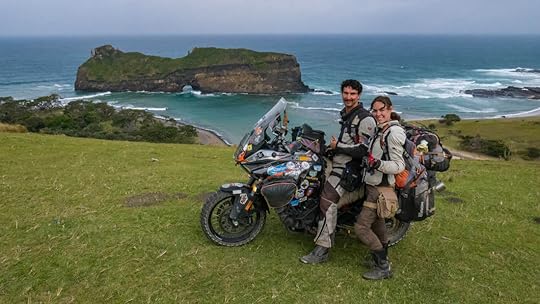 South Africa's long and beautiful coastline has some of the country's most developed regions, and much of it is filled with busy ports, fishing harbors, and beachside villas. But there is one remote stretch of shoreline where modern development never took hold, and it's appropriately named the Wild Coast.
South Africa's long and beautiful coastline has some of the country's most developed regions, and much of it is filled with busy ports, fishing harbors, and beachside villas. But there is one remote stretch of shoreline where modern development never took hold, and it's appropriately named the Wild Coast.
It's not the easiest place to navigate since the roads there are rugged and don't lead in a straight line, but with a name like the Wild Coast, we knew we had to go. And it turned out to be everything that we've been searching for.
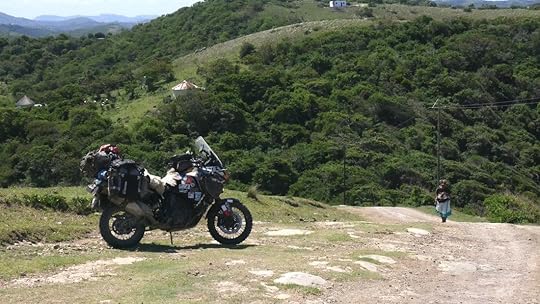 Our journey into the Wild Coast started with an invitation from our friend Peet who grew up in the region. He said he'd take us to some of his favorite spots, starting with what is rated the most beautiful campground in South Africa, Yellow Sands Caravan Park in East London. Situated on a bluff overlooking the ocean, I thought this was going to be the best campsite view on our Wild Coast trip. Ha!
Our journey into the Wild Coast started with an invitation from our friend Peet who grew up in the region. He said he'd take us to some of his favorite spots, starting with what is rated the most beautiful campground in South Africa, Yellow Sands Caravan Park in East London. Situated on a bluff overlooking the ocean, I thought this was going to be the best campsite view on our Wild Coast trip. Ha!  From East London we followed the main road, the N2, until we turned onto dirt at Ngaphezulu toward Mqanduli. That's also where Nelson Mandela grew up, and the Nelson Mandela Museum is situated in the town of Qunu, but was closed for construction when we were there.
From East London we followed the main road, the N2, until we turned onto dirt at Ngaphezulu toward Mqanduli. That's also where Nelson Mandela grew up, and the Nelson Mandela Museum is situated in the town of Qunu, but was closed for construction when we were there.
Once 0ff the N2, the adventure started. The road worsened, modernity disappeared, and we started seeing round houses with thatched roofs called rondavals (rond-AH-vals).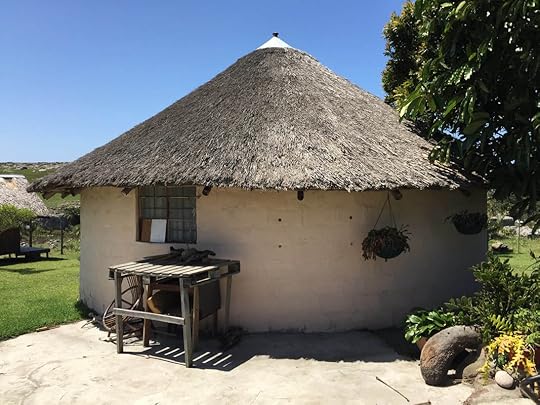 An example of a thatched rondaval. The Wild Coast is not “wild" in the sense that there are no people there. To the contrary, there are towns and villages everywhere, and locals live a very traditional pastoral lifestyle. In some ways, it feels like the “Africa" that I had been yearning to see. Colorfully-dressed women walk the roads with jugs of water balanced on their heads, children waved to us as we passed (and sometimes they threw rocks if they were feeling naughty, but the majority of them only sent us smiles), and you get a timeless feel to the landscape. There are practically no fences, and most animals roam freely (they especially love to be right in the middle of the road).
An example of a thatched rondaval. The Wild Coast is not “wild" in the sense that there are no people there. To the contrary, there are towns and villages everywhere, and locals live a very traditional pastoral lifestyle. In some ways, it feels like the “Africa" that I had been yearning to see. Colorfully-dressed women walk the roads with jugs of water balanced on their heads, children waved to us as we passed (and sometimes they threw rocks if they were feeling naughty, but the majority of them only sent us smiles), and you get a timeless feel to the landscape. There are practically no fences, and most animals roam freely (they especially love to be right in the middle of the road).
As we wound our way through the rural green hills, at last we came to the blue strip of coast, and were greeted with an incredible natural spectacle called Hole in the Wall. This mighty cliff of rock standing just offshore has been beaten by the waves for so long, that a hole right in its center has been punched out. Like an enormous archway leading into an oceanic palace, it was dramatic to watch the water surge through the rocks with all its splashes of foam.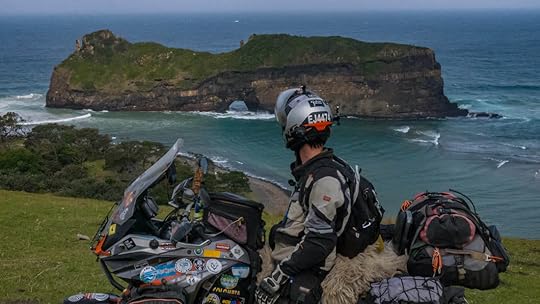 Hole in the Wall near Coffee Bay, Wild Coast, South Africa. We camped that night at a beachside caravan park in the town of Coffee Bay, where we pitched our tent under some gnarly jungle trees and watched the orange full moon rise as the night insects chirped.
Hole in the Wall near Coffee Bay, Wild Coast, South Africa. We camped that night at a beachside caravan park in the town of Coffee Bay, where we pitched our tent under some gnarly jungle trees and watched the orange full moon rise as the night insects chirped.
The next day was going to be one of our toughest as we wanted to get to the town of Port St. Johns from Coffee Bay by only taking the backroads along the coast. Actually, there is no road that goes along the coast, so we sort of just made up our path as we went along.
The roads in this area can be in very poor condition, some with deep ruts and cavernous washouts. But Tim skillfully maneuvered our heavy bike over big rocks and across rivers where the bridges were washed out. A typical road of the Wild Coast. At one point, Google Maps said there was no way through and we were concerned we'd have to backtrack. So we asked two guys in a 4WD truck for directions; they were shirtless with a cloud of pot smoke wafting out from their windows, and marijuana plants crowding out the back seat. They told us the quickest way was through the sand on the beach, but when we said we weren't too keen on deep sand with our fully-loaded motorcycle, they instructed us on how to avoid the beach.
A typical road of the Wild Coast. At one point, Google Maps said there was no way through and we were concerned we'd have to backtrack. So we asked two guys in a 4WD truck for directions; they were shirtless with a cloud of pot smoke wafting out from their windows, and marijuana plants crowding out the back seat. They told us the quickest way was through the sand on the beach, but when we said we weren't too keen on deep sand with our fully-loaded motorcycle, they instructed us on how to avoid the beach.
Their directions led us down tracks through the forest, but now we were off any squiggly road known to Google or any of our other GPS apps. Truly in no-man's territory. Moreover, I was a bit concerned that these two stoned gentlemen didn't really know what they were talking about, and were sending us to nowhere. But amazingly, the road did go through, and suddenly the jungle opened up, and a proper dirt road was in front of us. We had made it back to civilization. This was our route through the Transkei to Port St Johns, South Africa. The pavement started near Port St. Johns, and we were stopped there for lunch when someone in the restaurant said in an American accent, “Hey, are you two on that motorcycle?" And low and behold, we met our first fellow motorcycle overlander, an American who is also riding through Africa!
This was our route through the Transkei to Port St Johns, South Africa. The pavement started near Port St. Johns, and we were stopped there for lunch when someone in the restaurant said in an American accent, “Hey, are you two on that motorcycle?" And low and behold, we met our first fellow motorcycle overlander, an American who is also riding through Africa!
Emiliano is his name, and we immediately made plans to meet back up the next day at our camp: a rugged set of structures built into nature called Mbotyi Mountain Bush Camp. Mbotyi Camp (pronounced like mboy-key) turned into our home base for the next few days as we explored the waterfalls, caves, and extremely terrible roads of the region. Even getting up to the camp was a challenge, but a welcome one. After all, this is what we came to the Wild Coast for: to get off the beaten path. And we sure did that as our guide, Jan, showed us around the area on roads that were carved out by Jeeps, and other “roads" that didn't really exist at all.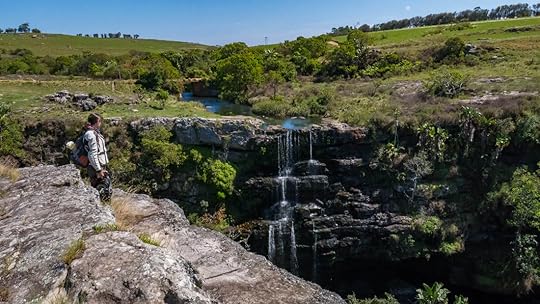 Me (Marisa) in front of Little Angel Falls.
Me (Marisa) in front of Little Angel Falls.  Magwa Falls, South Africa But perhaps my favorite part of our Wild Coast tour was when we wild camped where the milkwood forest meets the rocky coast at a place called Lupatana. The road there was horrendous, but that's a good thing since I wouldn't want this place to become too “discovered". It was pure perfection: the knotted twists of the milkwood tree branches, the way the sunlight became golden through the leaves, and the little curious faces of Vervet Monkeys peeping out from the foliage, waiting for us to forget some food on the ground.
Magwa Falls, South Africa But perhaps my favorite part of our Wild Coast tour was when we wild camped where the milkwood forest meets the rocky coast at a place called Lupatana. The road there was horrendous, but that's a good thing since I wouldn't want this place to become too “discovered". It was pure perfection: the knotted twists of the milkwood tree branches, the way the sunlight became golden through the leaves, and the little curious faces of Vervet Monkeys peeping out from the foliage, waiting for us to forget some food on the ground.  The magical milkwood forest of Lupatana, South Africa.
The magical milkwood forest of Lupatana, South Africa. 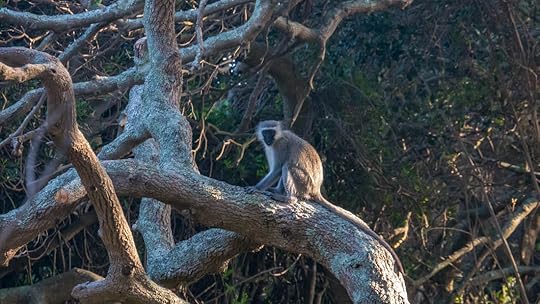 Vervet Monkeys were everywhere. But the ever-present sound of the ocean drew me out of the forest, where I suddenly found myself on a windswept beach of sand tucked between huge orange boulders. But I couldn't get distracted by the colorful stones for long, because just beyond the boulders, the ferocious crashing of enormous waves onto the shore's stone demanded all my attention. The “beach" here was like a cliff of rock that sharply drops into the sea, so whenever the waves are right, thunderous splashes are sent 30 or 40 feet in the air! It was a theatrical and symphonic drama of epic proportions playing out in front of me. I could have stood there and watched it for hours.
Vervet Monkeys were everywhere. But the ever-present sound of the ocean drew me out of the forest, where I suddenly found myself on a windswept beach of sand tucked between huge orange boulders. But I couldn't get distracted by the colorful stones for long, because just beyond the boulders, the ferocious crashing of enormous waves onto the shore's stone demanded all my attention. The “beach" here was like a cliff of rock that sharply drops into the sea, so whenever the waves are right, thunderous splashes are sent 30 or 40 feet in the air! It was a theatrical and symphonic drama of epic proportions playing out in front of me. I could have stood there and watched it for hours. 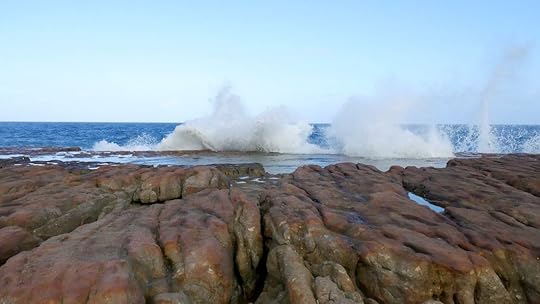 That night was one to remember. It was now Tim and me, Emiliano, Peet, and Jan, and we all laughed and told stories by the fire as Jan cooked up some of the largest steaks I've ever eaten. I don't even have words to describe what an incredible evening that was: great campsite, great weather, great food, and great company, what more could you ask for?
That night was one to remember. It was now Tim and me, Emiliano, Peet, and Jan, and we all laughed and told stories by the fire as Jan cooked up some of the largest steaks I've ever eaten. I don't even have words to describe what an incredible evening that was: great campsite, great weather, great food, and great company, what more could you ask for?
The next day we all set off for a hike along the coast where we came across the “Cave of Wonders" only accessible at low tide, and finally Waterfall Bluff, which is one of the only waterfalls in the world to spill directly into the sea. It was spectacular.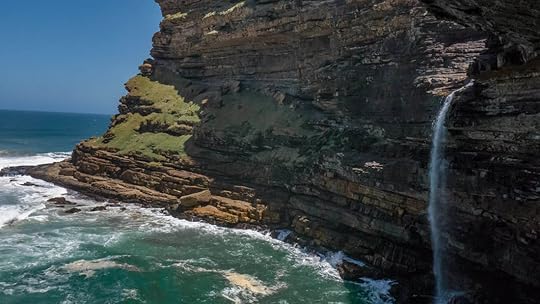 Waterfall Bluff, South Africa Unfortunately our time on the Wild Coast had to come to a close, and we said our goodbyes to our new friends and to the Indian Ocean for what will be a long while. We are now getting ready to head into a small country within South Africa called Lesotho (le-SU-tu), a kingdom of mountains that are said to touch the sky. Then we'll be exploring an area called Drakensberg, or Dragon Mountains... sounds pretty awesome.
Waterfall Bluff, South Africa Unfortunately our time on the Wild Coast had to come to a close, and we said our goodbyes to our new friends and to the Indian Ocean for what will be a long while. We are now getting ready to head into a small country within South Africa called Lesotho (le-SU-tu), a kingdom of mountains that are said to touch the sky. Then we'll be exploring an area called Drakensberg, or Dragon Mountains... sounds pretty awesome.
So stay tuned! Subscribe This week we would like to thank Jan for all his local expertise, great jokes, and incredible cooking skills, and to Emiliano for taking a risk on joining a few strangers on a crazy adventure. But most of all we want to thank Peet for allowing us to experience the wonders that he has known, for supporting us in so many incredible ways, and for being a true friend.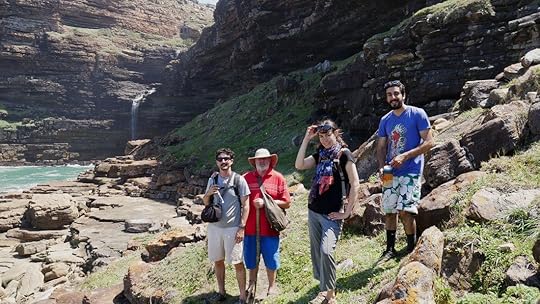 Tim, Peet, Marisa, and Emiliano
Tim, Peet, Marisa, and Emiliano
 South Africa's long and beautiful coastline has some of the country's most developed regions, and much of it is filled with busy ports, fishing harbors, and beachside villas. But there is one remote stretch of shoreline where modern development never took hold, and it's appropriately named the Wild Coast.
South Africa's long and beautiful coastline has some of the country's most developed regions, and much of it is filled with busy ports, fishing harbors, and beachside villas. But there is one remote stretch of shoreline where modern development never took hold, and it's appropriately named the Wild Coast.It's not the easiest place to navigate since the roads there are rugged and don't lead in a straight line, but with a name like the Wild Coast, we knew we had to go. And it turned out to be everything that we've been searching for.

 Our journey into the Wild Coast started with an invitation from our friend Peet who grew up in the region. He said he'd take us to some of his favorite spots, starting with what is rated the most beautiful campground in South Africa, Yellow Sands Caravan Park in East London. Situated on a bluff overlooking the ocean, I thought this was going to be the best campsite view on our Wild Coast trip. Ha!
Our journey into the Wild Coast started with an invitation from our friend Peet who grew up in the region. He said he'd take us to some of his favorite spots, starting with what is rated the most beautiful campground in South Africa, Yellow Sands Caravan Park in East London. Situated on a bluff overlooking the ocean, I thought this was going to be the best campsite view on our Wild Coast trip. Ha!  From East London we followed the main road, the N2, until we turned onto dirt at Ngaphezulu toward Mqanduli. That's also where Nelson Mandela grew up, and the Nelson Mandela Museum is situated in the town of Qunu, but was closed for construction when we were there.
From East London we followed the main road, the N2, until we turned onto dirt at Ngaphezulu toward Mqanduli. That's also where Nelson Mandela grew up, and the Nelson Mandela Museum is situated in the town of Qunu, but was closed for construction when we were there.Once 0ff the N2, the adventure started. The road worsened, modernity disappeared, and we started seeing round houses with thatched roofs called rondavals (rond-AH-vals).
 An example of a thatched rondaval. The Wild Coast is not “wild" in the sense that there are no people there. To the contrary, there are towns and villages everywhere, and locals live a very traditional pastoral lifestyle. In some ways, it feels like the “Africa" that I had been yearning to see. Colorfully-dressed women walk the roads with jugs of water balanced on their heads, children waved to us as we passed (and sometimes they threw rocks if they were feeling naughty, but the majority of them only sent us smiles), and you get a timeless feel to the landscape. There are practically no fences, and most animals roam freely (they especially love to be right in the middle of the road).
An example of a thatched rondaval. The Wild Coast is not “wild" in the sense that there are no people there. To the contrary, there are towns and villages everywhere, and locals live a very traditional pastoral lifestyle. In some ways, it feels like the “Africa" that I had been yearning to see. Colorfully-dressed women walk the roads with jugs of water balanced on their heads, children waved to us as we passed (and sometimes they threw rocks if they were feeling naughty, but the majority of them only sent us smiles), and you get a timeless feel to the landscape. There are practically no fences, and most animals roam freely (they especially love to be right in the middle of the road). As we wound our way through the rural green hills, at last we came to the blue strip of coast, and were greeted with an incredible natural spectacle called Hole in the Wall. This mighty cliff of rock standing just offshore has been beaten by the waves for so long, that a hole right in its center has been punched out. Like an enormous archway leading into an oceanic palace, it was dramatic to watch the water surge through the rocks with all its splashes of foam.
 Hole in the Wall near Coffee Bay, Wild Coast, South Africa. We camped that night at a beachside caravan park in the town of Coffee Bay, where we pitched our tent under some gnarly jungle trees and watched the orange full moon rise as the night insects chirped.
Hole in the Wall near Coffee Bay, Wild Coast, South Africa. We camped that night at a beachside caravan park in the town of Coffee Bay, where we pitched our tent under some gnarly jungle trees and watched the orange full moon rise as the night insects chirped. The next day was going to be one of our toughest as we wanted to get to the town of Port St. Johns from Coffee Bay by only taking the backroads along the coast. Actually, there is no road that goes along the coast, so we sort of just made up our path as we went along.
The roads in this area can be in very poor condition, some with deep ruts and cavernous washouts. But Tim skillfully maneuvered our heavy bike over big rocks and across rivers where the bridges were washed out.
 A typical road of the Wild Coast. At one point, Google Maps said there was no way through and we were concerned we'd have to backtrack. So we asked two guys in a 4WD truck for directions; they were shirtless with a cloud of pot smoke wafting out from their windows, and marijuana plants crowding out the back seat. They told us the quickest way was through the sand on the beach, but when we said we weren't too keen on deep sand with our fully-loaded motorcycle, they instructed us on how to avoid the beach.
A typical road of the Wild Coast. At one point, Google Maps said there was no way through and we were concerned we'd have to backtrack. So we asked two guys in a 4WD truck for directions; they were shirtless with a cloud of pot smoke wafting out from their windows, and marijuana plants crowding out the back seat. They told us the quickest way was through the sand on the beach, but when we said we weren't too keen on deep sand with our fully-loaded motorcycle, they instructed us on how to avoid the beach.Their directions led us down tracks through the forest, but now we were off any squiggly road known to Google or any of our other GPS apps. Truly in no-man's territory. Moreover, I was a bit concerned that these two stoned gentlemen didn't really know what they were talking about, and were sending us to nowhere. But amazingly, the road did go through, and suddenly the jungle opened up, and a proper dirt road was in front of us. We had made it back to civilization.
 This was our route through the Transkei to Port St Johns, South Africa. The pavement started near Port St. Johns, and we were stopped there for lunch when someone in the restaurant said in an American accent, “Hey, are you two on that motorcycle?" And low and behold, we met our first fellow motorcycle overlander, an American who is also riding through Africa!
This was our route through the Transkei to Port St Johns, South Africa. The pavement started near Port St. Johns, and we were stopped there for lunch when someone in the restaurant said in an American accent, “Hey, are you two on that motorcycle?" And low and behold, we met our first fellow motorcycle overlander, an American who is also riding through Africa!Emiliano is his name, and we immediately made plans to meet back up the next day at our camp: a rugged set of structures built into nature called Mbotyi Mountain Bush Camp. Mbotyi Camp (pronounced like mboy-key) turned into our home base for the next few days as we explored the waterfalls, caves, and extremely terrible roads of the region. Even getting up to the camp was a challenge, but a welcome one. After all, this is what we came to the Wild Coast for: to get off the beaten path. And we sure did that as our guide, Jan, showed us around the area on roads that were carved out by Jeeps, and other “roads" that didn't really exist at all.
 Me (Marisa) in front of Little Angel Falls.
Me (Marisa) in front of Little Angel Falls.  Magwa Falls, South Africa But perhaps my favorite part of our Wild Coast tour was when we wild camped where the milkwood forest meets the rocky coast at a place called Lupatana. The road there was horrendous, but that's a good thing since I wouldn't want this place to become too “discovered". It was pure perfection: the knotted twists of the milkwood tree branches, the way the sunlight became golden through the leaves, and the little curious faces of Vervet Monkeys peeping out from the foliage, waiting for us to forget some food on the ground.
Magwa Falls, South Africa But perhaps my favorite part of our Wild Coast tour was when we wild camped where the milkwood forest meets the rocky coast at a place called Lupatana. The road there was horrendous, but that's a good thing since I wouldn't want this place to become too “discovered". It was pure perfection: the knotted twists of the milkwood tree branches, the way the sunlight became golden through the leaves, and the little curious faces of Vervet Monkeys peeping out from the foliage, waiting for us to forget some food on the ground.  The magical milkwood forest of Lupatana, South Africa.
The magical milkwood forest of Lupatana, South Africa.  Vervet Monkeys were everywhere. But the ever-present sound of the ocean drew me out of the forest, where I suddenly found myself on a windswept beach of sand tucked between huge orange boulders. But I couldn't get distracted by the colorful stones for long, because just beyond the boulders, the ferocious crashing of enormous waves onto the shore's stone demanded all my attention. The “beach" here was like a cliff of rock that sharply drops into the sea, so whenever the waves are right, thunderous splashes are sent 30 or 40 feet in the air! It was a theatrical and symphonic drama of epic proportions playing out in front of me. I could have stood there and watched it for hours.
Vervet Monkeys were everywhere. But the ever-present sound of the ocean drew me out of the forest, where I suddenly found myself on a windswept beach of sand tucked between huge orange boulders. But I couldn't get distracted by the colorful stones for long, because just beyond the boulders, the ferocious crashing of enormous waves onto the shore's stone demanded all my attention. The “beach" here was like a cliff of rock that sharply drops into the sea, so whenever the waves are right, thunderous splashes are sent 30 or 40 feet in the air! It was a theatrical and symphonic drama of epic proportions playing out in front of me. I could have stood there and watched it for hours.  That night was one to remember. It was now Tim and me, Emiliano, Peet, and Jan, and we all laughed and told stories by the fire as Jan cooked up some of the largest steaks I've ever eaten. I don't even have words to describe what an incredible evening that was: great campsite, great weather, great food, and great company, what more could you ask for?
That night was one to remember. It was now Tim and me, Emiliano, Peet, and Jan, and we all laughed and told stories by the fire as Jan cooked up some of the largest steaks I've ever eaten. I don't even have words to describe what an incredible evening that was: great campsite, great weather, great food, and great company, what more could you ask for?The next day we all set off for a hike along the coast where we came across the “Cave of Wonders" only accessible at low tide, and finally Waterfall Bluff, which is one of the only waterfalls in the world to spill directly into the sea. It was spectacular.
 Waterfall Bluff, South Africa Unfortunately our time on the Wild Coast had to come to a close, and we said our goodbyes to our new friends and to the Indian Ocean for what will be a long while. We are now getting ready to head into a small country within South Africa called Lesotho (le-SU-tu), a kingdom of mountains that are said to touch the sky. Then we'll be exploring an area called Drakensberg, or Dragon Mountains... sounds pretty awesome.
Waterfall Bluff, South Africa Unfortunately our time on the Wild Coast had to come to a close, and we said our goodbyes to our new friends and to the Indian Ocean for what will be a long while. We are now getting ready to head into a small country within South Africa called Lesotho (le-SU-tu), a kingdom of mountains that are said to touch the sky. Then we'll be exploring an area called Drakensberg, or Dragon Mountains... sounds pretty awesome.So stay tuned! Subscribe This week we would like to thank Jan for all his local expertise, great jokes, and incredible cooking skills, and to Emiliano for taking a risk on joining a few strangers on a crazy adventure. But most of all we want to thank Peet for allowing us to experience the wonders that he has known, for supporting us in so many incredible ways, and for being a true friend.
 Tim, Peet, Marisa, and Emiliano
Tim, Peet, Marisa, and Emiliano
Published on October 17, 2019 22:26
September 24, 2019
5 Lessons from South Africa
By Marisa  Bonus Lesson: Learning to successfully cross a river in Baviaanskloof Nature Reserve, SA. When we arrived at the airport in Cape Town, we were greeted with a huge sign on the wall that said, “Welcome to the Mother City." And as I stood there listening to the cacophony of strange languages being spoken around me, I immediately got the feeling that I had come to a special place, not just Cape Town, but Africa as a whole. I was reminded that it's an ancient land, the birthplace of humanity, mother to us all. Though I'd never been here before, I felt that in a strange way I was coming back to something, even it was just a deeper look within myself.
Bonus Lesson: Learning to successfully cross a river in Baviaanskloof Nature Reserve, SA. When we arrived at the airport in Cape Town, we were greeted with a huge sign on the wall that said, “Welcome to the Mother City." And as I stood there listening to the cacophony of strange languages being spoken around me, I immediately got the feeling that I had come to a special place, not just Cape Town, but Africa as a whole. I was reminded that it's an ancient land, the birthplace of humanity, mother to us all. Though I'd never been here before, I felt that in a strange way I was coming back to something, even it was just a deeper look within myself. 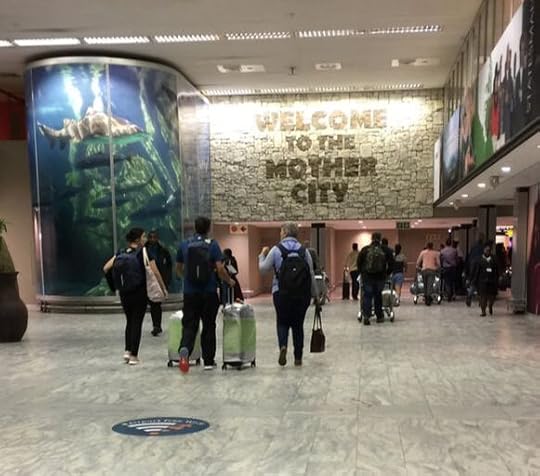 The airport in Cape Town, South Africa. It could have just been the jet-lag, but I stood there like a child, gaping around me wide-eyed and curious. And I got the feeling that South Africa had a lot to teach me.
The airport in Cape Town, South Africa. It could have just been the jet-lag, but I stood there like a child, gaping around me wide-eyed and curious. And I got the feeling that South Africa had a lot to teach me.
It's been only a couple weeks, but so far, Tim and I have learned quite a bit. And the following are just a few of our first lessons that South Africa has taught us. Lesson 1 - Things are Upside-Down and Backwards From the airport, we hopped into a cab and immediately laughed when we saw the steering wheel on the wrong side of the car (alright, it's technically on the right side... but not the correct side). Of course I'd known that it was going to be like this in South Africa, but it's one thing to read about it, and another thing to sit in the taxi and watch the driver shift with his left hand. Tim gave me a look of, “Uh oh," showing me that he was also concerned about driving around on the motorcycle in this backwards world.
It took about a week (and a whole lot of expensive payments) to get our motorcycle successfully flown from Canada to South Africa, including a transfer in London. But at last we uncrated her in a warehouse in Cape Town, and there she was, sheepskin seat cover and all: our good old bike that had taken us through hell and back again, and was about to do it all again.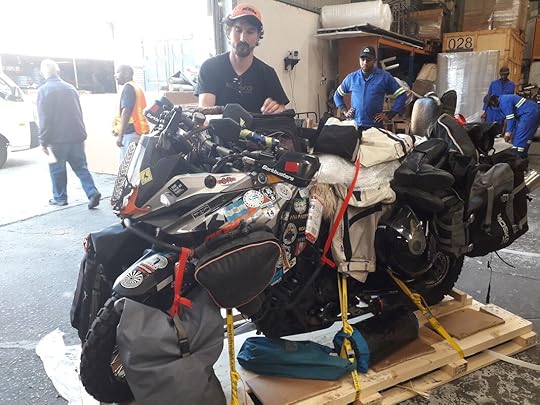 The bike was completely crated when it arrived from the airport. All our baggage had been gone through and several things had been taken (like my lotion, why!!!). But oh well, we were just happy to have her back. But when we hopped on and pulled out onto the street for the first time in South Africa, we suddenly felt completely disoriented as we had to now drive on the left-hand side of the road. Right turns were the dangerous ones, now crossing two directions of traffic, highway exits were on the left, and the right lane had become the passing lane. But the worst were roundabouts, which let's face it, are always confusing, but down here they go the other way!
The bike was completely crated when it arrived from the airport. All our baggage had been gone through and several things had been taken (like my lotion, why!!!). But oh well, we were just happy to have her back. But when we hopped on and pulled out onto the street for the first time in South Africa, we suddenly felt completely disoriented as we had to now drive on the left-hand side of the road. Right turns were the dangerous ones, now crossing two directions of traffic, highway exits were on the left, and the right lane had become the passing lane. But the worst were roundabouts, which let's face it, are always confusing, but down here they go the other way!
And it's not just roads that are backwards here. This is the southern hemisphere, so now the sun is always to the north, the ocean currents spin the other way, the seasons are opposite, and the other night as we were looking at the stars, we found the constellation of Orion (you can see him from both hemispheres near the horizon), and noticed that he was upside-down on his head! But I guess if you think about it, we're really the ones standing upside-down here at the bottom of the world. Lesson 2 - Tread Carefully It was our first morning in South Africa, and we were at our Airbnb in Cape Town. I made some hot water, poured myself a cup of the local sweet-smelling rooibus tea, and went to go sit in the garden to soak up some sun. But when I walked into the grass, I heard crrrunch under my shoe. I took another step, and that same horrible sound of snails dying came from every move I made. Slimy squished bodies and broken shells were now stuck to the soles of my shoes, and with horror, I looked around to find that there were snails everywhere! On the walls, the chairs, the table!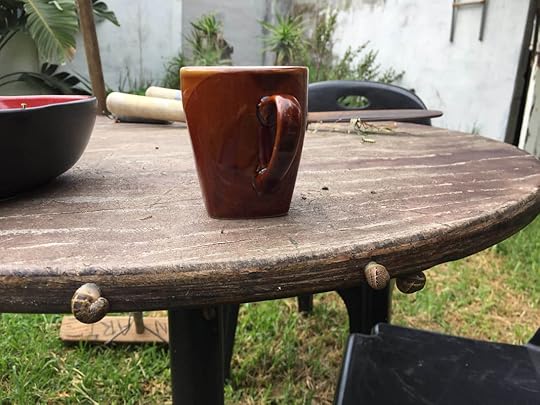 Snails are everywhere in South Africa. I thought maybe this was just an unfortunate infestation of this one particular garden, but no. Snails are all along the coastal regions of South Africa, land snails, ocean snails (periwinkles), and huge snails that people catch out of the sea and eat!
Snails are everywhere in South Africa. I thought maybe this was just an unfortunate infestation of this one particular garden, but no. Snails are all along the coastal regions of South Africa, land snails, ocean snails (periwinkles), and huge snails that people catch out of the sea and eat! 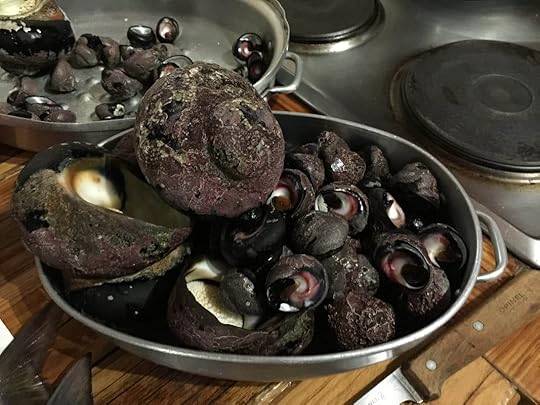 These periwinkles were caught at Betty's Bay, SA.
These periwinkles were caught at Betty's Bay, SA.  This mother-of-all snails was dinner that night. Cape Town turned out to be a great introduction to ZA (that's short for Zuid-Afrika, the Afrikaans name for South Africa) in that it's a vibrant melting pot of cultures. The buildings are colorful, the flowers on the trees are all in bloom (it's spring here), and the view of the steep and majestic Table Mountain can be seen around every corner. As we walked around town, we listened to the brazen laughter of women and the clicking sounds of the Xhosa language (pronounced KO-sa, except with a popping sound for the K which I can't make).
This mother-of-all snails was dinner that night. Cape Town turned out to be a great introduction to ZA (that's short for Zuid-Afrika, the Afrikaans name for South Africa) in that it's a vibrant melting pot of cultures. The buildings are colorful, the flowers on the trees are all in bloom (it's spring here), and the view of the steep and majestic Table Mountain can be seen around every corner. As we walked around town, we listened to the brazen laughter of women and the clicking sounds of the Xhosa language (pronounced KO-sa, except with a popping sound for the K which I can't make). 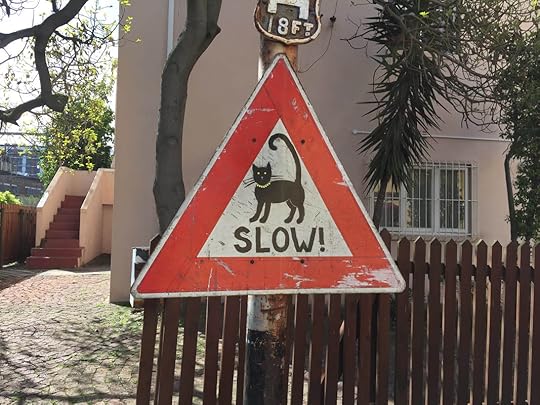 A delightful sign on the street in Observatory, Cape Town, SA. But it isn't all perfect, and we soon learned to tread carefully not just around snails. Sometimes we had to step around people sleeping on the street, or step over streams of urine running down the sidewalk. We also had to watch where we went, what parts of town we were in, and who was walking next to us, as theft is a real problem in Cape Town.
A delightful sign on the street in Observatory, Cape Town, SA. But it isn't all perfect, and we soon learned to tread carefully not just around snails. Sometimes we had to step around people sleeping on the street, or step over streams of urine running down the sidewalk. We also had to watch where we went, what parts of town we were in, and who was walking next to us, as theft is a real problem in Cape Town. 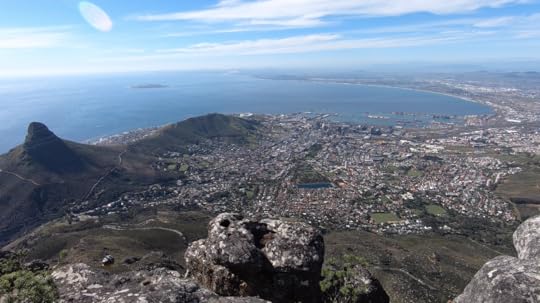 Cape Town sure looks peaceful from atop Table Mountain. But it is a little more hectic down below. It's not a blanket statement country-wide, but it's fair to say that parts of South Africa are not safe.
Cape Town sure looks peaceful from atop Table Mountain. But it is a little more hectic down below. It's not a blanket statement country-wide, but it's fair to say that parts of South Africa are not safe.
In 2018, the country had over 20,000 murders and had the most recorded rapes per capita in the world. And I know it's one thing to see these statistics or read the news and get freaked out because you've heard only the worst-case scenarios. But it's another thing to hear from the locals on a daily basis that we shouldn't walk around at night, that we should never wild camp, that we should never leave the bike alone, and at one beach we stopped at to take pictures, a fellow beach-goer warned us that we simply shouldn't be there and it would be best if we left right away.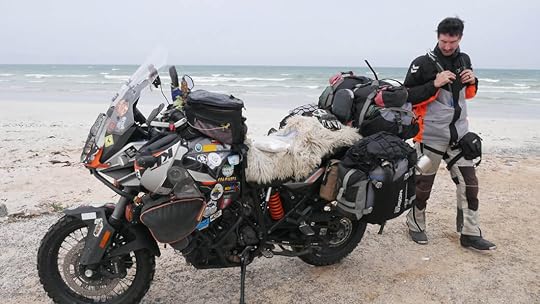 This beach outside of Cape Town seemed nice enough, until someone kindly warned us that we looked way too out of place to be hanging out there. South Africa has the highest rate of unemployment in the world. And much of that poverty, lack of skilled education, and severe unemployment is born out of a history of racial inequality. As an American, I understand what it's like to be from a country that struggles with getting past its historic times of oppression. For South Africa, those times were the Apartheid years, and their institutionalized racial segregation was much more recent than ours. From 1948 to 1991, South Africa was run by a caste system based on race which divided the country up into Whites, Indians (from India), Colored people (the term for mixed races), and Natives (blacks).
This beach outside of Cape Town seemed nice enough, until someone kindly warned us that we looked way too out of place to be hanging out there. South Africa has the highest rate of unemployment in the world. And much of that poverty, lack of skilled education, and severe unemployment is born out of a history of racial inequality. As an American, I understand what it's like to be from a country that struggles with getting past its historic times of oppression. For South Africa, those times were the Apartheid years, and their institutionalized racial segregation was much more recent than ours. From 1948 to 1991, South Africa was run by a caste system based on race which divided the country up into Whites, Indians (from India), Colored people (the term for mixed races), and Natives (blacks).
During Apartheid, the land was divided up according to this racial hierarchy, which has equated to a lasting disparity of only 7% of the population owning 70% of the land. As is the case in my own country, an imbalance like this is not easily fixed, and progress towards more economic equality has been painfully slow.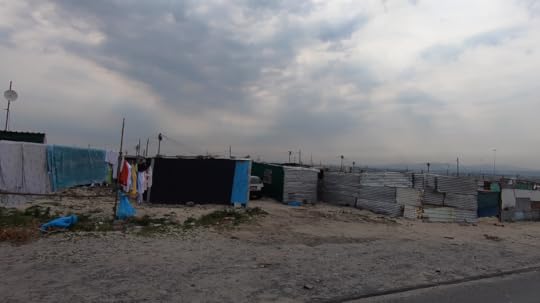 South Africa has glittering cities and gorgeous beaches, but there is another side of life out here as well. We got our first glimpse of the massive poverty in this country right outside of Cape Town when we passed a shanty town called Khaleyitsha, and it was appalling. I've seen people starving in India, men eating out of garbage heaps with chopsticks in China, and children standing in the freezing rain with nothing more than a shirt with holes in it in Bolivia. But I've never seen anything on this scale.
South Africa has glittering cities and gorgeous beaches, but there is another side of life out here as well. We got our first glimpse of the massive poverty in this country right outside of Cape Town when we passed a shanty town called Khaleyitsha, and it was appalling. I've seen people starving in India, men eating out of garbage heaps with chopsticks in China, and children standing in the freezing rain with nothing more than a shirt with holes in it in Bolivia. But I've never seen anything on this scale.
Corrugated metal houses for as far as the eye could see, electric wires held up by leaning poles, lines of laundry strung up between shelters, and dirt streets full of barefoot children and rusted cars with no tires. Actually this is nothing new, but it was the scale and permanence of it all that blew me away. Not hundreds, but thousands of these houses surrounded us, in every direction, over every hill there was more of the same. Nearly 400,000 people live in this shanty town alone, that's a sixth of all the people who live in the entire province of Western Cape!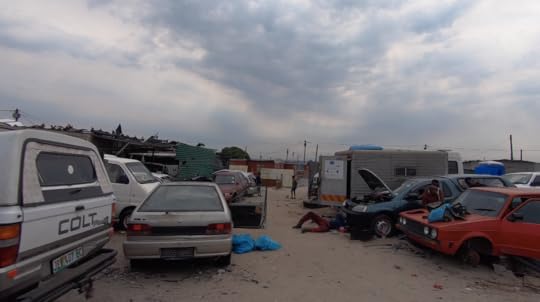 A typical street in the Khaleyitsha shanty town. Racial divides have been an issue in almost every nation in the world throughout history, and healing those wounds correctly is never an easy task to accomplish. So yes, everyone in South Africa may have gained their freedom 25 years ago, but that has not necessarily equated to economic prosperity. With a democratically-elected government accused of mass corruption and financial mismanagement, people are frustrated, and those who have nothing often take it out on those who have it all.
A typical street in the Khaleyitsha shanty town. Racial divides have been an issue in almost every nation in the world throughout history, and healing those wounds correctly is never an easy task to accomplish. So yes, everyone in South Africa may have gained their freedom 25 years ago, but that has not necessarily equated to economic prosperity. With a democratically-elected government accused of mass corruption and financial mismanagement, people are frustrated, and those who have nothing often take it out on those who have it all.
So no wild camping for us. No leaving our bike outside of pharmacies and grocery stores as we just pop in for a moment. But at the same time, we're determined to explore this incredible country, even if it must be done cautiously. Lesson 3 - Keep Your Eyes Open for Wildlife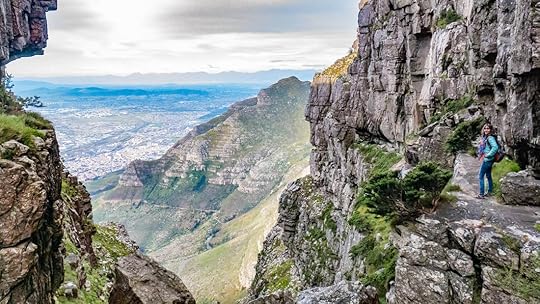 This was the trail down Table Mountain along the Platteklip Gorge, which means "flat rock" in Afrikaans. I'm not sure where it got that name since there was nothing flat about this trail. To me, the word Africa is synonymous with wild, and our first venture into the wild happened within South Africa's largest city, Cape Town. We had only been in the country a couple of days when we decided to go up Cape Town's most iconic spectacle, Table Mountain. So we jumped in a cable car which took us to the top, and soaked in the coastal views as we hiked around the mountain.
This was the trail down Table Mountain along the Platteklip Gorge, which means "flat rock" in Afrikaans. I'm not sure where it got that name since there was nothing flat about this trail. To me, the word Africa is synonymous with wild, and our first venture into the wild happened within South Africa's largest city, Cape Town. We had only been in the country a couple of days when we decided to go up Cape Town's most iconic spectacle, Table Mountain. So we jumped in a cable car which took us to the top, and soaked in the coastal views as we hiked around the mountain.
The top of Table Mountain felt like another world from the bustle of the city down below: it's cool up there, foggy, and covered in windswept grassy knolls and swampy bogs chirping in frogs. As we walked around, Tim suddenly pointed to three tiny antelope hopping amongst the bushes. They're called klipspringers, and they stood majestically on boulders, giving us long stares with their dark eyes, not like they were scared of us, but almost like they were just as curious in us and we were in them.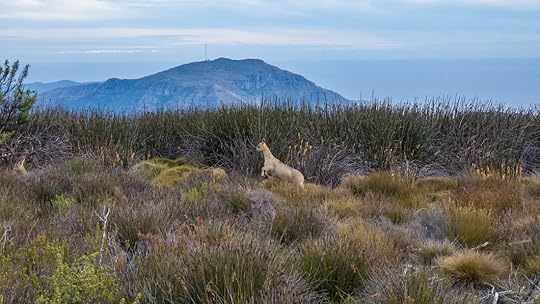 Klipspringer means “rock jumper" in Afrikaans. It was our first African wildlife spotting and we hadn't even left Cape Town! But that was just the beginning. Once we got our bike, we headed out around the Cape of Good Hope and along the southern coast where we saw African Penguins near Betty's Bay, land tortoises slowly crossing the road, mongooses running around the bushes, and rodent-looking mammals called rock hyraxes (locally known as Dassies). Strangely enough, these little guys happen to be the elephant's closest relative.
Klipspringer means “rock jumper" in Afrikaans. It was our first African wildlife spotting and we hadn't even left Cape Town! But that was just the beginning. Once we got our bike, we headed out around the Cape of Good Hope and along the southern coast where we saw African Penguins near Betty's Bay, land tortoises slowly crossing the road, mongooses running around the bushes, and rodent-looking mammals called rock hyraxes (locally known as Dassies). Strangely enough, these little guys happen to be the elephant's closest relative. 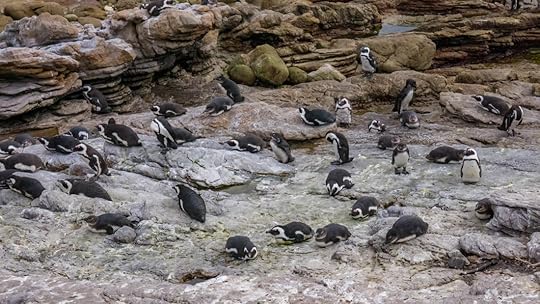 African Penguins!
African Penguins! 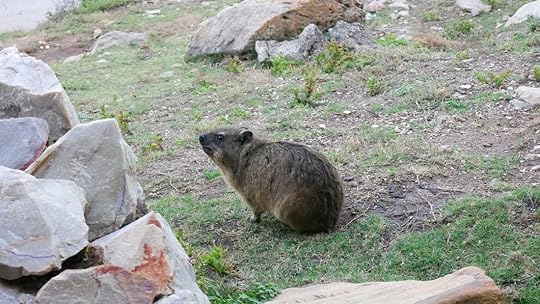 A Rock Hyrax, a.k.a. Dassie. But then we noticed signs on the road that said, “WARNING! Baboons are dangerous animals. Keep your windows up and doors locked." Doors locked? So baboons have figured out how to get in your car?! That didn't bode well for us on a motorcycle.
A Rock Hyrax, a.k.a. Dassie. But then we noticed signs on the road that said, “WARNING! Baboons are dangerous animals. Keep your windows up and doors locked." Doors locked? So baboons have figured out how to get in your car?! That didn't bode well for us on a motorcycle.
Sure enough, we did see baboons along the roads, lots of them. Baboons are ground-dwelling monkeys with short tails that live only in Africa and the Middle East. These ones we've seen have been Olive Baboons, known for their dog-like muzzles and long fangs. A bite from one of these is very bad news. People warned us of their aggressive tendencies, and once I googled Olive Baboons, I discovered that their real name is Papio anubis, named after Anubis, the Ancient Egyptian god of death and the underworld. Great.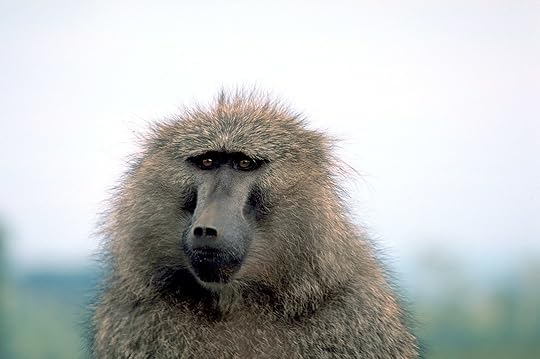 This is not our picture (thank you Wikicommons!) but we definitely didn't want to get close enough to an Olive Baboon to get this shot. Yeah, we decided to keep our distance from these guys, which is actually quite hard since they're on every backroad and even some major highways. I guess once you're in South Africa, you can't avoid the wildlife even if you wanted to. Lesson 4 - Don't Trust Your Eyes, Trust Your Nose
This is not our picture (thank you Wikicommons!) but we definitely didn't want to get close enough to an Olive Baboon to get this shot. Yeah, we decided to keep our distance from these guys, which is actually quite hard since they're on every backroad and even some major highways. I guess once you're in South Africa, you can't avoid the wildlife even if you wanted to. Lesson 4 - Don't Trust Your Eyes, Trust Your Nose 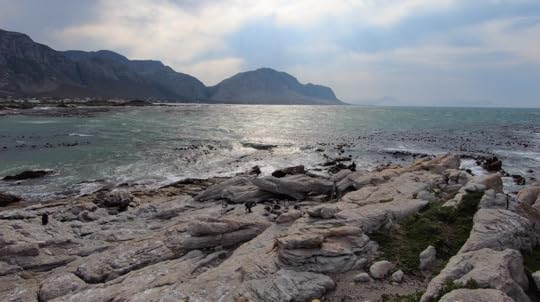 African Penguins at Stony Point Nature Reserve, Betty's Bay, SA. Out of the cities, South Africa's natural majesty really comes to life, and the amazing smells begin.
African Penguins at Stony Point Nature Reserve, Betty's Bay, SA. Out of the cities, South Africa's natural majesty really comes to life, and the amazing smells begin.
Driving through the hills and mountains along South Africa's southern coast has offered us some stunning views, and we very easily forgot where we were. Around the Cape of Good Hope and toward Cape L'Agulhas (the most southern tip of Africa), sometimes the mist hung over the cliffs and the cold ocean pounded the seashore rocks like we were somewhere off the coast of Ireland. I could smell the salty sea foam in the air, but after suddenly getting a whiff of wet fish, I recognized a new odor: the smell of penguins. And my vision of Ireland quickly faded as I watched a little black and white penguin waddle by.
On another occasion, we were on the winding dirt road of Swartberg Pass. The cliffs were beige and red with little patches of green thorny shrubbery along the streams and wetter valleys. With long and dusty views, I pictured myself in Utah, or New Mexico, but then our local friend handed us a dried sausage of Oryx meat (called Dröewors, DROO-eh-vorsh), and I let the smell of its wild-gamey saltiness soak into my nostrils, reminding me that this is definitely not like home. This is Africa.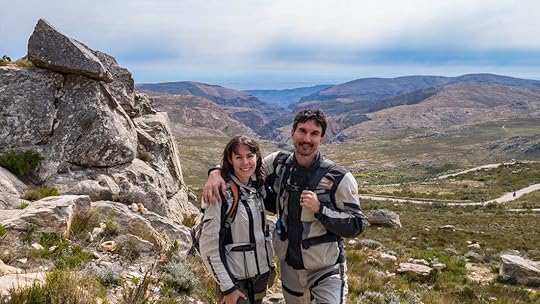 Tim and I at the top of Swartberg Pass, SA. Montagu Pass was another disorienting journey through an area that seemed to me like the Andes Mountains of Peru. It was a cold and rainy day (45˚F, 7˚C), and I could feel the wet chill in my bones as we slid our way along the gravel and mud of the Witfontein Mountains. Surrounding us were deciduous tress still in their leaf-less winter state, mossy and wet, and the ground was covered in emerald green ferns heavy with the spring rains. This couldn't have been the Africa that I had always pictured, no way. All my senses were telling me that this had to be somewhere else, Peru, or Canada maybe?
Tim and I at the top of Swartberg Pass, SA. Montagu Pass was another disorienting journey through an area that seemed to me like the Andes Mountains of Peru. It was a cold and rainy day (45˚F, 7˚C), and I could feel the wet chill in my bones as we slid our way along the gravel and mud of the Witfontein Mountains. Surrounding us were deciduous tress still in their leaf-less winter state, mossy and wet, and the ground was covered in emerald green ferns heavy with the spring rains. This couldn't have been the Africa that I had always pictured, no way. All my senses were telling me that this had to be somewhere else, Peru, or Canada maybe? 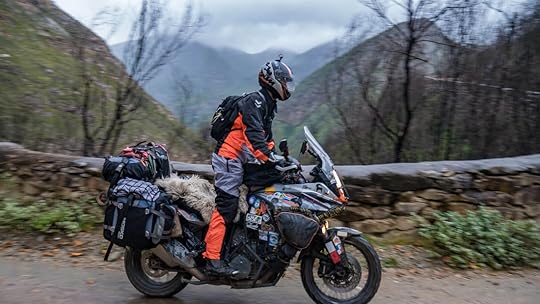 Tim riding through the rain of Montagu Pass, SA. And then there were the Cango Caves, a popular site near Oudtshoorn where people come from around the world to explore its underground mysteries. Inside it smelled dank and humid, like many people's breaths being trapped within wet stone. We went on the Adventure Tour, full of spelunking through tiny holes and crevices, one of which, called the Chimney, gave me a moment of panic as I thought I'd never get out again. I'm not sure they'd let any old person do this in the States without first taking their measurements because one guy in our group didn't make it through the last part (they were able to get him out by making him retrace his steps through the cave system).
Tim riding through the rain of Montagu Pass, SA. And then there were the Cango Caves, a popular site near Oudtshoorn where people come from around the world to explore its underground mysteries. Inside it smelled dank and humid, like many people's breaths being trapped within wet stone. We went on the Adventure Tour, full of spelunking through tiny holes and crevices, one of which, called the Chimney, gave me a moment of panic as I thought I'd never get out again. I'm not sure they'd let any old person do this in the States without first taking their measurements because one guy in our group didn't make it through the last part (they were able to get him out by making him retrace his steps through the cave system). 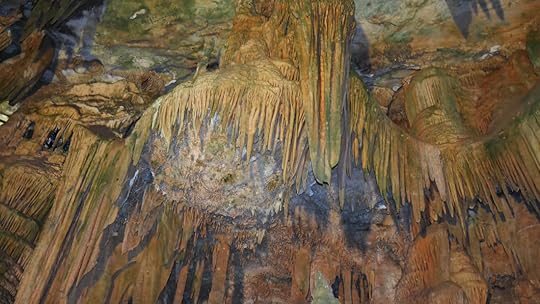 The ceiling in Cango Caves, SA.
The ceiling in Cango Caves, SA. 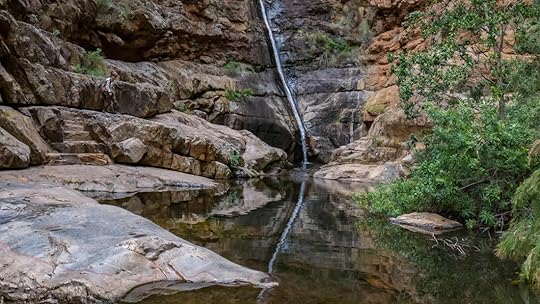 A beautiful waterfall outside the caves called Meiringspoort Waterfall.
A beautiful waterfall outside the caves called Meiringspoort Waterfall. 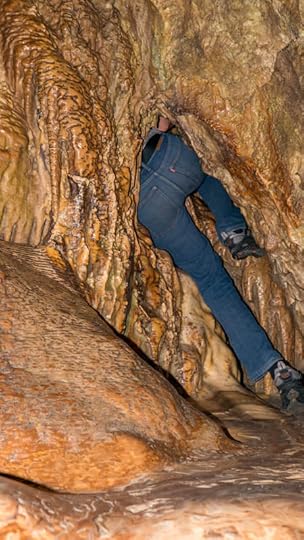 Tim going up the Chimney. But the strangest sensation was when we were off-roading through Baviaanskloof Nature Reserve (meaning “baboon ravine" in Afrikaans), and the cliffside scenery was rugged and wild, with names for the rock formations like Seven Dwarves (Sewe Dwarge) or Window Rock (Vensterklip). We could have been in the southern Rockies, or Nevada somewhere, but it wasn't until we camped that night at a “bush camp" that we got the feeling that we weren't in Kansas anywhere. After waking up to the sunrise sounds of many strange bird calls, some quacking like squeaky dog toys, some simply loud and repetitive, Tim got out of the tent and said, “Hey, you better come out and see this. There are monkeys everywhere!"
Tim going up the Chimney. But the strangest sensation was when we were off-roading through Baviaanskloof Nature Reserve (meaning “baboon ravine" in Afrikaans), and the cliffside scenery was rugged and wild, with names for the rock formations like Seven Dwarves (Sewe Dwarge) or Window Rock (Vensterklip). We could have been in the southern Rockies, or Nevada somewhere, but it wasn't until we camped that night at a “bush camp" that we got the feeling that we weren't in Kansas anywhere. After waking up to the sunrise sounds of many strange bird calls, some quacking like squeaky dog toys, some simply loud and repetitive, Tim got out of the tent and said, “Hey, you better come out and see this. There are monkeys everywhere!"
I had just been thinking that it smelled like a zoo. And sure enough there were monkeys in all the trees, mothers with babies, older males watching us with human-like eyes. They were Vervet Monkeys, all white except for their black faces. Unfortunately, we couldn't get any pictures of them, but it was a moment, and a smell, I won't soon forget.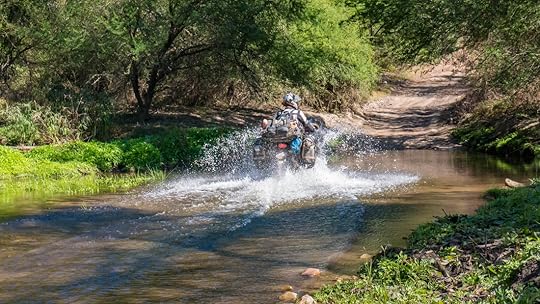 There were quite a few river crossings in the Baviaans, but Tim navigated them like a pro. Once we got out of the crazy off-road wilderness of the Baviaans (it was tough and Tim did not drop the bike, might I add!), we passed through farmlands towards Jeffrey's Bay, where we are now. And as we rode along Tim said to me through our helmet intercoms, “Do you smell that? It smells like our soap."
There were quite a few river crossings in the Baviaans, but Tim navigated them like a pro. Once we got out of the crazy off-road wilderness of the Baviaans (it was tough and Tim did not drop the bike, might I add!), we passed through farmlands towards Jeffrey's Bay, where we are now. And as we rode along Tim said to me through our helmet intercoms, “Do you smell that? It smells like our soap."
“Yes!" I said just as the smell hit me, just like the soap we kept in the bottom of our pannier. But was it melting from the heat of the bike? Or had somebody been wearing some intense perfume as we rode by? And then I realized it: orange blossoms! We were passing orange tree orchards and the tiny white blossoms made the whole region smell like a soapy perfume.
Tim and I sucked in the rich fragrance until all of a sudden we must have passed a cattle farm and both simultaneously went, “Ughhh!" at the putrid stench of manure. Not all the smells of South Africa are inviting. Lesson 5 - Learn to Braai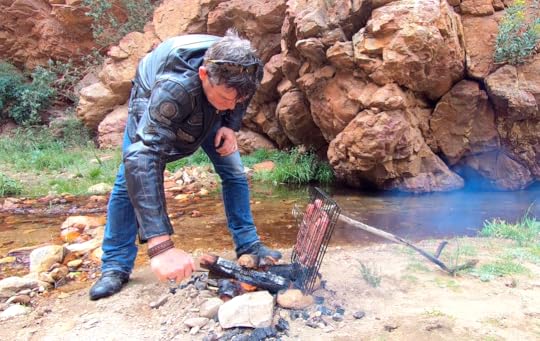 Here our friend Jaques is preparing a braai of boerewors sausage at a perfect picnic spot along the Swartberg Pass. South Africa has welcomed us with open arms in a way that exceeded even our highest expectations. Everywhere we've gone, we've met fellow motorcycle enthusiasts (many of whom have KTM's like ours), and they've invited us into their homes, onto their trails, and perhaps best of all, into their kitchens!
Here our friend Jaques is preparing a braai of boerewors sausage at a perfect picnic spot along the Swartberg Pass. South Africa has welcomed us with open arms in a way that exceeded even our highest expectations. Everywhere we've gone, we've met fellow motorcycle enthusiasts (many of whom have KTM's like ours), and they've invited us into their homes, onto their trails, and perhaps best of all, into their kitchens! 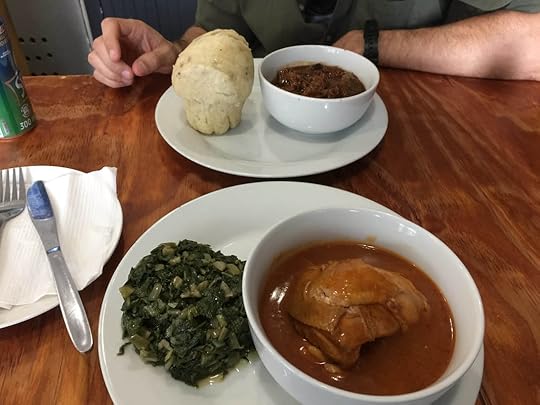 Here we both have flavorful curries and stews with a side of spinach and steamed bread, yum!
Here we both have flavorful curries and stews with a side of spinach and steamed bread, yum! 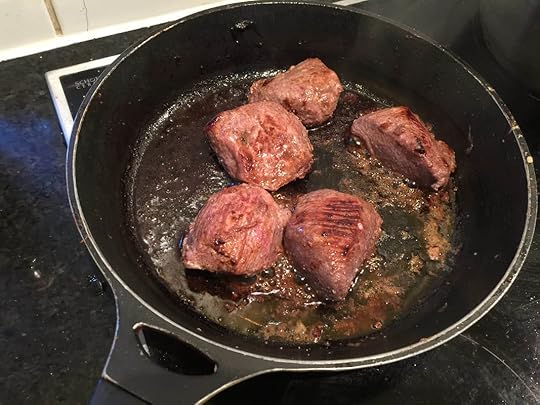 Anyone care for some ostrich steaks? They're delicious! South Africa's unique cultural mixing has led to some pretty amazing cuisine, from spicy curries, to Malaysian sweets, and even German breads. Add that to the mix of interesting animal products, such as ostrich egg omelets and kudu meat burgers (large antelope with twisted horns), and you've got yourself something very unique.
Anyone care for some ostrich steaks? They're delicious! South Africa's unique cultural mixing has led to some pretty amazing cuisine, from spicy curries, to Malaysian sweets, and even German breads. Add that to the mix of interesting animal products, such as ostrich egg omelets and kudu meat burgers (large antelope with twisted horns), and you've got yourself something very unique.
But most everything in South Africa revolves around braai, (said like try, but brai) which is the Afrikaans term for barbecuing over wood or coals (and who doesn't love that?). Last Tuesday was National Heritage Day in South Africa, but everyone told us they generally called it National Braai Day. Braai centers around barbecuing meat, such as boerewors (pronounced BOO-reh-vorsh, meaning farmer's sausage) which is a spiraled sausage of mostly beef and clove-like spices. But braaing can be done with any meat, and lamb chops is a regional favorite.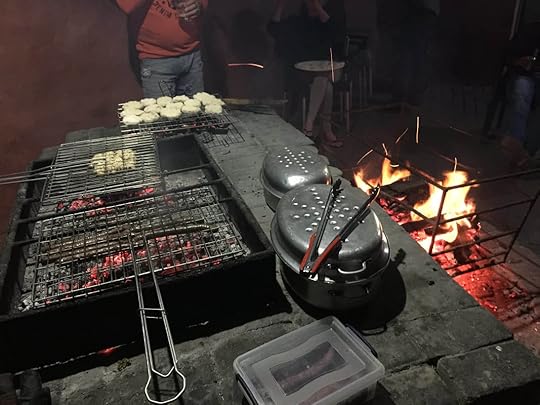 This is a great example of a South African braai. And vegetarians don't despair, because South Africans braai other things like bread rolls baked slowly over the coals called Roosterbrood (RUHster brood). And Braaibroodjie (brai broo-EE-kee) is a grilled cheese sandwich with tomato and onion... mmm. South African cuisine also includes other veg-friendly foods like pap, which is a traditional Bantu porridge made of corn, or my personal favorite word, chakalaka, which is a spicy side relish of beans or other veggies.
This is a great example of a South African braai. And vegetarians don't despair, because South Africans braai other things like bread rolls baked slowly over the coals called Roosterbrood (RUHster brood). And Braaibroodjie (brai broo-EE-kee) is a grilled cheese sandwich with tomato and onion... mmm. South African cuisine also includes other veg-friendly foods like pap, which is a traditional Bantu porridge made of corn, or my personal favorite word, chakalaka, which is a spicy side relish of beans or other veggies.
Basically, South African food has simply blown my tastebuds away, and I've been loving every bite of it. And I haven't even mentioned South African wine yet... Where We Went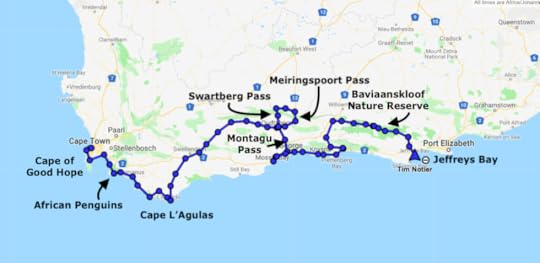 I can't believe we are still only in the very beginning of our African journey, because we've learned and seen so much, and still have so much more ahead of us to explore.
I can't believe we are still only in the very beginning of our African journey, because we've learned and seen so much, and still have so much more ahead of us to explore.
Next up we're heading along the Wild Coast toward the mysterious mountains of a little country known as the Kingdom in the Sky: Lesotho (I won't blame you if you haven't heard of it). So stay tuned! Subscribe to Our Blog This week we'd like to thank Jaques and Almarine for introducing us to braai and taking us on memorable rides, to Peet and Marenda for your generosity and route knowledge, Stephanie and Cornell for showing us the wonders of the coast, and for so many others who have welcomed us to their homes and helped us find these incredible roads.
And thank you to all of our readers! Keep following us, and we'll keep up with the adventures!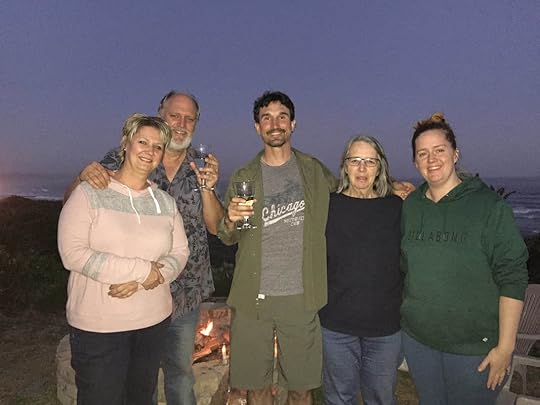 Thank you to everyone who has helped us on our journey so far!
Thank you to everyone who has helped us on our journey so far!
 Bonus Lesson: Learning to successfully cross a river in Baviaanskloof Nature Reserve, SA. When we arrived at the airport in Cape Town, we were greeted with a huge sign on the wall that said, “Welcome to the Mother City." And as I stood there listening to the cacophony of strange languages being spoken around me, I immediately got the feeling that I had come to a special place, not just Cape Town, but Africa as a whole. I was reminded that it's an ancient land, the birthplace of humanity, mother to us all. Though I'd never been here before, I felt that in a strange way I was coming back to something, even it was just a deeper look within myself.
Bonus Lesson: Learning to successfully cross a river in Baviaanskloof Nature Reserve, SA. When we arrived at the airport in Cape Town, we were greeted with a huge sign on the wall that said, “Welcome to the Mother City." And as I stood there listening to the cacophony of strange languages being spoken around me, I immediately got the feeling that I had come to a special place, not just Cape Town, but Africa as a whole. I was reminded that it's an ancient land, the birthplace of humanity, mother to us all. Though I'd never been here before, I felt that in a strange way I was coming back to something, even it was just a deeper look within myself.  The airport in Cape Town, South Africa. It could have just been the jet-lag, but I stood there like a child, gaping around me wide-eyed and curious. And I got the feeling that South Africa had a lot to teach me.
The airport in Cape Town, South Africa. It could have just been the jet-lag, but I stood there like a child, gaping around me wide-eyed and curious. And I got the feeling that South Africa had a lot to teach me. It's been only a couple weeks, but so far, Tim and I have learned quite a bit. And the following are just a few of our first lessons that South Africa has taught us. Lesson 1 - Things are Upside-Down and Backwards From the airport, we hopped into a cab and immediately laughed when we saw the steering wheel on the wrong side of the car (alright, it's technically on the right side... but not the correct side). Of course I'd known that it was going to be like this in South Africa, but it's one thing to read about it, and another thing to sit in the taxi and watch the driver shift with his left hand. Tim gave me a look of, “Uh oh," showing me that he was also concerned about driving around on the motorcycle in this backwards world.
It took about a week (and a whole lot of expensive payments) to get our motorcycle successfully flown from Canada to South Africa, including a transfer in London. But at last we uncrated her in a warehouse in Cape Town, and there she was, sheepskin seat cover and all: our good old bike that had taken us through hell and back again, and was about to do it all again.
 The bike was completely crated when it arrived from the airport. All our baggage had been gone through and several things had been taken (like my lotion, why!!!). But oh well, we were just happy to have her back. But when we hopped on and pulled out onto the street for the first time in South Africa, we suddenly felt completely disoriented as we had to now drive on the left-hand side of the road. Right turns were the dangerous ones, now crossing two directions of traffic, highway exits were on the left, and the right lane had become the passing lane. But the worst were roundabouts, which let's face it, are always confusing, but down here they go the other way!
The bike was completely crated when it arrived from the airport. All our baggage had been gone through and several things had been taken (like my lotion, why!!!). But oh well, we were just happy to have her back. But when we hopped on and pulled out onto the street for the first time in South Africa, we suddenly felt completely disoriented as we had to now drive on the left-hand side of the road. Right turns were the dangerous ones, now crossing two directions of traffic, highway exits were on the left, and the right lane had become the passing lane. But the worst were roundabouts, which let's face it, are always confusing, but down here they go the other way!And it's not just roads that are backwards here. This is the southern hemisphere, so now the sun is always to the north, the ocean currents spin the other way, the seasons are opposite, and the other night as we were looking at the stars, we found the constellation of Orion (you can see him from both hemispheres near the horizon), and noticed that he was upside-down on his head! But I guess if you think about it, we're really the ones standing upside-down here at the bottom of the world. Lesson 2 - Tread Carefully It was our first morning in South Africa, and we were at our Airbnb in Cape Town. I made some hot water, poured myself a cup of the local sweet-smelling rooibus tea, and went to go sit in the garden to soak up some sun. But when I walked into the grass, I heard crrrunch under my shoe. I took another step, and that same horrible sound of snails dying came from every move I made. Slimy squished bodies and broken shells were now stuck to the soles of my shoes, and with horror, I looked around to find that there were snails everywhere! On the walls, the chairs, the table!
 Snails are everywhere in South Africa. I thought maybe this was just an unfortunate infestation of this one particular garden, but no. Snails are all along the coastal regions of South Africa, land snails, ocean snails (periwinkles), and huge snails that people catch out of the sea and eat!
Snails are everywhere in South Africa. I thought maybe this was just an unfortunate infestation of this one particular garden, but no. Snails are all along the coastal regions of South Africa, land snails, ocean snails (periwinkles), and huge snails that people catch out of the sea and eat!  These periwinkles were caught at Betty's Bay, SA.
These periwinkles were caught at Betty's Bay, SA.  This mother-of-all snails was dinner that night. Cape Town turned out to be a great introduction to ZA (that's short for Zuid-Afrika, the Afrikaans name for South Africa) in that it's a vibrant melting pot of cultures. The buildings are colorful, the flowers on the trees are all in bloom (it's spring here), and the view of the steep and majestic Table Mountain can be seen around every corner. As we walked around town, we listened to the brazen laughter of women and the clicking sounds of the Xhosa language (pronounced KO-sa, except with a popping sound for the K which I can't make).
This mother-of-all snails was dinner that night. Cape Town turned out to be a great introduction to ZA (that's short for Zuid-Afrika, the Afrikaans name for South Africa) in that it's a vibrant melting pot of cultures. The buildings are colorful, the flowers on the trees are all in bloom (it's spring here), and the view of the steep and majestic Table Mountain can be seen around every corner. As we walked around town, we listened to the brazen laughter of women and the clicking sounds of the Xhosa language (pronounced KO-sa, except with a popping sound for the K which I can't make).  A delightful sign on the street in Observatory, Cape Town, SA. But it isn't all perfect, and we soon learned to tread carefully not just around snails. Sometimes we had to step around people sleeping on the street, or step over streams of urine running down the sidewalk. We also had to watch where we went, what parts of town we were in, and who was walking next to us, as theft is a real problem in Cape Town.
A delightful sign on the street in Observatory, Cape Town, SA. But it isn't all perfect, and we soon learned to tread carefully not just around snails. Sometimes we had to step around people sleeping on the street, or step over streams of urine running down the sidewalk. We also had to watch where we went, what parts of town we were in, and who was walking next to us, as theft is a real problem in Cape Town.  Cape Town sure looks peaceful from atop Table Mountain. But it is a little more hectic down below. It's not a blanket statement country-wide, but it's fair to say that parts of South Africa are not safe.
Cape Town sure looks peaceful from atop Table Mountain. But it is a little more hectic down below. It's not a blanket statement country-wide, but it's fair to say that parts of South Africa are not safe.In 2018, the country had over 20,000 murders and had the most recorded rapes per capita in the world. And I know it's one thing to see these statistics or read the news and get freaked out because you've heard only the worst-case scenarios. But it's another thing to hear from the locals on a daily basis that we shouldn't walk around at night, that we should never wild camp, that we should never leave the bike alone, and at one beach we stopped at to take pictures, a fellow beach-goer warned us that we simply shouldn't be there and it would be best if we left right away.
 This beach outside of Cape Town seemed nice enough, until someone kindly warned us that we looked way too out of place to be hanging out there. South Africa has the highest rate of unemployment in the world. And much of that poverty, lack of skilled education, and severe unemployment is born out of a history of racial inequality. As an American, I understand what it's like to be from a country that struggles with getting past its historic times of oppression. For South Africa, those times were the Apartheid years, and their institutionalized racial segregation was much more recent than ours. From 1948 to 1991, South Africa was run by a caste system based on race which divided the country up into Whites, Indians (from India), Colored people (the term for mixed races), and Natives (blacks).
This beach outside of Cape Town seemed nice enough, until someone kindly warned us that we looked way too out of place to be hanging out there. South Africa has the highest rate of unemployment in the world. And much of that poverty, lack of skilled education, and severe unemployment is born out of a history of racial inequality. As an American, I understand what it's like to be from a country that struggles with getting past its historic times of oppression. For South Africa, those times were the Apartheid years, and their institutionalized racial segregation was much more recent than ours. From 1948 to 1991, South Africa was run by a caste system based on race which divided the country up into Whites, Indians (from India), Colored people (the term for mixed races), and Natives (blacks).During Apartheid, the land was divided up according to this racial hierarchy, which has equated to a lasting disparity of only 7% of the population owning 70% of the land. As is the case in my own country, an imbalance like this is not easily fixed, and progress towards more economic equality has been painfully slow.
 South Africa has glittering cities and gorgeous beaches, but there is another side of life out here as well. We got our first glimpse of the massive poverty in this country right outside of Cape Town when we passed a shanty town called Khaleyitsha, and it was appalling. I've seen people starving in India, men eating out of garbage heaps with chopsticks in China, and children standing in the freezing rain with nothing more than a shirt with holes in it in Bolivia. But I've never seen anything on this scale.
South Africa has glittering cities and gorgeous beaches, but there is another side of life out here as well. We got our first glimpse of the massive poverty in this country right outside of Cape Town when we passed a shanty town called Khaleyitsha, and it was appalling. I've seen people starving in India, men eating out of garbage heaps with chopsticks in China, and children standing in the freezing rain with nothing more than a shirt with holes in it in Bolivia. But I've never seen anything on this scale.Corrugated metal houses for as far as the eye could see, electric wires held up by leaning poles, lines of laundry strung up between shelters, and dirt streets full of barefoot children and rusted cars with no tires. Actually this is nothing new, but it was the scale and permanence of it all that blew me away. Not hundreds, but thousands of these houses surrounded us, in every direction, over every hill there was more of the same. Nearly 400,000 people live in this shanty town alone, that's a sixth of all the people who live in the entire province of Western Cape!
 A typical street in the Khaleyitsha shanty town. Racial divides have been an issue in almost every nation in the world throughout history, and healing those wounds correctly is never an easy task to accomplish. So yes, everyone in South Africa may have gained their freedom 25 years ago, but that has not necessarily equated to economic prosperity. With a democratically-elected government accused of mass corruption and financial mismanagement, people are frustrated, and those who have nothing often take it out on those who have it all.
A typical street in the Khaleyitsha shanty town. Racial divides have been an issue in almost every nation in the world throughout history, and healing those wounds correctly is never an easy task to accomplish. So yes, everyone in South Africa may have gained their freedom 25 years ago, but that has not necessarily equated to economic prosperity. With a democratically-elected government accused of mass corruption and financial mismanagement, people are frustrated, and those who have nothing often take it out on those who have it all.So no wild camping for us. No leaving our bike outside of pharmacies and grocery stores as we just pop in for a moment. But at the same time, we're determined to explore this incredible country, even if it must be done cautiously. Lesson 3 - Keep Your Eyes Open for Wildlife
 This was the trail down Table Mountain along the Platteklip Gorge, which means "flat rock" in Afrikaans. I'm not sure where it got that name since there was nothing flat about this trail. To me, the word Africa is synonymous with wild, and our first venture into the wild happened within South Africa's largest city, Cape Town. We had only been in the country a couple of days when we decided to go up Cape Town's most iconic spectacle, Table Mountain. So we jumped in a cable car which took us to the top, and soaked in the coastal views as we hiked around the mountain.
This was the trail down Table Mountain along the Platteklip Gorge, which means "flat rock" in Afrikaans. I'm not sure where it got that name since there was nothing flat about this trail. To me, the word Africa is synonymous with wild, and our first venture into the wild happened within South Africa's largest city, Cape Town. We had only been in the country a couple of days when we decided to go up Cape Town's most iconic spectacle, Table Mountain. So we jumped in a cable car which took us to the top, and soaked in the coastal views as we hiked around the mountain.The top of Table Mountain felt like another world from the bustle of the city down below: it's cool up there, foggy, and covered in windswept grassy knolls and swampy bogs chirping in frogs. As we walked around, Tim suddenly pointed to three tiny antelope hopping amongst the bushes. They're called klipspringers, and they stood majestically on boulders, giving us long stares with their dark eyes, not like they were scared of us, but almost like they were just as curious in us and we were in them.
 Klipspringer means “rock jumper" in Afrikaans. It was our first African wildlife spotting and we hadn't even left Cape Town! But that was just the beginning. Once we got our bike, we headed out around the Cape of Good Hope and along the southern coast where we saw African Penguins near Betty's Bay, land tortoises slowly crossing the road, mongooses running around the bushes, and rodent-looking mammals called rock hyraxes (locally known as Dassies). Strangely enough, these little guys happen to be the elephant's closest relative.
Klipspringer means “rock jumper" in Afrikaans. It was our first African wildlife spotting and we hadn't even left Cape Town! But that was just the beginning. Once we got our bike, we headed out around the Cape of Good Hope and along the southern coast where we saw African Penguins near Betty's Bay, land tortoises slowly crossing the road, mongooses running around the bushes, and rodent-looking mammals called rock hyraxes (locally known as Dassies). Strangely enough, these little guys happen to be the elephant's closest relative.  African Penguins!
African Penguins!  A Rock Hyrax, a.k.a. Dassie. But then we noticed signs on the road that said, “WARNING! Baboons are dangerous animals. Keep your windows up and doors locked." Doors locked? So baboons have figured out how to get in your car?! That didn't bode well for us on a motorcycle.
A Rock Hyrax, a.k.a. Dassie. But then we noticed signs on the road that said, “WARNING! Baboons are dangerous animals. Keep your windows up and doors locked." Doors locked? So baboons have figured out how to get in your car?! That didn't bode well for us on a motorcycle.Sure enough, we did see baboons along the roads, lots of them. Baboons are ground-dwelling monkeys with short tails that live only in Africa and the Middle East. These ones we've seen have been Olive Baboons, known for their dog-like muzzles and long fangs. A bite from one of these is very bad news. People warned us of their aggressive tendencies, and once I googled Olive Baboons, I discovered that their real name is Papio anubis, named after Anubis, the Ancient Egyptian god of death and the underworld. Great.
 This is not our picture (thank you Wikicommons!) but we definitely didn't want to get close enough to an Olive Baboon to get this shot. Yeah, we decided to keep our distance from these guys, which is actually quite hard since they're on every backroad and even some major highways. I guess once you're in South Africa, you can't avoid the wildlife even if you wanted to. Lesson 4 - Don't Trust Your Eyes, Trust Your Nose
This is not our picture (thank you Wikicommons!) but we definitely didn't want to get close enough to an Olive Baboon to get this shot. Yeah, we decided to keep our distance from these guys, which is actually quite hard since they're on every backroad and even some major highways. I guess once you're in South Africa, you can't avoid the wildlife even if you wanted to. Lesson 4 - Don't Trust Your Eyes, Trust Your Nose  African Penguins at Stony Point Nature Reserve, Betty's Bay, SA. Out of the cities, South Africa's natural majesty really comes to life, and the amazing smells begin.
African Penguins at Stony Point Nature Reserve, Betty's Bay, SA. Out of the cities, South Africa's natural majesty really comes to life, and the amazing smells begin.
Driving through the hills and mountains along South Africa's southern coast has offered us some stunning views, and we very easily forgot where we were. Around the Cape of Good Hope and toward Cape L'Agulhas (the most southern tip of Africa), sometimes the mist hung over the cliffs and the cold ocean pounded the seashore rocks like we were somewhere off the coast of Ireland. I could smell the salty sea foam in the air, but after suddenly getting a whiff of wet fish, I recognized a new odor: the smell of penguins. And my vision of Ireland quickly faded as I watched a little black and white penguin waddle by.
On another occasion, we were on the winding dirt road of Swartberg Pass. The cliffs were beige and red with little patches of green thorny shrubbery along the streams and wetter valleys. With long and dusty views, I pictured myself in Utah, or New Mexico, but then our local friend handed us a dried sausage of Oryx meat (called Dröewors, DROO-eh-vorsh), and I let the smell of its wild-gamey saltiness soak into my nostrils, reminding me that this is definitely not like home. This is Africa.
 Tim and I at the top of Swartberg Pass, SA. Montagu Pass was another disorienting journey through an area that seemed to me like the Andes Mountains of Peru. It was a cold and rainy day (45˚F, 7˚C), and I could feel the wet chill in my bones as we slid our way along the gravel and mud of the Witfontein Mountains. Surrounding us were deciduous tress still in their leaf-less winter state, mossy and wet, and the ground was covered in emerald green ferns heavy with the spring rains. This couldn't have been the Africa that I had always pictured, no way. All my senses were telling me that this had to be somewhere else, Peru, or Canada maybe?
Tim and I at the top of Swartberg Pass, SA. Montagu Pass was another disorienting journey through an area that seemed to me like the Andes Mountains of Peru. It was a cold and rainy day (45˚F, 7˚C), and I could feel the wet chill in my bones as we slid our way along the gravel and mud of the Witfontein Mountains. Surrounding us were deciduous tress still in their leaf-less winter state, mossy and wet, and the ground was covered in emerald green ferns heavy with the spring rains. This couldn't have been the Africa that I had always pictured, no way. All my senses were telling me that this had to be somewhere else, Peru, or Canada maybe?  Tim riding through the rain of Montagu Pass, SA. And then there were the Cango Caves, a popular site near Oudtshoorn where people come from around the world to explore its underground mysteries. Inside it smelled dank and humid, like many people's breaths being trapped within wet stone. We went on the Adventure Tour, full of spelunking through tiny holes and crevices, one of which, called the Chimney, gave me a moment of panic as I thought I'd never get out again. I'm not sure they'd let any old person do this in the States without first taking their measurements because one guy in our group didn't make it through the last part (they were able to get him out by making him retrace his steps through the cave system).
Tim riding through the rain of Montagu Pass, SA. And then there were the Cango Caves, a popular site near Oudtshoorn where people come from around the world to explore its underground mysteries. Inside it smelled dank and humid, like many people's breaths being trapped within wet stone. We went on the Adventure Tour, full of spelunking through tiny holes and crevices, one of which, called the Chimney, gave me a moment of panic as I thought I'd never get out again. I'm not sure they'd let any old person do this in the States without first taking their measurements because one guy in our group didn't make it through the last part (they were able to get him out by making him retrace his steps through the cave system).  The ceiling in Cango Caves, SA.
The ceiling in Cango Caves, SA.  A beautiful waterfall outside the caves called Meiringspoort Waterfall.
A beautiful waterfall outside the caves called Meiringspoort Waterfall.  Tim going up the Chimney. But the strangest sensation was when we were off-roading through Baviaanskloof Nature Reserve (meaning “baboon ravine" in Afrikaans), and the cliffside scenery was rugged and wild, with names for the rock formations like Seven Dwarves (Sewe Dwarge) or Window Rock (Vensterklip). We could have been in the southern Rockies, or Nevada somewhere, but it wasn't until we camped that night at a “bush camp" that we got the feeling that we weren't in Kansas anywhere. After waking up to the sunrise sounds of many strange bird calls, some quacking like squeaky dog toys, some simply loud and repetitive, Tim got out of the tent and said, “Hey, you better come out and see this. There are monkeys everywhere!"
Tim going up the Chimney. But the strangest sensation was when we were off-roading through Baviaanskloof Nature Reserve (meaning “baboon ravine" in Afrikaans), and the cliffside scenery was rugged and wild, with names for the rock formations like Seven Dwarves (Sewe Dwarge) or Window Rock (Vensterklip). We could have been in the southern Rockies, or Nevada somewhere, but it wasn't until we camped that night at a “bush camp" that we got the feeling that we weren't in Kansas anywhere. After waking up to the sunrise sounds of many strange bird calls, some quacking like squeaky dog toys, some simply loud and repetitive, Tim got out of the tent and said, “Hey, you better come out and see this. There are monkeys everywhere!"I had just been thinking that it smelled like a zoo. And sure enough there were monkeys in all the trees, mothers with babies, older males watching us with human-like eyes. They were Vervet Monkeys, all white except for their black faces. Unfortunately, we couldn't get any pictures of them, but it was a moment, and a smell, I won't soon forget.
 There were quite a few river crossings in the Baviaans, but Tim navigated them like a pro. Once we got out of the crazy off-road wilderness of the Baviaans (it was tough and Tim did not drop the bike, might I add!), we passed through farmlands towards Jeffrey's Bay, where we are now. And as we rode along Tim said to me through our helmet intercoms, “Do you smell that? It smells like our soap."
There were quite a few river crossings in the Baviaans, but Tim navigated them like a pro. Once we got out of the crazy off-road wilderness of the Baviaans (it was tough and Tim did not drop the bike, might I add!), we passed through farmlands towards Jeffrey's Bay, where we are now. And as we rode along Tim said to me through our helmet intercoms, “Do you smell that? It smells like our soap."“Yes!" I said just as the smell hit me, just like the soap we kept in the bottom of our pannier. But was it melting from the heat of the bike? Or had somebody been wearing some intense perfume as we rode by? And then I realized it: orange blossoms! We were passing orange tree orchards and the tiny white blossoms made the whole region smell like a soapy perfume.
Tim and I sucked in the rich fragrance until all of a sudden we must have passed a cattle farm and both simultaneously went, “Ughhh!" at the putrid stench of manure. Not all the smells of South Africa are inviting. Lesson 5 - Learn to Braai
 Here our friend Jaques is preparing a braai of boerewors sausage at a perfect picnic spot along the Swartberg Pass. South Africa has welcomed us with open arms in a way that exceeded even our highest expectations. Everywhere we've gone, we've met fellow motorcycle enthusiasts (many of whom have KTM's like ours), and they've invited us into their homes, onto their trails, and perhaps best of all, into their kitchens!
Here our friend Jaques is preparing a braai of boerewors sausage at a perfect picnic spot along the Swartberg Pass. South Africa has welcomed us with open arms in a way that exceeded even our highest expectations. Everywhere we've gone, we've met fellow motorcycle enthusiasts (many of whom have KTM's like ours), and they've invited us into their homes, onto their trails, and perhaps best of all, into their kitchens!  Here we both have flavorful curries and stews with a side of spinach and steamed bread, yum!
Here we both have flavorful curries and stews with a side of spinach and steamed bread, yum!  Anyone care for some ostrich steaks? They're delicious! South Africa's unique cultural mixing has led to some pretty amazing cuisine, from spicy curries, to Malaysian sweets, and even German breads. Add that to the mix of interesting animal products, such as ostrich egg omelets and kudu meat burgers (large antelope with twisted horns), and you've got yourself something very unique.
Anyone care for some ostrich steaks? They're delicious! South Africa's unique cultural mixing has led to some pretty amazing cuisine, from spicy curries, to Malaysian sweets, and even German breads. Add that to the mix of interesting animal products, such as ostrich egg omelets and kudu meat burgers (large antelope with twisted horns), and you've got yourself something very unique.But most everything in South Africa revolves around braai, (said like try, but brai) which is the Afrikaans term for barbecuing over wood or coals (and who doesn't love that?). Last Tuesday was National Heritage Day in South Africa, but everyone told us they generally called it National Braai Day. Braai centers around barbecuing meat, such as boerewors (pronounced BOO-reh-vorsh, meaning farmer's sausage) which is a spiraled sausage of mostly beef and clove-like spices. But braaing can be done with any meat, and lamb chops is a regional favorite.
 This is a great example of a South African braai. And vegetarians don't despair, because South Africans braai other things like bread rolls baked slowly over the coals called Roosterbrood (RUHster brood). And Braaibroodjie (brai broo-EE-kee) is a grilled cheese sandwich with tomato and onion... mmm. South African cuisine also includes other veg-friendly foods like pap, which is a traditional Bantu porridge made of corn, or my personal favorite word, chakalaka, which is a spicy side relish of beans or other veggies.
This is a great example of a South African braai. And vegetarians don't despair, because South Africans braai other things like bread rolls baked slowly over the coals called Roosterbrood (RUHster brood). And Braaibroodjie (brai broo-EE-kee) is a grilled cheese sandwich with tomato and onion... mmm. South African cuisine also includes other veg-friendly foods like pap, which is a traditional Bantu porridge made of corn, or my personal favorite word, chakalaka, which is a spicy side relish of beans or other veggies.Basically, South African food has simply blown my tastebuds away, and I've been loving every bite of it. And I haven't even mentioned South African wine yet... Where We Went
 I can't believe we are still only in the very beginning of our African journey, because we've learned and seen so much, and still have so much more ahead of us to explore.
I can't believe we are still only in the very beginning of our African journey, because we've learned and seen so much, and still have so much more ahead of us to explore.Next up we're heading along the Wild Coast toward the mysterious mountains of a little country known as the Kingdom in the Sky: Lesotho (I won't blame you if you haven't heard of it). So stay tuned! Subscribe to Our Blog This week we'd like to thank Jaques and Almarine for introducing us to braai and taking us on memorable rides, to Peet and Marenda for your generosity and route knowledge, Stephanie and Cornell for showing us the wonders of the coast, and for so many others who have welcomed us to their homes and helped us find these incredible roads.
And thank you to all of our readers! Keep following us, and we'll keep up with the adventures!
 Thank you to everyone who has helped us on our journey so far!
Thank you to everyone who has helped us on our journey so far!
Published on September 24, 2019 03:38
September 15, 2019
The Journey to Africa
By Marisa 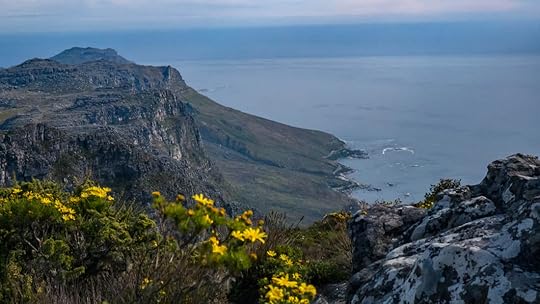 The Cape of Good Hope, South Africa I always say that the beginning of a journey is full of difficulties and obstacles, hurdles that you have to overcome before the real joy of the adventure can start. And the start to our African journey has been no different, though it's also been peppered with moments of joy and beauty. Leaving Home
The Cape of Good Hope, South Africa I always say that the beginning of a journey is full of difficulties and obstacles, hurdles that you have to overcome before the real joy of the adventure can start. And the start to our African journey has been no different, though it's also been peppered with moments of joy and beauty. Leaving Home 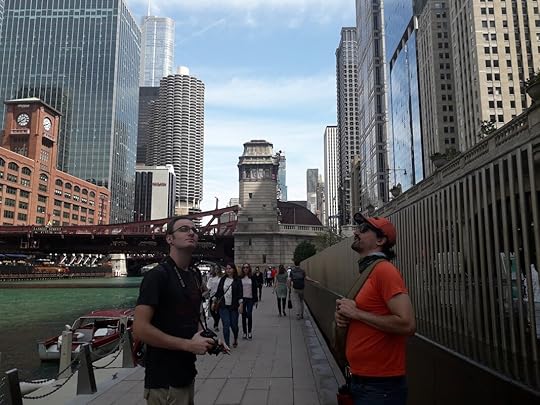 Our friend Justin and Tim soaking in our last day in Chicago. I find that traveling is full of meeting incredible people, but for every hello, there is always a goodbye. These meetings are usually brief, but meaningful, and farewells feel like little pinpricks stabbing at my chest. The smiles and generosity of these people from across the globe have left lasting touches on me, like fingerprints indented on my heart.
Our friend Justin and Tim soaking in our last day in Chicago. I find that traveling is full of meeting incredible people, but for every hello, there is always a goodbye. These meetings are usually brief, but meaningful, and farewells feel like little pinpricks stabbing at my chest. The smiles and generosity of these people from across the globe have left lasting touches on me, like fingerprints indented on my heart.
But as a traveler, I've become aware of the cyclical pattern of constantly leaving, of constantly saying hello and goodbye. And a part of me prepares myself, fortifies myself whenever I meet someone, because I know that I will soon be leaving them, and perhaps it will be the last time we meet. It's like a little hardened barrier I build up inside myself, always reminding me that this is temporary, and that all great things will come to an end.
Yet there is no barrier that I could build up within myself that would prepare me for saying goodbye to those who have been in my life throughout all the hard times: my family and close friends from home.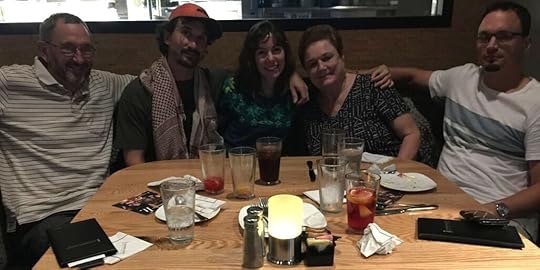 Tim and I with a few of the people we'll miss the most. This is of course the most difficult goodbye of them all. Though I know it's only temporary, the idea of being gone for an indefinite amount of time weighs heavily on me. Unlike last time, our trip to Africa has no end point, and I don't have a clear idea of when we'll be back since our plan sort of dead-ends when we get to Europe. By then, our savings will have run out and we'll be looking for work. What we find, where we'll end up, and when we'll get the funds to fly back are all unknowns.
Tim and I with a few of the people we'll miss the most. This is of course the most difficult goodbye of them all. Though I know it's only temporary, the idea of being gone for an indefinite amount of time weighs heavily on me. Unlike last time, our trip to Africa has no end point, and I don't have a clear idea of when we'll be back since our plan sort of dead-ends when we get to Europe. By then, our savings will have run out and we'll be looking for work. What we find, where we'll end up, and when we'll get the funds to fly back are all unknowns.
All we know for sure is that we're leaving for the other side of the world, and it's going to be a while before we find ourselves at home again. A long while.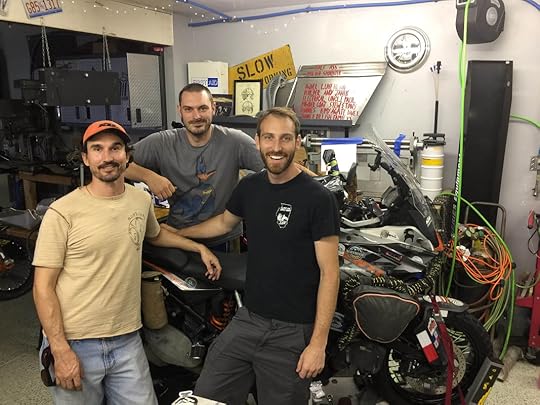 Tim with two guys who are equally skilled with mechanics as they are awesome people: Aaron Preisel and Andy Janik. There are so many people from home that we are thankful for and indebted to: from friends who have helped Tim with preparing the bike, to family who have housed us, fed us, and brought us laughter, and even strangers who have contributed to our travels. I hope that even if I can't thank each and every one of you individually here, that you know how grateful we truly are.
Tim with two guys who are equally skilled with mechanics as they are awesome people: Aaron Preisel and Andy Janik. There are so many people from home that we are thankful for and indebted to: from friends who have helped Tim with preparing the bike, to family who have housed us, fed us, and brought us laughter, and even strangers who have contributed to our travels. I hope that even if I can't thank each and every one of you individually here, that you know how grateful we truly are.
And so the day for us to leave came: September 4th, 2019. We packed up the bike, Tim petted his cat and hugged his dad with tears in their eyes, and we rode off with a wave and an unbearable heaviness in our chests. Riding to Montreal Our first step was to ride to Montréal, Canada where we would be flying ourselves and the bike out of. This is because flights for motorcycles are much cheaper from Canada than from the States, and Montréal offered the best deals for us.
It was only a few days' ride to Montréal from Chicago, and along the way we got to visit Tim's little sister in Michigan, as well as our motorcycle traveling friends Phil and Sapna near Toronto. We had first met them in Mexico and we crossed paths several times in Central and South America, so it was incredible to hang out with them in completely new surroundings, being able to once again share stories and reminisce.
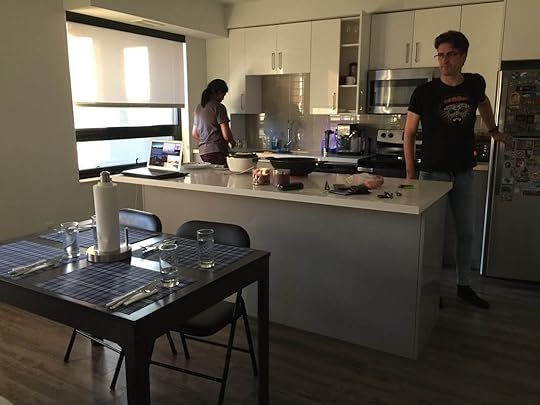 Sapna and Phil in their new home outside of Toronto. From Toronto, we headed to Montréal, which is Canada's second largest city and the largest city in its French-speaking quarter of Quebec. But being in Montréal meant business for us more than sight-seeing, since there were a lot of logistics, paperwork, and payments involved in getting the bike on a plane and then ourselves on another one.
Sapna and Phil in their new home outside of Toronto. From Toronto, we headed to Montréal, which is Canada's second largest city and the largest city in its French-speaking quarter of Quebec. But being in Montréal meant business for us more than sight-seeing, since there were a lot of logistics, paperwork, and payments involved in getting the bike on a plane and then ourselves on another one.
But North America wasn't going to let us leave without one last surprise.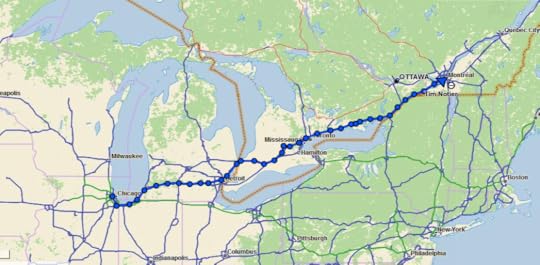 During our ride to Montreal, it's a shame we didn't have time to leave the highway more and see the sights. As we pulled up to our Airbnb near the Montréal airport, we saw a Triumph Tiger covered in stickers with UK plates: a fellow round-the-world motorcycle traveler! We immediately pulled up to inspect the bike and I noticed a world map sticker with the rider's route drawn onto it: from England through Europe, across the “Stans" in Central Asia, through China, Malaysia, around Australia, and then finally Alaska, Canada, the US.... wow! My mouth hung open at this guy's incredible journey, but then as the owner of the bike walked up to us, my mouth dropped even further when I realized the greatest shock of all.
During our ride to Montreal, it's a shame we didn't have time to leave the highway more and see the sights. As we pulled up to our Airbnb near the Montréal airport, we saw a Triumph Tiger covered in stickers with UK plates: a fellow round-the-world motorcycle traveler! We immediately pulled up to inspect the bike and I noticed a world map sticker with the rider's route drawn onto it: from England through Europe, across the “Stans" in Central Asia, through China, Malaysia, around Australia, and then finally Alaska, Canada, the US.... wow! My mouth hung open at this guy's incredible journey, but then as the owner of the bike walked up to us, my mouth dropped even further when I realized the greatest shock of all.
This world motorcycle traveler wasn't a guy at all, but a woman who had ridden it all alone!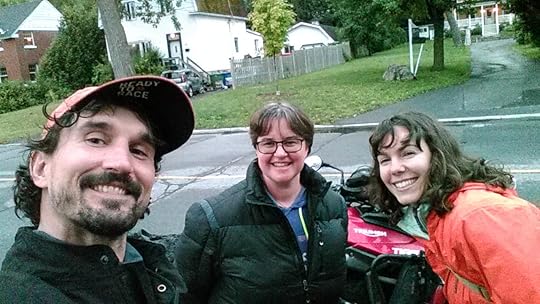 Tim, Caroline, and me with her Tiger in the background. Caroline Lunnen is her name (handle: funsmazwas), and she'd just spent 14 months riding around the world and this was to be her last day before flying back home! I couldn't believe our fortune, and we spent hours at dinner sharing stories, travel insights, and basically just bathing in the bliss of knowing that we were all the same type of crazy.
Tim, Caroline, and me with her Tiger in the background. Caroline Lunnen is her name (handle: funsmazwas), and she'd just spent 14 months riding around the world and this was to be her last day before flying back home! I couldn't believe our fortune, and we spent hours at dinner sharing stories, travel insights, and basically just bathing in the bliss of knowing that we were all the same type of crazy. 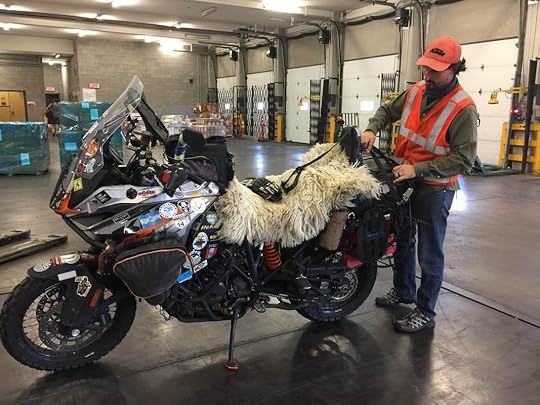 Tim preparing our KTM 1190 for its flight to South Africa. The next day, we brought our bike into the cargo area of the Montréal airport, weighed it with all its stuff on (we now know it's 323 kg), got our gear scanned, and said our goodbyes to the bike and almost everything we owned as the cargo crew got ready to fly it out to Heathrow. We took one last look at the bike, then hitched a cab to the departures terminal of the airport, and waited for our flight to Qatar.
Tim preparing our KTM 1190 for its flight to South Africa. The next day, we brought our bike into the cargo area of the Montréal airport, weighed it with all its stuff on (we now know it's 323 kg), got our gear scanned, and said our goodbyes to the bike and almost everything we owned as the cargo crew got ready to fly it out to Heathrow. We took one last look at the bike, then hitched a cab to the departures terminal of the airport, and waited for our flight to Qatar.
Since there are no direct flights from Canada to South Africa, we had to have a layover somewhere. The bike was taking a different path from us and would be transferring in London. But Tim and I were going to have a long layover in Qatar, and I was excited because my plan was to actually leave the airport and see something of the country. Qatar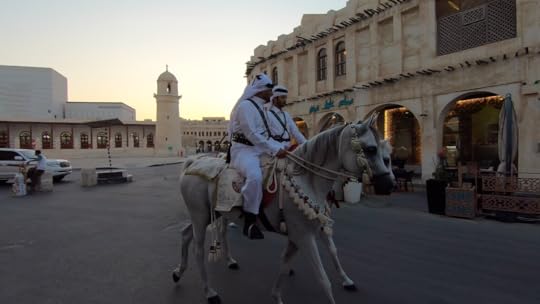 This was our first magical glimpse into this small, Arab country. After 12.5 hours of being cramped in a plane, we were not feeling our freshest when we arrived in the Persian Gulf country of Qatar (said like “cutter", but “kataar" is also accepted). And actually, the Doha airport turned out to be so nice, there was almost no reason to leave it (the best airport I've ever been to), but I'm so glad we did. Because our few hours in Qatar equated to a real feast for the senses.
This was our first magical glimpse into this small, Arab country. After 12.5 hours of being cramped in a plane, we were not feeling our freshest when we arrived in the Persian Gulf country of Qatar (said like “cutter", but “kataar" is also accepted). And actually, the Doha airport turned out to be so nice, there was almost no reason to leave it (the best airport I've ever been to), but I'm so glad we did. Because our few hours in Qatar equated to a real feast for the senses. 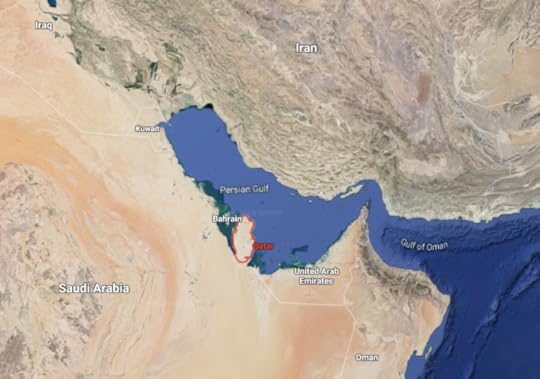 Qatar is a tiny oil-rich country sticking out like a thumb between Saudi Arabia and the Persian Gulf. Best known for its state-funded news network Al-Jazeera, and its award-winning airlines Qatar Airways, the country is ruled by a young king called Emir Tamim Al-Thani in an absolute monarchy.
Qatar is a tiny oil-rich country sticking out like a thumb between Saudi Arabia and the Persian Gulf. Best known for its state-funded news network Al-Jazeera, and its award-winning airlines Qatar Airways, the country is ruled by a young king called Emir Tamim Al-Thani in an absolute monarchy.
And although the majority of the people living there are not Qatari (88% are foreign workers coming mostly from India and Pakistan), Qataris are classified as the richest people on earth. Qatar will also be the host of the 2022 FIFA World Cup, which will mean it's the first Arab country to do so, but that honor has been tainted by allegations of bribery.
Soccer aside, because Doha is clean, safe, and was a historic port known for trading incense, silks, and Persian rugs, I had the feeling that I was going to enjoy visiting it.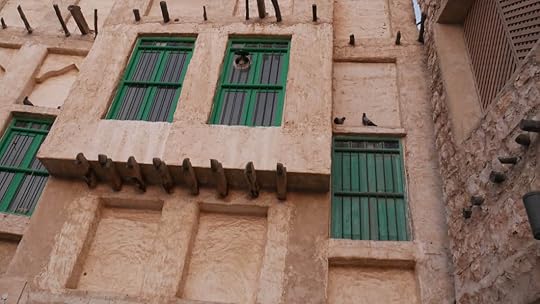 The beautiful buildings of Doha's old district. When we arrived in Qatar, it was nearly sunset and 95˚F outside (35˚C). But the heat didn't deter us as we got into a cab and headed toward the desert sunset. Rows of date trees lined the streets, silhouetted by the reddening sky behind them, and we passed one architecturally-unique building after the next: the National Museum of Qatar which looked like something found on a Star Wars set, and the Fanar Mosque, which resembled a spiral version of a tiered wedding cake.
The beautiful buildings of Doha's old district. When we arrived in Qatar, it was nearly sunset and 95˚F outside (35˚C). But the heat didn't deter us as we got into a cab and headed toward the desert sunset. Rows of date trees lined the streets, silhouetted by the reddening sky behind them, and we passed one architecturally-unique building after the next: the National Museum of Qatar which looked like something found on a Star Wars set, and the Fanar Mosque, which resembled a spiral version of a tiered wedding cake. 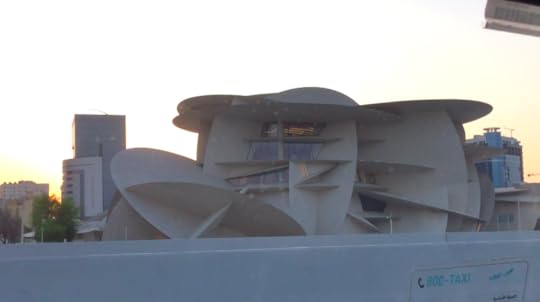 The National Museum of Qatar
The National Museum of Qatar 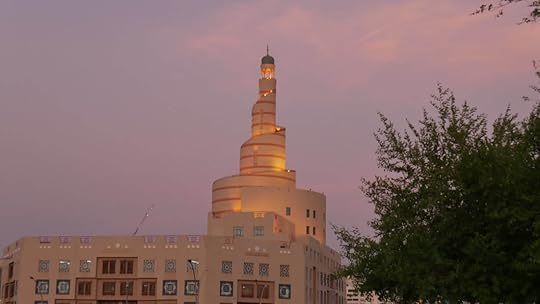 Fanar Mosque Finally we came to the oldest area of Doha, a market called Souq Waqif (locals pronounce it “soog WAAgif"), and it was an alluring tangle of covered walkways between stalls selling pyramidal stacks of colorful spices, exotic sweets dripping in glaze, and shimmering silk shawls. The pungent perfume of frankincense smoke wafted through the air, vendors would call out their wares and prices, and women in full abayas of black with nothing but their eyes showing would peruse through the winding alleys.
Fanar Mosque Finally we came to the oldest area of Doha, a market called Souq Waqif (locals pronounce it “soog WAAgif"), and it was an alluring tangle of covered walkways between stalls selling pyramidal stacks of colorful spices, exotic sweets dripping in glaze, and shimmering silk shawls. The pungent perfume of frankincense smoke wafted through the air, vendors would call out their wares and prices, and women in full abayas of black with nothing but their eyes showing would peruse through the winding alleys. 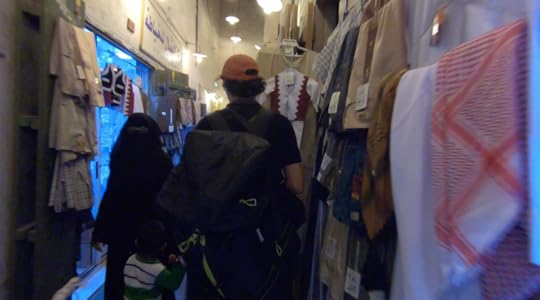 Inside the historic market of Souq Waqif. It was mysterious, enthralling, and enchanting, and we couldn't help but get lost in its web. In comparison to other Middle Eastern markets I've been to, this one was very clean, well-organized, and not quite so chaotic. It was just the perfect blend of historic authenticity with modern practicality.
Inside the historic market of Souq Waqif. It was mysterious, enthralling, and enchanting, and we couldn't help but get lost in its web. In comparison to other Middle Eastern markets I've been to, this one was very clean, well-organized, and not quite so chaotic. It was just the perfect blend of historic authenticity with modern practicality.
The entire market is pedestrian-only, except for horses. Gorgeous Arabian horses ridden by Qatari royal guards in their full regalia that looked like something out of Lawrence of Arabia. For me, since I'm a huge fan of horses, this was an absolute highlight. Every time they passed, I'd stop and stare, and then watch a guy who was following them scoop up any poop left behind with a shovel.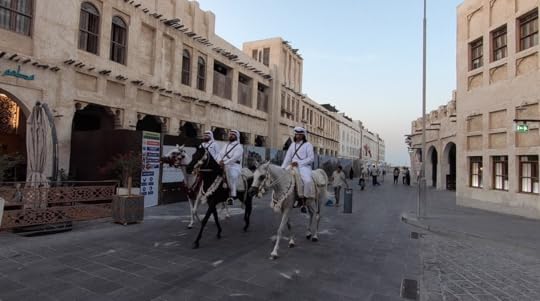 The armed horsemen who patrol Souq Waqif, Qatar.
The armed horsemen who patrol Souq Waqif, Qatar. 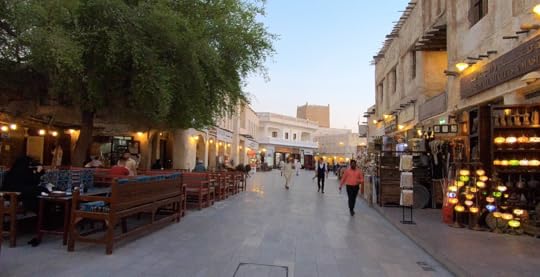 The open areas of the market in Souq Waqif, Qatar. Every once in a while, between the tight weave of alleyways we would find ourselves in a more open area lined in cafés and restaurants. At one of these, we stopped for some tea and coffee (and were fortunate enough to find a place with air-conditioning!).
The open areas of the market in Souq Waqif, Qatar. Every once in a while, between the tight weave of alleyways we would find ourselves in a more open area lined in cafés and restaurants. At one of these, we stopped for some tea and coffee (and were fortunate enough to find a place with air-conditioning!).
Once the sky had turned a vibrant shade of purple signaling the oncoming night, the call to prayer announced the setting sun, reverberating through the adobe and stone buildings. The street lamps were turned on, and I realized that it wasn't until night that this place really came alive. Qatari men in their white dishdashas would laugh with one another, sipping on their hookah pipes and blowing out puffs of sweet-smelling smoke. A group of three women in black robes and designer bags would haggle over prices, and there were also foreigner tourists in jean shorts and flowery dresses snapping pictures or eating ice cream. It was a perfect night out in Doha.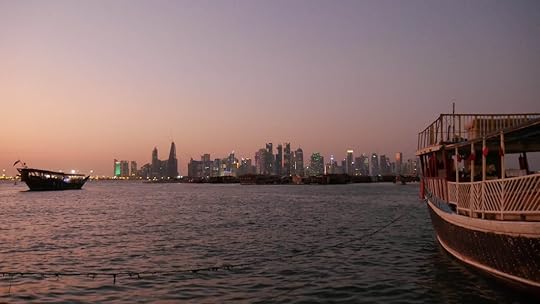 The skyline of Doha surrounded by dhows, traditional Qatari wooden boats. At last, we made our way out of the souq (market) and toward the oceanfront where traditional wooden boats called dhows were moored. Because Doha is situated on a small bay, we could actually see the skyline of the modern downtown area across the water of the bay, the lights of its skyscrapers glittering along its placid waves. Behind us, the golden-lit minaret of Fanar Mosque called out the last prayer, and the nearly-full moon rose up beside it. I felt like I was in one of the thousand-and-one Arabian nights.
The skyline of Doha surrounded by dhows, traditional Qatari wooden boats. At last, we made our way out of the souq (market) and toward the oceanfront where traditional wooden boats called dhows were moored. Because Doha is situated on a small bay, we could actually see the skyline of the modern downtown area across the water of the bay, the lights of its skyscrapers glittering along its placid waves. Behind us, the golden-lit minaret of Fanar Mosque called out the last prayer, and the nearly-full moon rose up beside it. I felt like I was in one of the thousand-and-one Arabian nights.
And so we left Qatar, thankful for our tiny but impactful experience there. And back at the airport we got ourselves ready for the last leg of the journey. Arriving in South Africa After our 9 hour layover in Qatar, we were looking forward to (not really) another 10.5 hour flight from there to Cape Town, South Africa. Since we can't sleep well on flights, we arrived so exhausted, I didn't feel human anymore, like I was just a ghost walking around.
A cab took us to our Airbnb, and we took a much-needed shower and nap. Actually it was a seventeen hour nap. Yes, that's right. 17.
Since our arrival, it's been a few days of resting and trying to get on the local schedule as we wait for our motorcycle to arrive. Maybe it's still in the cargo hold of London's Heathrow Airport, or maybe it's on a plane right now 36,000 feet in the air crossing the Sahara... but it will meet us here soon and we'll be reunited with our trusty steed that will take us across this great continent.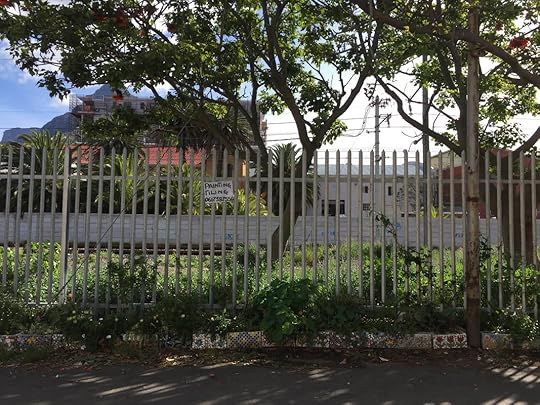 I'm already enjoying the colors and interesting plants of South Africa. Our next post will be about our first impressions of South Africa, from tasting the local food to taking in the views from Table Mountain, plus we've have our first encounter with African wildlife!
I'm already enjoying the colors and interesting plants of South Africa. Our next post will be about our first impressions of South Africa, from tasting the local food to taking in the views from Table Mountain, plus we've have our first encounter with African wildlife!
So stay tuned! Subscribe to our Blog I would like to thank all of our subscribers, readers, and followers for being a part of our journey and of our lives. Because just as we try to inspire others to live out their dreams, it is all of you out there who help us get through the tough times by your constant support.
A special thanks this week to Shaun Sartin and Brandon Lever. Your contributions to our journey will fill both gas tanks and bellies. We would love you to be a part of the journey and to help push us forward by checking out our Books and Photos for sale. BOOKS AND PHOTOS FOR SALE
 The Cape of Good Hope, South Africa I always say that the beginning of a journey is full of difficulties and obstacles, hurdles that you have to overcome before the real joy of the adventure can start. And the start to our African journey has been no different, though it's also been peppered with moments of joy and beauty. Leaving Home
The Cape of Good Hope, South Africa I always say that the beginning of a journey is full of difficulties and obstacles, hurdles that you have to overcome before the real joy of the adventure can start. And the start to our African journey has been no different, though it's also been peppered with moments of joy and beauty. Leaving Home  Our friend Justin and Tim soaking in our last day in Chicago. I find that traveling is full of meeting incredible people, but for every hello, there is always a goodbye. These meetings are usually brief, but meaningful, and farewells feel like little pinpricks stabbing at my chest. The smiles and generosity of these people from across the globe have left lasting touches on me, like fingerprints indented on my heart.
Our friend Justin and Tim soaking in our last day in Chicago. I find that traveling is full of meeting incredible people, but for every hello, there is always a goodbye. These meetings are usually brief, but meaningful, and farewells feel like little pinpricks stabbing at my chest. The smiles and generosity of these people from across the globe have left lasting touches on me, like fingerprints indented on my heart.But as a traveler, I've become aware of the cyclical pattern of constantly leaving, of constantly saying hello and goodbye. And a part of me prepares myself, fortifies myself whenever I meet someone, because I know that I will soon be leaving them, and perhaps it will be the last time we meet. It's like a little hardened barrier I build up inside myself, always reminding me that this is temporary, and that all great things will come to an end.
Yet there is no barrier that I could build up within myself that would prepare me for saying goodbye to those who have been in my life throughout all the hard times: my family and close friends from home.
 Tim and I with a few of the people we'll miss the most. This is of course the most difficult goodbye of them all. Though I know it's only temporary, the idea of being gone for an indefinite amount of time weighs heavily on me. Unlike last time, our trip to Africa has no end point, and I don't have a clear idea of when we'll be back since our plan sort of dead-ends when we get to Europe. By then, our savings will have run out and we'll be looking for work. What we find, where we'll end up, and when we'll get the funds to fly back are all unknowns.
Tim and I with a few of the people we'll miss the most. This is of course the most difficult goodbye of them all. Though I know it's only temporary, the idea of being gone for an indefinite amount of time weighs heavily on me. Unlike last time, our trip to Africa has no end point, and I don't have a clear idea of when we'll be back since our plan sort of dead-ends when we get to Europe. By then, our savings will have run out and we'll be looking for work. What we find, where we'll end up, and when we'll get the funds to fly back are all unknowns.All we know for sure is that we're leaving for the other side of the world, and it's going to be a while before we find ourselves at home again. A long while.
 Tim with two guys who are equally skilled with mechanics as they are awesome people: Aaron Preisel and Andy Janik. There are so many people from home that we are thankful for and indebted to: from friends who have helped Tim with preparing the bike, to family who have housed us, fed us, and brought us laughter, and even strangers who have contributed to our travels. I hope that even if I can't thank each and every one of you individually here, that you know how grateful we truly are.
Tim with two guys who are equally skilled with mechanics as they are awesome people: Aaron Preisel and Andy Janik. There are so many people from home that we are thankful for and indebted to: from friends who have helped Tim with preparing the bike, to family who have housed us, fed us, and brought us laughter, and even strangers who have contributed to our travels. I hope that even if I can't thank each and every one of you individually here, that you know how grateful we truly are.And so the day for us to leave came: September 4th, 2019. We packed up the bike, Tim petted his cat and hugged his dad with tears in their eyes, and we rode off with a wave and an unbearable heaviness in our chests. Riding to Montreal Our first step was to ride to Montréal, Canada where we would be flying ourselves and the bike out of. This is because flights for motorcycles are much cheaper from Canada than from the States, and Montréal offered the best deals for us.
It was only a few days' ride to Montréal from Chicago, and along the way we got to visit Tim's little sister in Michigan, as well as our motorcycle traveling friends Phil and Sapna near Toronto. We had first met them in Mexico and we crossed paths several times in Central and South America, so it was incredible to hang out with them in completely new surroundings, being able to once again share stories and reminisce.
 Sapna and Phil in their new home outside of Toronto. From Toronto, we headed to Montréal, which is Canada's second largest city and the largest city in its French-speaking quarter of Quebec. But being in Montréal meant business for us more than sight-seeing, since there were a lot of logistics, paperwork, and payments involved in getting the bike on a plane and then ourselves on another one.
Sapna and Phil in their new home outside of Toronto. From Toronto, we headed to Montréal, which is Canada's second largest city and the largest city in its French-speaking quarter of Quebec. But being in Montréal meant business for us more than sight-seeing, since there were a lot of logistics, paperwork, and payments involved in getting the bike on a plane and then ourselves on another one. But North America wasn't going to let us leave without one last surprise.
 During our ride to Montreal, it's a shame we didn't have time to leave the highway more and see the sights. As we pulled up to our Airbnb near the Montréal airport, we saw a Triumph Tiger covered in stickers with UK plates: a fellow round-the-world motorcycle traveler! We immediately pulled up to inspect the bike and I noticed a world map sticker with the rider's route drawn onto it: from England through Europe, across the “Stans" in Central Asia, through China, Malaysia, around Australia, and then finally Alaska, Canada, the US.... wow! My mouth hung open at this guy's incredible journey, but then as the owner of the bike walked up to us, my mouth dropped even further when I realized the greatest shock of all.
During our ride to Montreal, it's a shame we didn't have time to leave the highway more and see the sights. As we pulled up to our Airbnb near the Montréal airport, we saw a Triumph Tiger covered in stickers with UK plates: a fellow round-the-world motorcycle traveler! We immediately pulled up to inspect the bike and I noticed a world map sticker with the rider's route drawn onto it: from England through Europe, across the “Stans" in Central Asia, through China, Malaysia, around Australia, and then finally Alaska, Canada, the US.... wow! My mouth hung open at this guy's incredible journey, but then as the owner of the bike walked up to us, my mouth dropped even further when I realized the greatest shock of all.This world motorcycle traveler wasn't a guy at all, but a woman who had ridden it all alone!
 Tim, Caroline, and me with her Tiger in the background. Caroline Lunnen is her name (handle: funsmazwas), and she'd just spent 14 months riding around the world and this was to be her last day before flying back home! I couldn't believe our fortune, and we spent hours at dinner sharing stories, travel insights, and basically just bathing in the bliss of knowing that we were all the same type of crazy.
Tim, Caroline, and me with her Tiger in the background. Caroline Lunnen is her name (handle: funsmazwas), and she'd just spent 14 months riding around the world and this was to be her last day before flying back home! I couldn't believe our fortune, and we spent hours at dinner sharing stories, travel insights, and basically just bathing in the bliss of knowing that we were all the same type of crazy.  Tim preparing our KTM 1190 for its flight to South Africa. The next day, we brought our bike into the cargo area of the Montréal airport, weighed it with all its stuff on (we now know it's 323 kg), got our gear scanned, and said our goodbyes to the bike and almost everything we owned as the cargo crew got ready to fly it out to Heathrow. We took one last look at the bike, then hitched a cab to the departures terminal of the airport, and waited for our flight to Qatar.
Tim preparing our KTM 1190 for its flight to South Africa. The next day, we brought our bike into the cargo area of the Montréal airport, weighed it with all its stuff on (we now know it's 323 kg), got our gear scanned, and said our goodbyes to the bike and almost everything we owned as the cargo crew got ready to fly it out to Heathrow. We took one last look at the bike, then hitched a cab to the departures terminal of the airport, and waited for our flight to Qatar.Since there are no direct flights from Canada to South Africa, we had to have a layover somewhere. The bike was taking a different path from us and would be transferring in London. But Tim and I were going to have a long layover in Qatar, and I was excited because my plan was to actually leave the airport and see something of the country. Qatar
 This was our first magical glimpse into this small, Arab country. After 12.5 hours of being cramped in a plane, we were not feeling our freshest when we arrived in the Persian Gulf country of Qatar (said like “cutter", but “kataar" is also accepted). And actually, the Doha airport turned out to be so nice, there was almost no reason to leave it (the best airport I've ever been to), but I'm so glad we did. Because our few hours in Qatar equated to a real feast for the senses.
This was our first magical glimpse into this small, Arab country. After 12.5 hours of being cramped in a plane, we were not feeling our freshest when we arrived in the Persian Gulf country of Qatar (said like “cutter", but “kataar" is also accepted). And actually, the Doha airport turned out to be so nice, there was almost no reason to leave it (the best airport I've ever been to), but I'm so glad we did. Because our few hours in Qatar equated to a real feast for the senses.  Qatar is a tiny oil-rich country sticking out like a thumb between Saudi Arabia and the Persian Gulf. Best known for its state-funded news network Al-Jazeera, and its award-winning airlines Qatar Airways, the country is ruled by a young king called Emir Tamim Al-Thani in an absolute monarchy.
Qatar is a tiny oil-rich country sticking out like a thumb between Saudi Arabia and the Persian Gulf. Best known for its state-funded news network Al-Jazeera, and its award-winning airlines Qatar Airways, the country is ruled by a young king called Emir Tamim Al-Thani in an absolute monarchy.And although the majority of the people living there are not Qatari (88% are foreign workers coming mostly from India and Pakistan), Qataris are classified as the richest people on earth. Qatar will also be the host of the 2022 FIFA World Cup, which will mean it's the first Arab country to do so, but that honor has been tainted by allegations of bribery.
Soccer aside, because Doha is clean, safe, and was a historic port known for trading incense, silks, and Persian rugs, I had the feeling that I was going to enjoy visiting it.
 The beautiful buildings of Doha's old district. When we arrived in Qatar, it was nearly sunset and 95˚F outside (35˚C). But the heat didn't deter us as we got into a cab and headed toward the desert sunset. Rows of date trees lined the streets, silhouetted by the reddening sky behind them, and we passed one architecturally-unique building after the next: the National Museum of Qatar which looked like something found on a Star Wars set, and the Fanar Mosque, which resembled a spiral version of a tiered wedding cake.
The beautiful buildings of Doha's old district. When we arrived in Qatar, it was nearly sunset and 95˚F outside (35˚C). But the heat didn't deter us as we got into a cab and headed toward the desert sunset. Rows of date trees lined the streets, silhouetted by the reddening sky behind them, and we passed one architecturally-unique building after the next: the National Museum of Qatar which looked like something found on a Star Wars set, and the Fanar Mosque, which resembled a spiral version of a tiered wedding cake.  The National Museum of Qatar
The National Museum of Qatar  Fanar Mosque Finally we came to the oldest area of Doha, a market called Souq Waqif (locals pronounce it “soog WAAgif"), and it was an alluring tangle of covered walkways between stalls selling pyramidal stacks of colorful spices, exotic sweets dripping in glaze, and shimmering silk shawls. The pungent perfume of frankincense smoke wafted through the air, vendors would call out their wares and prices, and women in full abayas of black with nothing but their eyes showing would peruse through the winding alleys.
Fanar Mosque Finally we came to the oldest area of Doha, a market called Souq Waqif (locals pronounce it “soog WAAgif"), and it was an alluring tangle of covered walkways between stalls selling pyramidal stacks of colorful spices, exotic sweets dripping in glaze, and shimmering silk shawls. The pungent perfume of frankincense smoke wafted through the air, vendors would call out their wares and prices, and women in full abayas of black with nothing but their eyes showing would peruse through the winding alleys.  Inside the historic market of Souq Waqif. It was mysterious, enthralling, and enchanting, and we couldn't help but get lost in its web. In comparison to other Middle Eastern markets I've been to, this one was very clean, well-organized, and not quite so chaotic. It was just the perfect blend of historic authenticity with modern practicality.
Inside the historic market of Souq Waqif. It was mysterious, enthralling, and enchanting, and we couldn't help but get lost in its web. In comparison to other Middle Eastern markets I've been to, this one was very clean, well-organized, and not quite so chaotic. It was just the perfect blend of historic authenticity with modern practicality.The entire market is pedestrian-only, except for horses. Gorgeous Arabian horses ridden by Qatari royal guards in their full regalia that looked like something out of Lawrence of Arabia. For me, since I'm a huge fan of horses, this was an absolute highlight. Every time they passed, I'd stop and stare, and then watch a guy who was following them scoop up any poop left behind with a shovel.
 The armed horsemen who patrol Souq Waqif, Qatar.
The armed horsemen who patrol Souq Waqif, Qatar.  The open areas of the market in Souq Waqif, Qatar. Every once in a while, between the tight weave of alleyways we would find ourselves in a more open area lined in cafés and restaurants. At one of these, we stopped for some tea and coffee (and were fortunate enough to find a place with air-conditioning!).
The open areas of the market in Souq Waqif, Qatar. Every once in a while, between the tight weave of alleyways we would find ourselves in a more open area lined in cafés and restaurants. At one of these, we stopped for some tea and coffee (and were fortunate enough to find a place with air-conditioning!).Once the sky had turned a vibrant shade of purple signaling the oncoming night, the call to prayer announced the setting sun, reverberating through the adobe and stone buildings. The street lamps were turned on, and I realized that it wasn't until night that this place really came alive. Qatari men in their white dishdashas would laugh with one another, sipping on their hookah pipes and blowing out puffs of sweet-smelling smoke. A group of three women in black robes and designer bags would haggle over prices, and there were also foreigner tourists in jean shorts and flowery dresses snapping pictures or eating ice cream. It was a perfect night out in Doha.
 The skyline of Doha surrounded by dhows, traditional Qatari wooden boats. At last, we made our way out of the souq (market) and toward the oceanfront where traditional wooden boats called dhows were moored. Because Doha is situated on a small bay, we could actually see the skyline of the modern downtown area across the water of the bay, the lights of its skyscrapers glittering along its placid waves. Behind us, the golden-lit minaret of Fanar Mosque called out the last prayer, and the nearly-full moon rose up beside it. I felt like I was in one of the thousand-and-one Arabian nights.
The skyline of Doha surrounded by dhows, traditional Qatari wooden boats. At last, we made our way out of the souq (market) and toward the oceanfront where traditional wooden boats called dhows were moored. Because Doha is situated on a small bay, we could actually see the skyline of the modern downtown area across the water of the bay, the lights of its skyscrapers glittering along its placid waves. Behind us, the golden-lit minaret of Fanar Mosque called out the last prayer, and the nearly-full moon rose up beside it. I felt like I was in one of the thousand-and-one Arabian nights.And so we left Qatar, thankful for our tiny but impactful experience there. And back at the airport we got ourselves ready for the last leg of the journey. Arriving in South Africa After our 9 hour layover in Qatar, we were looking forward to (not really) another 10.5 hour flight from there to Cape Town, South Africa. Since we can't sleep well on flights, we arrived so exhausted, I didn't feel human anymore, like I was just a ghost walking around.
A cab took us to our Airbnb, and we took a much-needed shower and nap. Actually it was a seventeen hour nap. Yes, that's right. 17.
Since our arrival, it's been a few days of resting and trying to get on the local schedule as we wait for our motorcycle to arrive. Maybe it's still in the cargo hold of London's Heathrow Airport, or maybe it's on a plane right now 36,000 feet in the air crossing the Sahara... but it will meet us here soon and we'll be reunited with our trusty steed that will take us across this great continent.
 I'm already enjoying the colors and interesting plants of South Africa. Our next post will be about our first impressions of South Africa, from tasting the local food to taking in the views from Table Mountain, plus we've have our first encounter with African wildlife!
I'm already enjoying the colors and interesting plants of South Africa. Our next post will be about our first impressions of South Africa, from tasting the local food to taking in the views from Table Mountain, plus we've have our first encounter with African wildlife!So stay tuned! Subscribe to our Blog I would like to thank all of our subscribers, readers, and followers for being a part of our journey and of our lives. Because just as we try to inspire others to live out their dreams, it is all of you out there who help us get through the tough times by your constant support.
A special thanks this week to Shaun Sartin and Brandon Lever. Your contributions to our journey will fill both gas tanks and bellies. We would love you to be a part of the journey and to help push us forward by checking out our Books and Photos for sale. BOOKS AND PHOTOS FOR SALE
Published on September 15, 2019 05:05
August 26, 2019
Preparing to Overland in Africa (and what is a CARNET?)
By Marisa For the past few weeks, Tim and I have been making preparations to ship our motorcycle and ourselves to South Africa from the US. The plan is to then ride up the eastern side of Africa up to Egypt, and from there, ferry over to Europe.
We recently shipped our bike from Argentina to the States, and that process was fairly painless, but shipping to Africa has turned out to be a completely other beast. That is not to say that Africa won't be worth all the trouble. I think the moment we take our first picture with our bike and a giraffe standing behind it, all these difficulties will feel a million miles behind us.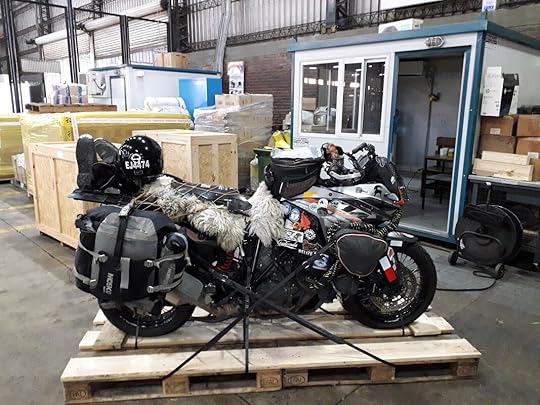 Our home and most prized possession: our KTM 1190. For various reasons, we've decided to ship our own bike to Africa as opposed to buying one there. Both methods require Carnets (depending on which countries you go to), and are complicated in their own way, but buying a bike there would certainly avoid the whole “shipping over" part. Yet we felt it was important for us to ride on our own trusty steed that we have put so much love and work into, and I think in the end this was the right decision for us.
Our home and most prized possession: our KTM 1190. For various reasons, we've decided to ship our own bike to Africa as opposed to buying one there. Both methods require Carnets (depending on which countries you go to), and are complicated in their own way, but buying a bike there would certainly avoid the whole “shipping over" part. Yet we felt it was important for us to ride on our own trusty steed that we have put so much love and work into, and I think in the end this was the right decision for us.
But the process has not been easy.
So to help anyone out there who wants to one day overland in Africa with a vehicle brought from home, I'm going to lay out everything I've learned about doing so. If that's not you, the following information may not be of interest, but stay tuned for our next blog post because it will be from South Africa, hopefully with a motorcycle all in one piece!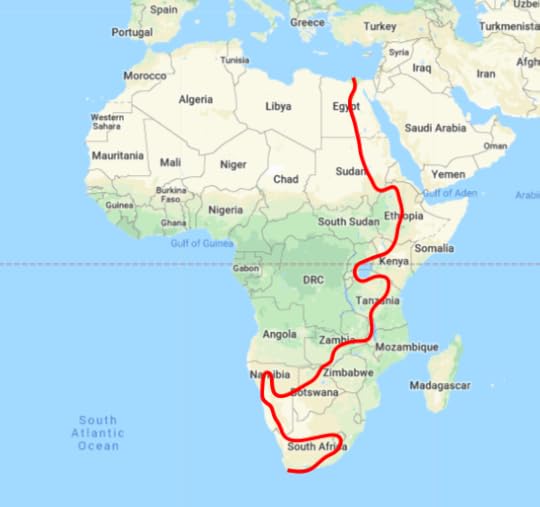 This is a rough estimate of our planned route through Africa starting in Cape Town and going north to Egypt. What is a Carnet de Passage? Unlike riding through the Americas or Europe, there are many countries in Africa that will not allow you to enter with your vehicle if you don't have a special and
expensive
piece of paperwork called a Carnet de Passage en Douane (yes, it's French). It's known as simply a Carnet (kar-NAY) or CPD for short.
This is a rough estimate of our planned route through Africa starting in Cape Town and going north to Egypt. What is a Carnet de Passage? Unlike riding through the Americas or Europe, there are many countries in Africa that will not allow you to enter with your vehicle if you don't have a special and
expensive
piece of paperwork called a Carnet de Passage en Douane (yes, it's French). It's known as simply a Carnet (kar-NAY) or CPD for short.
Think of it like a passport for your vehicle, and you have to get it from your country of residence's automotive association before you hit the road. And the kicker: you'll have to pay them a several thousand dollar deposit that equals the worth of your vehicle (plus a $980 fee for processing the paperwork). Once you're all done with your Carnet with every border stamp in its proper place, you'll get your deposit back. Fingers crossed. The way I look at it is the Carnet is an antiquated assurance that you won't sell your vehicle while abroad. Nowadays, most countries simply register your vehicle's VIN number upon entry and exit, and they give you a paper called a Temporary Import Permit. But before computerized systems, borders couldn't easily keep track of everyone coming and going, and so they relied on Carnets which proved to them that you wouldn't sell your vehicle or else you'd lose your deposit on it.
Though many countries will accept a Carnet, most don't require it anymore. Currently, only some countries in Africa and Asia require a Carnet for vehicle entry, including Egypt, Libya, Iran, India, and Pakistan, though the rules are always changing and becoming more and more lax.
Check out this great website (overlandingassociation.org) for the latest information.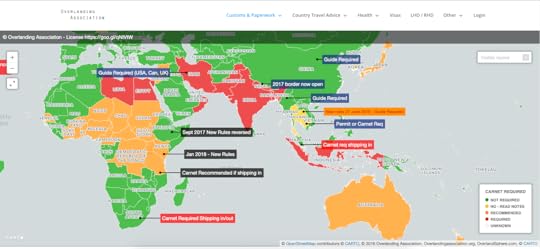 So how do you get a Carnet? The following is the complete step-by-step process of how we prepared ourselves and our motorcycle to arrive in the continent of Africa, Carnet, plane tickets, and all. Step 1 - Apply for your Carnet As of 2019, the only organization giving out Carnets in the States and Canada is called Boomerang, and it's located in Illinois (it used to be in Canada under a different name and changed to Boomerang just this year).
So how do you get a Carnet? The following is the complete step-by-step process of how we prepared ourselves and our motorcycle to arrive in the continent of Africa, Carnet, plane tickets, and all. Step 1 - Apply for your Carnet As of 2019, the only organization giving out Carnets in the States and Canada is called Boomerang, and it's located in Illinois (it used to be in Canada under a different name and changed to Boomerang just this year).
To get the Carnet, first go to their website and fill out their inquiry form, and they'll guide you through the process from there. Make sure you're on their vehicle passport page, not their freight and goods site which looks similar. If you're from the US and Canada, use this link. Afterwards, you'll have to send them scanned copies of your vehicle registration, your passport, two passport-sized photos of you, two pictures of your vehicle from the front right and rear left, and a signed and completed application form. You'll have to know mileage, weight, dimensions, and all the countries you plan on going to. This is very important: your Carnet is only valid for ONE YEAR from the date of printing, which means you must be through all the countries that require it within that year. There are ways to extend it, but it will cost you $400 and you have to start the extension process months in advance. So I suggest that after you do all the paperwork and payments, tell your Carnet company NOT to print your Carnet until you're ready to leave. Step 2 - Research How You'll Ship Your Vehicle If you have a car, RV, or anything bigger than a motorcycle, you will have to use ground or sea shipping to get it to Africa. But one of the great things about traveling by motorcycle is that you can fly your bike pretty much anywhere in the world these days. And because we've heard horror stories of people waiting for months and paying exorbitant fees when shipping their bikes by sea, we decided to fly.
This is very important: your Carnet is only valid for ONE YEAR from the date of printing, which means you must be through all the countries that require it within that year. There are ways to extend it, but it will cost you $400 and you have to start the extension process months in advance. So I suggest that after you do all the paperwork and payments, tell your Carnet company NOT to print your Carnet until you're ready to leave. Step 2 - Research How You'll Ship Your Vehicle If you have a car, RV, or anything bigger than a motorcycle, you will have to use ground or sea shipping to get it to Africa. But one of the great things about traveling by motorcycle is that you can fly your bike pretty much anywhere in the world these days. And because we've heard horror stories of people waiting for months and paying exorbitant fees when shipping their bikes by sea, we decided to fly.
We had just flown our bike from Argentina to Chicago with relative ease, so we figured that the process would be similar for Africa.
Ha! Not exactly.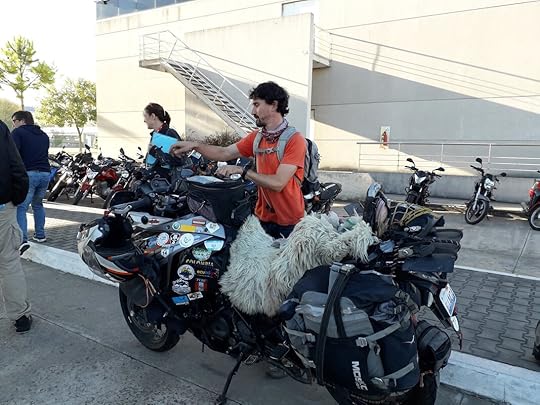 This was Tim getting the bike ready for flying at the Buenos Aires cargo hangar, Argentina. Most cargo companies will only deal with freight forwarders, not ordinary people, so choose one to go with. We went through MotoFrieght.
This was Tim getting the bike ready for flying at the Buenos Aires cargo hangar, Argentina. Most cargo companies will only deal with freight forwarders, not ordinary people, so choose one to go with. We went through MotoFrieght.
If you have a motorcycle, I would still recommend flying instead of shipping to Africa, but the price was way higher to get our bike to South Africa than from South America, about 3 times as much! AirCanada has the best deals for motorcycles flying out of North America, but they don't fly to Sub-Saharan Africa (and be aware that they only fly motorcycles from May 1st to September 30th), and so paying a customs official to transfer the bike in Europe to get it to Cape Town was an extra expense. Step 3 - Research Cheap Flights for You You must book your bike's flight no less than two weeks prior to departure, so plan ahead. And before booking anything, we researched the cheapest days to fly ourselves to South Africa because passenger fares differ day by day, but your motorcycle will cost the same ridiculous price regardless of the day.
Once you have a few good dates in mind for yourself to fly, then you can confirm with your freight forwarder to ship your bike on the same day. Don't book your personal flight before talking with them first because they will tell you which dates work for them and which days have no availability. Step 4 - Finalize Your Carnet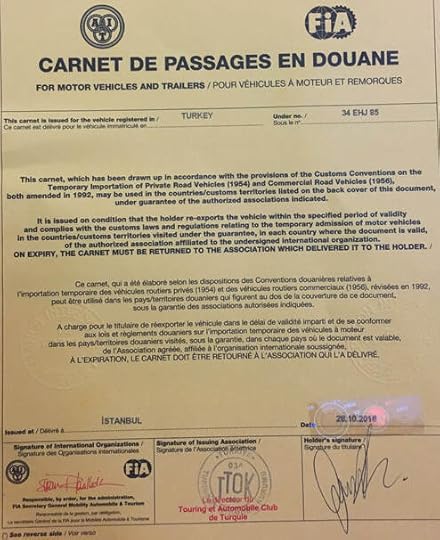 Now that you have a good idea of when exactly you want to leave, you can tell your Carnet company to print and finalize it. Since the Carnet is only good for one year from the date of printing, you want that date to be as close to your departure as possible, but you'll also need your Carnet printed before booking any shipment of your vehicle. So once you're ready, have them print your Carnet and you will receive it in the mail next day air.
Now that you have a good idea of when exactly you want to leave, you can tell your Carnet company to print and finalize it. Since the Carnet is only good for one year from the date of printing, you want that date to be as close to your departure as possible, but you'll also need your Carnet printed before booking any shipment of your vehicle. So once you're ready, have them print your Carnet and you will receive it in the mail next day air.
The actual Carnet is a big yellow form with a packet inside, and every Carnet country you go to must fill out one of these sheets (it's very important you make sure it's exact). They will stamp in your vehicle upon entry and exit, and you must have all your stamps and signatures in order or else there is a chance you will not get your deposit back at the end.
You will also receive two more important documents, the Certificate of Disposition (COD) and the Certificate of Location (COL), and at the end you'll use one of these along with your Carnet to get your deposit back. If you'll be returning to your home country with your vehicle, have the customs officer fill out the COD for you (this is for the US only, I know it's different for other countries). If you won't be coming back home with your vehicle, you'll simply have an official in whichever country you're at fill out the COL instead of the COD, which basically just proves you are no longer in a Carnet country.
Whew, that's complicated! It took us a long time and several phone calls to figure this all out.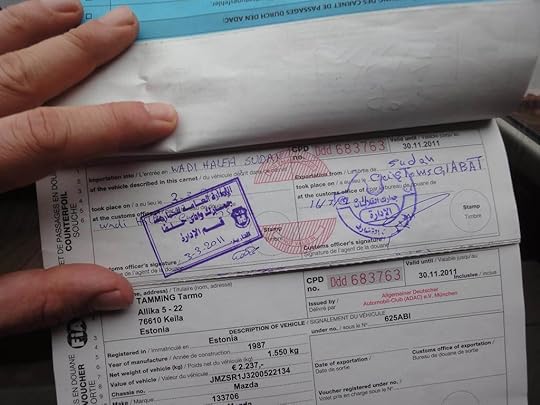 This is an example of what the country's customs officials will be filling out on your Carnet. When you've gotten through your last Carnet country (for us it will be Egypt), or you've come home, then you will mail a copy of the Carnet and either your completed COD or COL (depending on whether you're in your home country or not) and await instructions on receiving your deposit. They will most likely make a money transfer into your bank account, or by whichever means you want.
This is an example of what the country's customs officials will be filling out on your Carnet. When you've gotten through your last Carnet country (for us it will be Egypt), or you've come home, then you will mail a copy of the Carnet and either your completed COD or COL (depending on whether you're in your home country or not) and await instructions on receiving your deposit. They will most likely make a money transfer into your bank account, or by whichever means you want.
Obviously, Carnets are no fun and require a lot of stress and money. But for us and many others out there, the elephants and lions of the serengeti are worth it. Step 5 - Book your Vehicle Shipment, then your own Flight Everything should be done in this specific order: finalize your Carnet first, book your vehicle shipment second, and last of all, book your own flight. This is because your freight company will need your Carnet number before booking, and they may not be able to ship on certain days. You can't leave until your vehicle does, so you must book your personal flight after you are 100% sure about the date and time that your vehicle will leave.
Though motorcycles do fly in the cargo area of regular airlines, you don't need to fly on the same plane as your bike, and you don't even need to use the same airlines (AirCanada will give you a discount if you do though). That being said, you need to align your flight to take place just after dropping off your bike and hopefully you'll be at your destination before it arrives, otherwise you will be charged daily storage fees. Step 6 - Crate it up! Prior to your motorcycle's flight, you will need to set up a DG Declaration (Dangerous Goods Declaration) to certify that the motorcycle is in safe condition for air transport. We arranged for this to be done the morning of the motorcycle's flight because it does not ship out until 9pm, but just be sure the inspection has been completed in time for customs to do their job, between 24 and 6 hours prior to takeoff. After you have obtained your DG Declaration, you can show up at the cargo place for customs.
Here were the rules for flying our motorcycle:Have no more than a 1/4 tank of gas in it (less is better)No tire repair kits of glue or CO2Any GPS radio or laptops must be removed from the bike and from helmetsNo aerosol allowedNo spare gas tank on the bikeAlarm systems must be turned off and disconnected
To get the bike ready to ship, you will most likely have to take off your windshield, bend in or remove your side mirrors, and disconnect your battery. You can usually leave your helmet and boots in a pannier. Everything will be shrink-wrapped, and only the owner of the motorcycle is allowed into the customs area of the airport (last time, I was forced to wait outside for hours as Tim did everything).
You will pay at the time of shipment, probably via credit card, and then that's it. Cross your fingers and toes and get ready to fly out and meet your bike at its destination!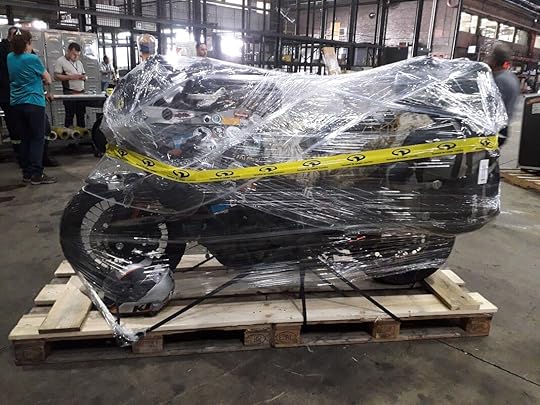 So that's the process, nothing complicated at all, right?
So that's the process, nothing complicated at all, right?
My next blog post will be from South Africa, and hopefully I'll have some good news about arriving safely and retrieving our motorcycle with no problems. So wish us luck (we're leaving September 9th), and stay tuned for the first part of our adventure in Africa! Subscribe to our Blog
We recently shipped our bike from Argentina to the States, and that process was fairly painless, but shipping to Africa has turned out to be a completely other beast. That is not to say that Africa won't be worth all the trouble. I think the moment we take our first picture with our bike and a giraffe standing behind it, all these difficulties will feel a million miles behind us.
 Our home and most prized possession: our KTM 1190. For various reasons, we've decided to ship our own bike to Africa as opposed to buying one there. Both methods require Carnets (depending on which countries you go to), and are complicated in their own way, but buying a bike there would certainly avoid the whole “shipping over" part. Yet we felt it was important for us to ride on our own trusty steed that we have put so much love and work into, and I think in the end this was the right decision for us.
Our home and most prized possession: our KTM 1190. For various reasons, we've decided to ship our own bike to Africa as opposed to buying one there. Both methods require Carnets (depending on which countries you go to), and are complicated in their own way, but buying a bike there would certainly avoid the whole “shipping over" part. Yet we felt it was important for us to ride on our own trusty steed that we have put so much love and work into, and I think in the end this was the right decision for us. But the process has not been easy.
So to help anyone out there who wants to one day overland in Africa with a vehicle brought from home, I'm going to lay out everything I've learned about doing so. If that's not you, the following information may not be of interest, but stay tuned for our next blog post because it will be from South Africa, hopefully with a motorcycle all in one piece!
 This is a rough estimate of our planned route through Africa starting in Cape Town and going north to Egypt. What is a Carnet de Passage? Unlike riding through the Americas or Europe, there are many countries in Africa that will not allow you to enter with your vehicle if you don't have a special and
expensive
piece of paperwork called a Carnet de Passage en Douane (yes, it's French). It's known as simply a Carnet (kar-NAY) or CPD for short.
This is a rough estimate of our planned route through Africa starting in Cape Town and going north to Egypt. What is a Carnet de Passage? Unlike riding through the Americas or Europe, there are many countries in Africa that will not allow you to enter with your vehicle if you don't have a special and
expensive
piece of paperwork called a Carnet de Passage en Douane (yes, it's French). It's known as simply a Carnet (kar-NAY) or CPD for short.Think of it like a passport for your vehicle, and you have to get it from your country of residence's automotive association before you hit the road. And the kicker: you'll have to pay them a several thousand dollar deposit that equals the worth of your vehicle (plus a $980 fee for processing the paperwork). Once you're all done with your Carnet with every border stamp in its proper place, you'll get your deposit back. Fingers crossed. The way I look at it is the Carnet is an antiquated assurance that you won't sell your vehicle while abroad. Nowadays, most countries simply register your vehicle's VIN number upon entry and exit, and they give you a paper called a Temporary Import Permit. But before computerized systems, borders couldn't easily keep track of everyone coming and going, and so they relied on Carnets which proved to them that you wouldn't sell your vehicle or else you'd lose your deposit on it.
Though many countries will accept a Carnet, most don't require it anymore. Currently, only some countries in Africa and Asia require a Carnet for vehicle entry, including Egypt, Libya, Iran, India, and Pakistan, though the rules are always changing and becoming more and more lax.
Check out this great website (overlandingassociation.org) for the latest information.
 So how do you get a Carnet? The following is the complete step-by-step process of how we prepared ourselves and our motorcycle to arrive in the continent of Africa, Carnet, plane tickets, and all. Step 1 - Apply for your Carnet As of 2019, the only organization giving out Carnets in the States and Canada is called Boomerang, and it's located in Illinois (it used to be in Canada under a different name and changed to Boomerang just this year).
So how do you get a Carnet? The following is the complete step-by-step process of how we prepared ourselves and our motorcycle to arrive in the continent of Africa, Carnet, plane tickets, and all. Step 1 - Apply for your Carnet As of 2019, the only organization giving out Carnets in the States and Canada is called Boomerang, and it's located in Illinois (it used to be in Canada under a different name and changed to Boomerang just this year). To get the Carnet, first go to their website and fill out their inquiry form, and they'll guide you through the process from there. Make sure you're on their vehicle passport page, not their freight and goods site which looks similar. If you're from the US and Canada, use this link. Afterwards, you'll have to send them scanned copies of your vehicle registration, your passport, two passport-sized photos of you, two pictures of your vehicle from the front right and rear left, and a signed and completed application form. You'll have to know mileage, weight, dimensions, and all the countries you plan on going to.
 This is very important: your Carnet is only valid for ONE YEAR from the date of printing, which means you must be through all the countries that require it within that year. There are ways to extend it, but it will cost you $400 and you have to start the extension process months in advance. So I suggest that after you do all the paperwork and payments, tell your Carnet company NOT to print your Carnet until you're ready to leave. Step 2 - Research How You'll Ship Your Vehicle If you have a car, RV, or anything bigger than a motorcycle, you will have to use ground or sea shipping to get it to Africa. But one of the great things about traveling by motorcycle is that you can fly your bike pretty much anywhere in the world these days. And because we've heard horror stories of people waiting for months and paying exorbitant fees when shipping their bikes by sea, we decided to fly.
This is very important: your Carnet is only valid for ONE YEAR from the date of printing, which means you must be through all the countries that require it within that year. There are ways to extend it, but it will cost you $400 and you have to start the extension process months in advance. So I suggest that after you do all the paperwork and payments, tell your Carnet company NOT to print your Carnet until you're ready to leave. Step 2 - Research How You'll Ship Your Vehicle If you have a car, RV, or anything bigger than a motorcycle, you will have to use ground or sea shipping to get it to Africa. But one of the great things about traveling by motorcycle is that you can fly your bike pretty much anywhere in the world these days. And because we've heard horror stories of people waiting for months and paying exorbitant fees when shipping their bikes by sea, we decided to fly. We had just flown our bike from Argentina to Chicago with relative ease, so we figured that the process would be similar for Africa.
Ha! Not exactly.
 This was Tim getting the bike ready for flying at the Buenos Aires cargo hangar, Argentina. Most cargo companies will only deal with freight forwarders, not ordinary people, so choose one to go with. We went through MotoFrieght.
This was Tim getting the bike ready for flying at the Buenos Aires cargo hangar, Argentina. Most cargo companies will only deal with freight forwarders, not ordinary people, so choose one to go with. We went through MotoFrieght.If you have a motorcycle, I would still recommend flying instead of shipping to Africa, but the price was way higher to get our bike to South Africa than from South America, about 3 times as much! AirCanada has the best deals for motorcycles flying out of North America, but they don't fly to Sub-Saharan Africa (and be aware that they only fly motorcycles from May 1st to September 30th), and so paying a customs official to transfer the bike in Europe to get it to Cape Town was an extra expense. Step 3 - Research Cheap Flights for You You must book your bike's flight no less than two weeks prior to departure, so plan ahead. And before booking anything, we researched the cheapest days to fly ourselves to South Africa because passenger fares differ day by day, but your motorcycle will cost the same ridiculous price regardless of the day.
Once you have a few good dates in mind for yourself to fly, then you can confirm with your freight forwarder to ship your bike on the same day. Don't book your personal flight before talking with them first because they will tell you which dates work for them and which days have no availability. Step 4 - Finalize Your Carnet
 Now that you have a good idea of when exactly you want to leave, you can tell your Carnet company to print and finalize it. Since the Carnet is only good for one year from the date of printing, you want that date to be as close to your departure as possible, but you'll also need your Carnet printed before booking any shipment of your vehicle. So once you're ready, have them print your Carnet and you will receive it in the mail next day air.
Now that you have a good idea of when exactly you want to leave, you can tell your Carnet company to print and finalize it. Since the Carnet is only good for one year from the date of printing, you want that date to be as close to your departure as possible, but you'll also need your Carnet printed before booking any shipment of your vehicle. So once you're ready, have them print your Carnet and you will receive it in the mail next day air.The actual Carnet is a big yellow form with a packet inside, and every Carnet country you go to must fill out one of these sheets (it's very important you make sure it's exact). They will stamp in your vehicle upon entry and exit, and you must have all your stamps and signatures in order or else there is a chance you will not get your deposit back at the end.
You will also receive two more important documents, the Certificate of Disposition (COD) and the Certificate of Location (COL), and at the end you'll use one of these along with your Carnet to get your deposit back. If you'll be returning to your home country with your vehicle, have the customs officer fill out the COD for you (this is for the US only, I know it's different for other countries). If you won't be coming back home with your vehicle, you'll simply have an official in whichever country you're at fill out the COL instead of the COD, which basically just proves you are no longer in a Carnet country.
Whew, that's complicated! It took us a long time and several phone calls to figure this all out.
 This is an example of what the country's customs officials will be filling out on your Carnet. When you've gotten through your last Carnet country (for us it will be Egypt), or you've come home, then you will mail a copy of the Carnet and either your completed COD or COL (depending on whether you're in your home country or not) and await instructions on receiving your deposit. They will most likely make a money transfer into your bank account, or by whichever means you want.
This is an example of what the country's customs officials will be filling out on your Carnet. When you've gotten through your last Carnet country (for us it will be Egypt), or you've come home, then you will mail a copy of the Carnet and either your completed COD or COL (depending on whether you're in your home country or not) and await instructions on receiving your deposit. They will most likely make a money transfer into your bank account, or by whichever means you want.Obviously, Carnets are no fun and require a lot of stress and money. But for us and many others out there, the elephants and lions of the serengeti are worth it. Step 5 - Book your Vehicle Shipment, then your own Flight Everything should be done in this specific order: finalize your Carnet first, book your vehicle shipment second, and last of all, book your own flight. This is because your freight company will need your Carnet number before booking, and they may not be able to ship on certain days. You can't leave until your vehicle does, so you must book your personal flight after you are 100% sure about the date and time that your vehicle will leave.
Though motorcycles do fly in the cargo area of regular airlines, you don't need to fly on the same plane as your bike, and you don't even need to use the same airlines (AirCanada will give you a discount if you do though). That being said, you need to align your flight to take place just after dropping off your bike and hopefully you'll be at your destination before it arrives, otherwise you will be charged daily storage fees. Step 6 - Crate it up! Prior to your motorcycle's flight, you will need to set up a DG Declaration (Dangerous Goods Declaration) to certify that the motorcycle is in safe condition for air transport. We arranged for this to be done the morning of the motorcycle's flight because it does not ship out until 9pm, but just be sure the inspection has been completed in time for customs to do their job, between 24 and 6 hours prior to takeoff. After you have obtained your DG Declaration, you can show up at the cargo place for customs.
Here were the rules for flying our motorcycle:Have no more than a 1/4 tank of gas in it (less is better)No tire repair kits of glue or CO2Any GPS radio or laptops must be removed from the bike and from helmetsNo aerosol allowedNo spare gas tank on the bikeAlarm systems must be turned off and disconnected
To get the bike ready to ship, you will most likely have to take off your windshield, bend in or remove your side mirrors, and disconnect your battery. You can usually leave your helmet and boots in a pannier. Everything will be shrink-wrapped, and only the owner of the motorcycle is allowed into the customs area of the airport (last time, I was forced to wait outside for hours as Tim did everything).
You will pay at the time of shipment, probably via credit card, and then that's it. Cross your fingers and toes and get ready to fly out and meet your bike at its destination!
 So that's the process, nothing complicated at all, right?
So that's the process, nothing complicated at all, right? My next blog post will be from South Africa, and hopefully I'll have some good news about arriving safely and retrieving our motorcycle with no problems. So wish us luck (we're leaving September 9th), and stay tuned for the first part of our adventure in Africa! Subscribe to our Blog
Published on August 26, 2019 07:27
July 31, 2019
12 Things I'm Glad I Brought Overlanding
By Marisa 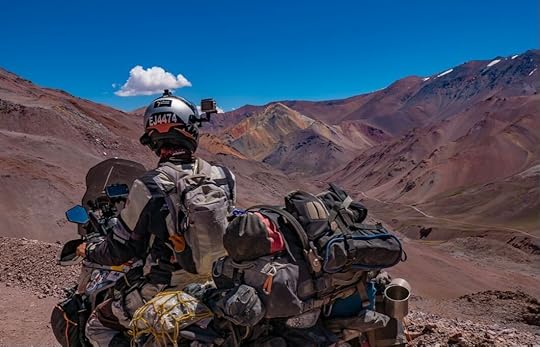 After twenty months of being on the road, going from our home in Chicago all the way down to the southernmost point in Argentina, I’d say Tim and I have learned a thing or two about living as travelers. Especially since both of us have to pack everything we’d ever need onto one motorcycle, we really have gotten to know what’s absolutely essential, and what isn’t worth its weight. [image error] These chairs are definitely worth their weight. We all know that if you’re packing for a long-term trip, you should bring good shoes, sunscreen, and if you’re overlanding in a vehicle, you’ll need tools and extra parts… but what about those little things that are often overlooked?
After twenty months of being on the road, going from our home in Chicago all the way down to the southernmost point in Argentina, I’d say Tim and I have learned a thing or two about living as travelers. Especially since both of us have to pack everything we’d ever need onto one motorcycle, we really have gotten to know what’s absolutely essential, and what isn’t worth its weight. [image error] These chairs are definitely worth their weight. We all know that if you’re packing for a long-term trip, you should bring good shoes, sunscreen, and if you’re overlanding in a vehicle, you’ll need tools and extra parts… but what about those little things that are often overlooked?
That’s what this list is for.
Now that we have to prepare for crossing the continent of Africa, I’ve been going over all our gear and making new adjustments. And I’ve taken note of ten essential items that have helped us along our journey so far, or things that I wish someone had told me about sooner. #1 - An Extension Cord At first, this might not seem very important, but there have been countless times then we've gotten to some hotel room in the middle of nowhere, and we really needed to charge our phones but also wanted to check out the map for tomorrow’s drive, or look at the weather forecast, or go through some recent pictures on our computer, but the battery’s about to die. And of course, the only outlet in the room is way off in the corner where you’d have to sit on the floor to be near it.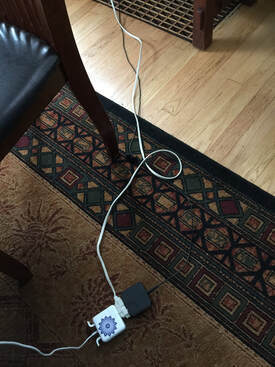 This is where an extension cord is invaluable. Even just a 6 foot one does the job nicely for us. We’ve met other travelers on the road who watched us bring out our extension cord, and as if it were made of gold they said, “Ohhh... that’s something we need.” #2 - A Fake Wallet
This is where an extension cord is invaluable. Even just a 6 foot one does the job nicely for us. We’ve met other travelers on the road who watched us bring out our extension cord, and as if it were made of gold they said, “Ohhh... that’s something we need.” #2 - A Fake Wallet 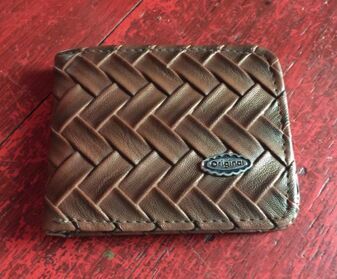 We didn’t learn this piece of advice until it was too late and we’d already paid some hefty bribes in Mexico. Because having a fake “throw-away” wallet with expired credit cards, useless ID’s, and a small amount of local cash isn’t only good if you get robbed, but it’s especially good when dealing with corrupt police or military checkpoints. You very quickly realize that these officials will make up any excuse to keep you there, always saying you’ve done something wrong, but then finally concluding that if you just pay this one astronomical fee, you could get out of it. They’ll take your driver’s license, passport if they can get it (don't ever give it), and they may even want to take your license plate to make sure you don’t just drive off. We’ve seen it all, but I can tell you that having a wallet where they can plainly see that you don’t have all the money they thought you did, they will most likely convince them to take the little cash that they can get. I only wish we knew of this trick sooner. #3 - VPN VPN stands for Virtual Private Network, and although this isn’t an actual object, it’s something that I’m so glad we got before traveling because it protects us online. It makes it so that when we log on to a hotel’s Wifi connection or connect our phone to a local network, no one else can access our passwords, credit card information, etc.
We didn’t learn this piece of advice until it was too late and we’d already paid some hefty bribes in Mexico. Because having a fake “throw-away” wallet with expired credit cards, useless ID’s, and a small amount of local cash isn’t only good if you get robbed, but it’s especially good when dealing with corrupt police or military checkpoints. You very quickly realize that these officials will make up any excuse to keep you there, always saying you’ve done something wrong, but then finally concluding that if you just pay this one astronomical fee, you could get out of it. They’ll take your driver’s license, passport if they can get it (don't ever give it), and they may even want to take your license plate to make sure you don’t just drive off. We’ve seen it all, but I can tell you that having a wallet where they can plainly see that you don’t have all the money they thought you did, they will most likely convince them to take the little cash that they can get. I only wish we knew of this trick sooner. #3 - VPN VPN stands for Virtual Private Network, and although this isn’t an actual object, it’s something that I’m so glad we got before traveling because it protects us online. It makes it so that when we log on to a hotel’s Wifi connection or connect our phone to a local network, no one else can access our passwords, credit card information, etc.  Basically, how it works is you pay a VPN company a monthly subscription fee (we use Private Internet Access) and then whenever you sign on to a Wifi network, you can turn on their app and it will connect you to a specific location in the world instead of the IP address of where you physically are. It’s the same concept that hackers use so that they can’t be traced, but this is a legit practice that you can use to make sure that whatever you’re doing online can’t be looked at by prying eyes.
Basically, how it works is you pay a VPN company a monthly subscription fee (we use Private Internet Access) and then whenever you sign on to a Wifi network, you can turn on their app and it will connect you to a specific location in the world instead of the IP address of where you physically are. It’s the same concept that hackers use so that they can’t be traced, but this is a legit practice that you can use to make sure that whatever you’re doing online can’t be looked at by prying eyes.
Another great benefit of having a VPN on your devices is that you can set your location to be your home region so that everything that pops up online will be in your language and the news and headlines will be relevant to your home country, not the country you’re in. You can always turn it off and see what’s going on locally, or for something really cool, you can say you’re in Japan and suddenly get YouTube ads all in Japanese.
But the best thing of all… if you’re subscribed to a streaming service (like Netflix), then put yourself back at home and you’ll be offered all the same shows as if you never left. No more being locked out of Netflix or limited to Spanish-speaking shows because you’re in Mexico! #4 - Mosquito Net This is something that I wish I’d brought to Latin America, but didn’t because I didn’t think it would be necessary. After all, I wasn’t going to Africa (well, not at the time anyway). But the truth is that if you are going to any tropical region of the world, there is a chance of getting malaria there, and probably other mosquito-borne diseases too, such as Dengue Fever or Chikungunya. Many people mistakenly think there are vaccines to prevent you from getting these serious, and sometimes fatal illnesses, but there aren’t, and the best way to prevent them is to avoid getting bitten by mosquitoes.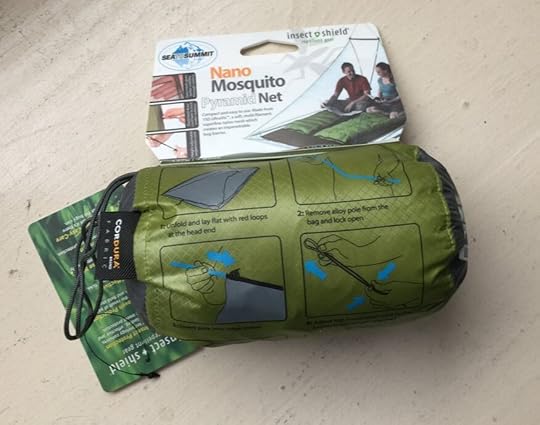 Malaria-carrying mosquitoes come out at night, but I thought that as long as I was in a hotel room, I’d be fine. That was naïve of me since I didn’t account for the hotel windows to have torn-apart screens, or broken panels of glass, or doors made of wooden slots. I should have never assumed that these “indoor” places would be truly indoors.
Malaria-carrying mosquitoes come out at night, but I thought that as long as I was in a hotel room, I’d be fine. That was naïve of me since I didn’t account for the hotel windows to have torn-apart screens, or broken panels of glass, or doors made of wooden slots. I should have never assumed that these “indoor” places would be truly indoors.
And in Latin America (and also in the southern United States), there are Kissing Bugs, Triatominae, which can carry the Chagas disease (causes heart failure) and are known to live in the walls and rafters of buildings. They bite your face at night while you're sleeping, especially your lips (hence kissing bug). I have seen and killed several of them in Latin America, and for all of these reasons and all the creepy crawlies that are out there, I will never travel without my mosquito net in the tropics again. #5 - Reflective Tarp We got two of these, and they’re actually called Space All Weather Blankets, but I would never use this as a blanket. Though I suppose that’s possible, I would describe it more as a thick plastic tarp with one side being reflective, and this indispensable object has many great uses. First of all, it can be a rain cover for any object left outside, or it can further waterproof your tent in a downpour.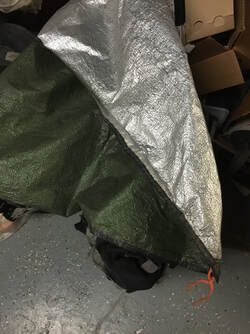 But it can also be used to retain your body heat in your tent on cold nights if you lay it reflective-side up underneath your pads (it can bring the temperature up 10°-15°F). You can do the same with laying one above your tent reflective-side down, but it also works with cooling. If you want to keep things cool underneath it on a hot sunny day, simply lay it reflective-side up. It’s amazing how well it works, and the possibilities of how to use it are pretty much endless. #6 - Solid Shampoo If you’re traveling in a large vehicle, then bringing bottles of liquid shampoo is not a big deal. But if you’re on a motorcycle, bicycle, or living out of a backpack, you soon realize that shampoo bottles are a heavy burden that constantly explode and get shampoo everywhere (especially when traveling in high altitudes or taking planes).
But it can also be used to retain your body heat in your tent on cold nights if you lay it reflective-side up underneath your pads (it can bring the temperature up 10°-15°F). You can do the same with laying one above your tent reflective-side down, but it also works with cooling. If you want to keep things cool underneath it on a hot sunny day, simply lay it reflective-side up. It’s amazing how well it works, and the possibilities of how to use it are pretty much endless. #6 - Solid Shampoo If you’re traveling in a large vehicle, then bringing bottles of liquid shampoo is not a big deal. But if you’re on a motorcycle, bicycle, or living out of a backpack, you soon realize that shampoo bottles are a heavy burden that constantly explode and get shampoo everywhere (especially when traveling in high altitudes or taking planes).
I didn’t learn about this until very recently, but just like a bar of soap, they now sell bars of shampoo (I bought mine from Lush, but if you don't have a Lush store near you, other brands on Amazon sell them.). They’re light-weight, small, will never explode, and will last you for many more washes than a bottle. And yes, they really do lather and act like regular shampoo.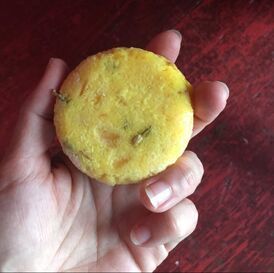 We also try to buy bars of Tide for washing clothes by hand, or bars of all-natural dish soap. You can’t always find them on the road, but they’re wonderful when you do. #7 - GPS with SOS and Texting Lots of travelers now are using GPS devices, not to find out which roads to take (you can just use Google Maps offline, OSM+, or Maps.me on your phone), but for emergency purposes of having an SOS button. When pressed, the SOS button will send a rescue team to your exact location, which could be lifesaving.
We also try to buy bars of Tide for washing clothes by hand, or bars of all-natural dish soap. You can’t always find them on the road, but they’re wonderful when you do. #7 - GPS with SOS and Texting Lots of travelers now are using GPS devices, not to find out which roads to take (you can just use Google Maps offline, OSM+, or Maps.me on your phone), but for emergency purposes of having an SOS button. When pressed, the SOS button will send a rescue team to your exact location, which could be lifesaving.
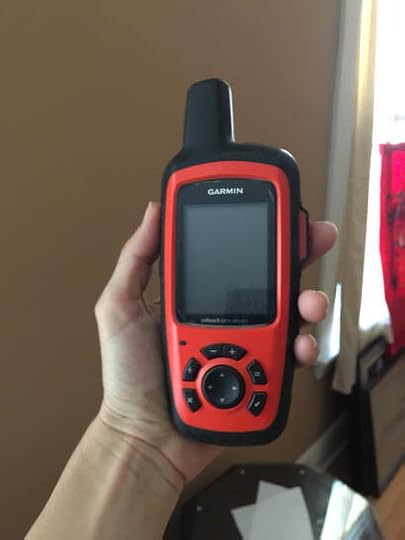 Some GPS systems are only good for emergencies. But our Garmin Inreach does more than that: it tracks every place we’ve been and puts it into a nice interactive map for us, and I also have the ability to send home messages every day (to tell my mother we’re settled down for the night), I can check the weather of my exact location, and in a lesser emergency, I don’t need to press the expensive SOS button to simply text friends in the area for help. They will immediately get our location and can come with a new tire, or a tow truck, or whatever we need. I absolutely love this piece-of-mind device (and my mother loves it too). #8 - Headphones Splitter Cable
Some GPS systems are only good for emergencies. But our Garmin Inreach does more than that: it tracks every place we’ve been and puts it into a nice interactive map for us, and I also have the ability to send home messages every day (to tell my mother we’re settled down for the night), I can check the weather of my exact location, and in a lesser emergency, I don’t need to press the expensive SOS button to simply text friends in the area for help. They will immediately get our location and can come with a new tire, or a tow truck, or whatever we need. I absolutely love this piece-of-mind device (and my mother loves it too). #8 - Headphones Splitter Cable 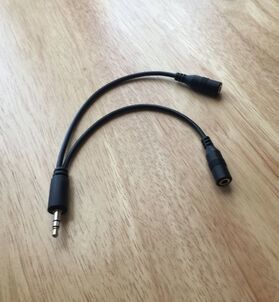 This small invention is very useful, especially if you're traveling with two people. What it does is split the headphones jack on your phone or computer so that two people can plug into the same device. That means you can watch your show or movie with your spouse or partner or friend (or even that girl you just met at the hostel) and you can both listen to it without disturbing everyone else around. Because not everyone wants to hear you Netflix and chill. #9 - Foldable Chairs If you’re going to be spending any amount of time camping or in nature, small folding chairs are great to have. I was always someone who loved sitting on the ground, sometimes even without a tarp or blanket underneath me, and I told Tim that chairs are not necessary to bring on this trip. Just a big waste of space.
This small invention is very useful, especially if you're traveling with two people. What it does is split the headphones jack on your phone or computer so that two people can plug into the same device. That means you can watch your show or movie with your spouse or partner or friend (or even that girl you just met at the hostel) and you can both listen to it without disturbing everyone else around. Because not everyone wants to hear you Netflix and chill. #9 - Foldable Chairs If you’re going to be spending any amount of time camping or in nature, small folding chairs are great to have. I was always someone who loved sitting on the ground, sometimes even without a tarp or blanket underneath me, and I told Tim that chairs are not necessary to bring on this trip. Just a big waste of space.
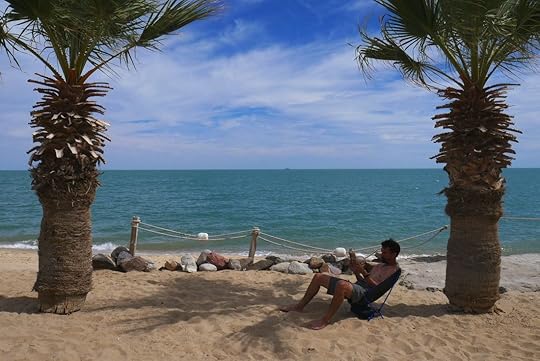 And then he bought a G4Free chair, and he had this awesome comfy place where he could lay back and read on the beach, or watch the sunset, or sit beside the fire, or cook on our stove, and I'll admit I got jealous. Now that we both have one, I would never camp without them regardless of how much space it takes up on the bike.
And then he bought a G4Free chair, and he had this awesome comfy place where he could lay back and read on the beach, or watch the sunset, or sit beside the fire, or cook on our stove, and I'll admit I got jealous. Now that we both have one, I would never camp without them regardless of how much space it takes up on the bike.
Also, when we’ve had to wait for hours for road closures to open, we just get out our chairs and open up a book and read in the shade of a tree while everyone else stands around. These chairs are great, except that our G4Free chairs have had minor breaks, but nothing a little superglue and duct tape couldn't fix. We bought ours two years ago and have put them through hell, so a little damage makes sense, but if you don't like this brand, then there are also tons of other folding chair companies out there like it. So shop around to find which you like best. #10 - Down Quilt This is quite possibly my favorite item that we own. It was not cheap, but our down quilt (Enlightened Equipment) keeps us incredibly warm at night. I have camped throughout my life and just thought that being cold at night was a part of camping. Not so! Our double-wide down quilt packs down to nothing, is unbelievably light, but is also the warmest thing I’ve ever owned. Sometimes I even get hot, in Patagonia too! So what makes it a quilt and not a sleeping bag? With a sleeping bag, when your body lays on it, your weight is compressing the insulation on bottom, making that part useless. So what the quilt does is it cuts out that bottom part, reducing its size and weight.
Our down quilt can snap onto straps to stay in place on our sleeping pads, or we can unsnap it and throw our legs out if we get too hot. I’ve also used it in hotels when they haven’t provided enough blankets. Basically, it’s amazing.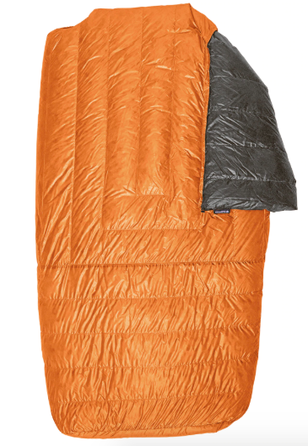 #11 - Shockproof Computer Case These days, almost everyone travels with a computer, but not everyone realizes how much damage is being done to it by the constant vibrations of going down washboard roads. Before our trip, we actually destroyed a laptop when going down some very bumpy fire roads (it was even a Solid State laptop). So we now always make sure our computer is completely shut down when we ride.
#11 - Shockproof Computer Case These days, almost everyone travels with a computer, but not everyone realizes how much damage is being done to it by the constant vibrations of going down washboard roads. Before our trip, we actually destroyed a laptop when going down some very bumpy fire roads (it was even a Solid State laptop). So we now always make sure our computer is completely shut down when we ride. 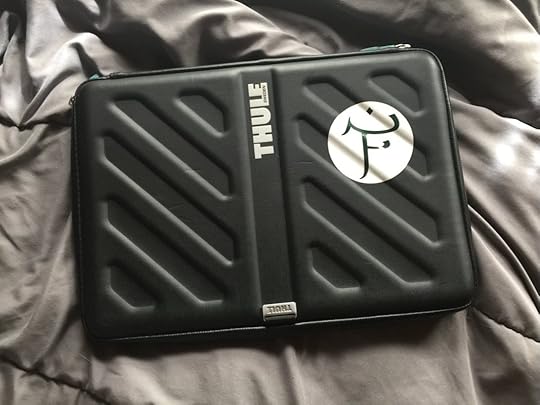 But we also purchased a shockproof and water resistant computer case for it (Thule), which has been great. It adds bulk to the dimensions of the computer, but I don’t have to worry about it anymore when we go over all those annoying Latin American speed bumps. #12 - Magnetic Phone Charger This one is particularly useful for if you use your phone as a GPS, and while you have it plugged into your vehicle to keep it charged all day, all the bumps and vibrations from the road can start to erode at the charging port. I’ve heard from many travelers that their phone’s charging port started to act up, and then eventually just died, meaning that they’d never be able to charge their phone again. What a disaster.
But we also purchased a shockproof and water resistant computer case for it (Thule), which has been great. It adds bulk to the dimensions of the computer, but I don’t have to worry about it anymore when we go over all those annoying Latin American speed bumps. #12 - Magnetic Phone Charger This one is particularly useful for if you use your phone as a GPS, and while you have it plugged into your vehicle to keep it charged all day, all the bumps and vibrations from the road can start to erode at the charging port. I’ve heard from many travelers that their phone’s charging port started to act up, and then eventually just died, meaning that they’d never be able to charge their phone again. What a disaster.
 In fact, this same situation started happening to us, but luckily someone told us about these tiny magnetic chargers that you put into the port on your phone (this may only be an Andriod thing, but check to see if someone makes iPhone ones). It makes it so that the road’s vibrations aren’t destroying the port anymore, and it works wonderfully. There are just a few problems with it: first, the cord can now blow off the port if it’s extremely windy (like in Argentina), second, you wouldn’t want to use it in the rain, and third, because it’s magnetic, little bits of metal or iron rocks can get stuck on there. But for saving your phone from complete disaster, these minor inconveniences have been worth it for us. Some Bonus Items If you like to cook while on the road, then a potato peeler may be useful for all sorts of fruits and veggies, or a meat thermometer (especially if you’re going to be traveling in Argentina and want to cook up some of their amazing steaks). We have also recently bought a GSI Fairshare collapsible mug / food storage container. These are great for not just drinking coffee in the morning, but also for taking lunch leftovers with us on the road.
In fact, this same situation started happening to us, but luckily someone told us about these tiny magnetic chargers that you put into the port on your phone (this may only be an Andriod thing, but check to see if someone makes iPhone ones). It makes it so that the road’s vibrations aren’t destroying the port anymore, and it works wonderfully. There are just a few problems with it: first, the cord can now blow off the port if it’s extremely windy (like in Argentina), second, you wouldn’t want to use it in the rain, and third, because it’s magnetic, little bits of metal or iron rocks can get stuck on there. But for saving your phone from complete disaster, these minor inconveniences have been worth it for us. Some Bonus Items If you like to cook while on the road, then a potato peeler may be useful for all sorts of fruits and veggies, or a meat thermometer (especially if you’re going to be traveling in Argentina and want to cook up some of their amazing steaks). We have also recently bought a GSI Fairshare collapsible mug / food storage container. These are great for not just drinking coffee in the morning, but also for taking lunch leftovers with us on the road. 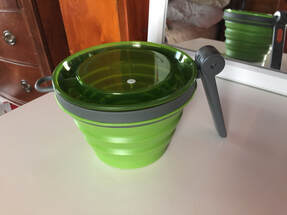 Lastly, someone recommended we buy a collapsible bucket and bring that with us. We did, and it was very useful for washing clothes, dishes, taking sponge baths out in the desert, and when I hurt my foot, we filled it up with icy water to soak my foot in. But we ended up ditching it when we discovered that our dry bag worked just as well. That being said, I'd recommend you have something durable and waterproof that can be used as a bucket or sink.
Lastly, someone recommended we buy a collapsible bucket and bring that with us. We did, and it was very useful for washing clothes, dishes, taking sponge baths out in the desert, and when I hurt my foot, we filled it up with icy water to soak my foot in. But we ended up ditching it when we discovered that our dry bag worked just as well. That being said, I'd recommend you have something durable and waterproof that can be used as a bucket or sink. 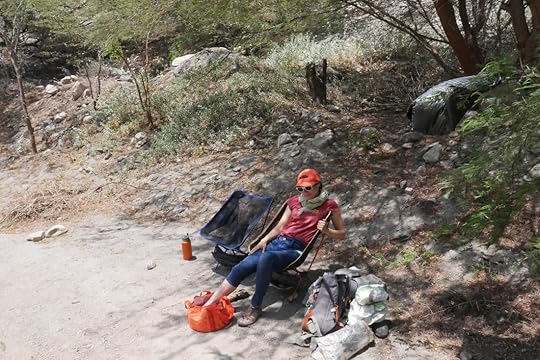 Ok, so when I hurt my foot there definitely wasn't any ice out there, but the glacial river water worked well in the bucket. I hope this list helps fellow travelers out there, and if you have some more great travel advice on the best things to bring, let us know on Facebook!
Ok, so when I hurt my foot there definitely wasn't any ice out there, but the glacial river water worked well in the bucket. I hope this list helps fellow travelers out there, and if you have some more great travel advice on the best things to bring, let us know on Facebook!
I'm sure we'll be expanding on this list as we travel through Africa, so stay tuned and we'll keep you posted on all our adventures. Subscribe to Our Blog Be a part of the journey and help push us forward by checking out our Books and Photos for sale: Books and Photos for Sale
 After twenty months of being on the road, going from our home in Chicago all the way down to the southernmost point in Argentina, I’d say Tim and I have learned a thing or two about living as travelers. Especially since both of us have to pack everything we’d ever need onto one motorcycle, we really have gotten to know what’s absolutely essential, and what isn’t worth its weight. [image error] These chairs are definitely worth their weight. We all know that if you’re packing for a long-term trip, you should bring good shoes, sunscreen, and if you’re overlanding in a vehicle, you’ll need tools and extra parts… but what about those little things that are often overlooked?
After twenty months of being on the road, going from our home in Chicago all the way down to the southernmost point in Argentina, I’d say Tim and I have learned a thing or two about living as travelers. Especially since both of us have to pack everything we’d ever need onto one motorcycle, we really have gotten to know what’s absolutely essential, and what isn’t worth its weight. [image error] These chairs are definitely worth their weight. We all know that if you’re packing for a long-term trip, you should bring good shoes, sunscreen, and if you’re overlanding in a vehicle, you’ll need tools and extra parts… but what about those little things that are often overlooked?That’s what this list is for.
Now that we have to prepare for crossing the continent of Africa, I’ve been going over all our gear and making new adjustments. And I’ve taken note of ten essential items that have helped us along our journey so far, or things that I wish someone had told me about sooner. #1 - An Extension Cord At first, this might not seem very important, but there have been countless times then we've gotten to some hotel room in the middle of nowhere, and we really needed to charge our phones but also wanted to check out the map for tomorrow’s drive, or look at the weather forecast, or go through some recent pictures on our computer, but the battery’s about to die. And of course, the only outlet in the room is way off in the corner where you’d have to sit on the floor to be near it.
 This is where an extension cord is invaluable. Even just a 6 foot one does the job nicely for us. We’ve met other travelers on the road who watched us bring out our extension cord, and as if it were made of gold they said, “Ohhh... that’s something we need.” #2 - A Fake Wallet
This is where an extension cord is invaluable. Even just a 6 foot one does the job nicely for us. We’ve met other travelers on the road who watched us bring out our extension cord, and as if it were made of gold they said, “Ohhh... that’s something we need.” #2 - A Fake Wallet  We didn’t learn this piece of advice until it was too late and we’d already paid some hefty bribes in Mexico. Because having a fake “throw-away” wallet with expired credit cards, useless ID’s, and a small amount of local cash isn’t only good if you get robbed, but it’s especially good when dealing with corrupt police or military checkpoints. You very quickly realize that these officials will make up any excuse to keep you there, always saying you’ve done something wrong, but then finally concluding that if you just pay this one astronomical fee, you could get out of it. They’ll take your driver’s license, passport if they can get it (don't ever give it), and they may even want to take your license plate to make sure you don’t just drive off. We’ve seen it all, but I can tell you that having a wallet where they can plainly see that you don’t have all the money they thought you did, they will most likely convince them to take the little cash that they can get. I only wish we knew of this trick sooner. #3 - VPN VPN stands for Virtual Private Network, and although this isn’t an actual object, it’s something that I’m so glad we got before traveling because it protects us online. It makes it so that when we log on to a hotel’s Wifi connection or connect our phone to a local network, no one else can access our passwords, credit card information, etc.
We didn’t learn this piece of advice until it was too late and we’d already paid some hefty bribes in Mexico. Because having a fake “throw-away” wallet with expired credit cards, useless ID’s, and a small amount of local cash isn’t only good if you get robbed, but it’s especially good when dealing with corrupt police or military checkpoints. You very quickly realize that these officials will make up any excuse to keep you there, always saying you’ve done something wrong, but then finally concluding that if you just pay this one astronomical fee, you could get out of it. They’ll take your driver’s license, passport if they can get it (don't ever give it), and they may even want to take your license plate to make sure you don’t just drive off. We’ve seen it all, but I can tell you that having a wallet where they can plainly see that you don’t have all the money they thought you did, they will most likely convince them to take the little cash that they can get. I only wish we knew of this trick sooner. #3 - VPN VPN stands for Virtual Private Network, and although this isn’t an actual object, it’s something that I’m so glad we got before traveling because it protects us online. It makes it so that when we log on to a hotel’s Wifi connection or connect our phone to a local network, no one else can access our passwords, credit card information, etc.  Basically, how it works is you pay a VPN company a monthly subscription fee (we use Private Internet Access) and then whenever you sign on to a Wifi network, you can turn on their app and it will connect you to a specific location in the world instead of the IP address of where you physically are. It’s the same concept that hackers use so that they can’t be traced, but this is a legit practice that you can use to make sure that whatever you’re doing online can’t be looked at by prying eyes.
Basically, how it works is you pay a VPN company a monthly subscription fee (we use Private Internet Access) and then whenever you sign on to a Wifi network, you can turn on their app and it will connect you to a specific location in the world instead of the IP address of where you physically are. It’s the same concept that hackers use so that they can’t be traced, but this is a legit practice that you can use to make sure that whatever you’re doing online can’t be looked at by prying eyes.Another great benefit of having a VPN on your devices is that you can set your location to be your home region so that everything that pops up online will be in your language and the news and headlines will be relevant to your home country, not the country you’re in. You can always turn it off and see what’s going on locally, or for something really cool, you can say you’re in Japan and suddenly get YouTube ads all in Japanese.
But the best thing of all… if you’re subscribed to a streaming service (like Netflix), then put yourself back at home and you’ll be offered all the same shows as if you never left. No more being locked out of Netflix or limited to Spanish-speaking shows because you’re in Mexico! #4 - Mosquito Net This is something that I wish I’d brought to Latin America, but didn’t because I didn’t think it would be necessary. After all, I wasn’t going to Africa (well, not at the time anyway). But the truth is that if you are going to any tropical region of the world, there is a chance of getting malaria there, and probably other mosquito-borne diseases too, such as Dengue Fever or Chikungunya. Many people mistakenly think there are vaccines to prevent you from getting these serious, and sometimes fatal illnesses, but there aren’t, and the best way to prevent them is to avoid getting bitten by mosquitoes.
 Malaria-carrying mosquitoes come out at night, but I thought that as long as I was in a hotel room, I’d be fine. That was naïve of me since I didn’t account for the hotel windows to have torn-apart screens, or broken panels of glass, or doors made of wooden slots. I should have never assumed that these “indoor” places would be truly indoors.
Malaria-carrying mosquitoes come out at night, but I thought that as long as I was in a hotel room, I’d be fine. That was naïve of me since I didn’t account for the hotel windows to have torn-apart screens, or broken panels of glass, or doors made of wooden slots. I should have never assumed that these “indoor” places would be truly indoors.And in Latin America (and also in the southern United States), there are Kissing Bugs, Triatominae, which can carry the Chagas disease (causes heart failure) and are known to live in the walls and rafters of buildings. They bite your face at night while you're sleeping, especially your lips (hence kissing bug). I have seen and killed several of them in Latin America, and for all of these reasons and all the creepy crawlies that are out there, I will never travel without my mosquito net in the tropics again. #5 - Reflective Tarp We got two of these, and they’re actually called Space All Weather Blankets, but I would never use this as a blanket. Though I suppose that’s possible, I would describe it more as a thick plastic tarp with one side being reflective, and this indispensable object has many great uses. First of all, it can be a rain cover for any object left outside, or it can further waterproof your tent in a downpour.
 But it can also be used to retain your body heat in your tent on cold nights if you lay it reflective-side up underneath your pads (it can bring the temperature up 10°-15°F). You can do the same with laying one above your tent reflective-side down, but it also works with cooling. If you want to keep things cool underneath it on a hot sunny day, simply lay it reflective-side up. It’s amazing how well it works, and the possibilities of how to use it are pretty much endless. #6 - Solid Shampoo If you’re traveling in a large vehicle, then bringing bottles of liquid shampoo is not a big deal. But if you’re on a motorcycle, bicycle, or living out of a backpack, you soon realize that shampoo bottles are a heavy burden that constantly explode and get shampoo everywhere (especially when traveling in high altitudes or taking planes).
But it can also be used to retain your body heat in your tent on cold nights if you lay it reflective-side up underneath your pads (it can bring the temperature up 10°-15°F). You can do the same with laying one above your tent reflective-side down, but it also works with cooling. If you want to keep things cool underneath it on a hot sunny day, simply lay it reflective-side up. It’s amazing how well it works, and the possibilities of how to use it are pretty much endless. #6 - Solid Shampoo If you’re traveling in a large vehicle, then bringing bottles of liquid shampoo is not a big deal. But if you’re on a motorcycle, bicycle, or living out of a backpack, you soon realize that shampoo bottles are a heavy burden that constantly explode and get shampoo everywhere (especially when traveling in high altitudes or taking planes).I didn’t learn about this until very recently, but just like a bar of soap, they now sell bars of shampoo (I bought mine from Lush, but if you don't have a Lush store near you, other brands on Amazon sell them.). They’re light-weight, small, will never explode, and will last you for many more washes than a bottle. And yes, they really do lather and act like regular shampoo.
 We also try to buy bars of Tide for washing clothes by hand, or bars of all-natural dish soap. You can’t always find them on the road, but they’re wonderful when you do. #7 - GPS with SOS and Texting Lots of travelers now are using GPS devices, not to find out which roads to take (you can just use Google Maps offline, OSM+, or Maps.me on your phone), but for emergency purposes of having an SOS button. When pressed, the SOS button will send a rescue team to your exact location, which could be lifesaving.
We also try to buy bars of Tide for washing clothes by hand, or bars of all-natural dish soap. You can’t always find them on the road, but they’re wonderful when you do. #7 - GPS with SOS and Texting Lots of travelers now are using GPS devices, not to find out which roads to take (you can just use Google Maps offline, OSM+, or Maps.me on your phone), but for emergency purposes of having an SOS button. When pressed, the SOS button will send a rescue team to your exact location, which could be lifesaving. Some GPS systems are only good for emergencies. But our Garmin Inreach does more than that: it tracks every place we’ve been and puts it into a nice interactive map for us, and I also have the ability to send home messages every day (to tell my mother we’re settled down for the night), I can check the weather of my exact location, and in a lesser emergency, I don’t need to press the expensive SOS button to simply text friends in the area for help. They will immediately get our location and can come with a new tire, or a tow truck, or whatever we need. I absolutely love this piece-of-mind device (and my mother loves it too). #8 - Headphones Splitter Cable
Some GPS systems are only good for emergencies. But our Garmin Inreach does more than that: it tracks every place we’ve been and puts it into a nice interactive map for us, and I also have the ability to send home messages every day (to tell my mother we’re settled down for the night), I can check the weather of my exact location, and in a lesser emergency, I don’t need to press the expensive SOS button to simply text friends in the area for help. They will immediately get our location and can come with a new tire, or a tow truck, or whatever we need. I absolutely love this piece-of-mind device (and my mother loves it too). #8 - Headphones Splitter Cable  This small invention is very useful, especially if you're traveling with two people. What it does is split the headphones jack on your phone or computer so that two people can plug into the same device. That means you can watch your show or movie with your spouse or partner or friend (or even that girl you just met at the hostel) and you can both listen to it without disturbing everyone else around. Because not everyone wants to hear you Netflix and chill. #9 - Foldable Chairs If you’re going to be spending any amount of time camping or in nature, small folding chairs are great to have. I was always someone who loved sitting on the ground, sometimes even without a tarp or blanket underneath me, and I told Tim that chairs are not necessary to bring on this trip. Just a big waste of space.
This small invention is very useful, especially if you're traveling with two people. What it does is split the headphones jack on your phone or computer so that two people can plug into the same device. That means you can watch your show or movie with your spouse or partner or friend (or even that girl you just met at the hostel) and you can both listen to it without disturbing everyone else around. Because not everyone wants to hear you Netflix and chill. #9 - Foldable Chairs If you’re going to be spending any amount of time camping or in nature, small folding chairs are great to have. I was always someone who loved sitting on the ground, sometimes even without a tarp or blanket underneath me, and I told Tim that chairs are not necessary to bring on this trip. Just a big waste of space. And then he bought a G4Free chair, and he had this awesome comfy place where he could lay back and read on the beach, or watch the sunset, or sit beside the fire, or cook on our stove, and I'll admit I got jealous. Now that we both have one, I would never camp without them regardless of how much space it takes up on the bike.
And then he bought a G4Free chair, and he had this awesome comfy place where he could lay back and read on the beach, or watch the sunset, or sit beside the fire, or cook on our stove, and I'll admit I got jealous. Now that we both have one, I would never camp without them regardless of how much space it takes up on the bike.Also, when we’ve had to wait for hours for road closures to open, we just get out our chairs and open up a book and read in the shade of a tree while everyone else stands around. These chairs are great, except that our G4Free chairs have had minor breaks, but nothing a little superglue and duct tape couldn't fix. We bought ours two years ago and have put them through hell, so a little damage makes sense, but if you don't like this brand, then there are also tons of other folding chair companies out there like it. So shop around to find which you like best. #10 - Down Quilt This is quite possibly my favorite item that we own. It was not cheap, but our down quilt (Enlightened Equipment) keeps us incredibly warm at night. I have camped throughout my life and just thought that being cold at night was a part of camping. Not so! Our double-wide down quilt packs down to nothing, is unbelievably light, but is also the warmest thing I’ve ever owned. Sometimes I even get hot, in Patagonia too! So what makes it a quilt and not a sleeping bag? With a sleeping bag, when your body lays on it, your weight is compressing the insulation on bottom, making that part useless. So what the quilt does is it cuts out that bottom part, reducing its size and weight.
Our down quilt can snap onto straps to stay in place on our sleeping pads, or we can unsnap it and throw our legs out if we get too hot. I’ve also used it in hotels when they haven’t provided enough blankets. Basically, it’s amazing.
 #11 - Shockproof Computer Case These days, almost everyone travels with a computer, but not everyone realizes how much damage is being done to it by the constant vibrations of going down washboard roads. Before our trip, we actually destroyed a laptop when going down some very bumpy fire roads (it was even a Solid State laptop). So we now always make sure our computer is completely shut down when we ride.
#11 - Shockproof Computer Case These days, almost everyone travels with a computer, but not everyone realizes how much damage is being done to it by the constant vibrations of going down washboard roads. Before our trip, we actually destroyed a laptop when going down some very bumpy fire roads (it was even a Solid State laptop). So we now always make sure our computer is completely shut down when we ride.  But we also purchased a shockproof and water resistant computer case for it (Thule), which has been great. It adds bulk to the dimensions of the computer, but I don’t have to worry about it anymore when we go over all those annoying Latin American speed bumps. #12 - Magnetic Phone Charger This one is particularly useful for if you use your phone as a GPS, and while you have it plugged into your vehicle to keep it charged all day, all the bumps and vibrations from the road can start to erode at the charging port. I’ve heard from many travelers that their phone’s charging port started to act up, and then eventually just died, meaning that they’d never be able to charge their phone again. What a disaster.
But we also purchased a shockproof and water resistant computer case for it (Thule), which has been great. It adds bulk to the dimensions of the computer, but I don’t have to worry about it anymore when we go over all those annoying Latin American speed bumps. #12 - Magnetic Phone Charger This one is particularly useful for if you use your phone as a GPS, and while you have it plugged into your vehicle to keep it charged all day, all the bumps and vibrations from the road can start to erode at the charging port. I’ve heard from many travelers that their phone’s charging port started to act up, and then eventually just died, meaning that they’d never be able to charge their phone again. What a disaster. In fact, this same situation started happening to us, but luckily someone told us about these tiny magnetic chargers that you put into the port on your phone (this may only be an Andriod thing, but check to see if someone makes iPhone ones). It makes it so that the road’s vibrations aren’t destroying the port anymore, and it works wonderfully. There are just a few problems with it: first, the cord can now blow off the port if it’s extremely windy (like in Argentina), second, you wouldn’t want to use it in the rain, and third, because it’s magnetic, little bits of metal or iron rocks can get stuck on there. But for saving your phone from complete disaster, these minor inconveniences have been worth it for us. Some Bonus Items If you like to cook while on the road, then a potato peeler may be useful for all sorts of fruits and veggies, or a meat thermometer (especially if you’re going to be traveling in Argentina and want to cook up some of their amazing steaks). We have also recently bought a GSI Fairshare collapsible mug / food storage container. These are great for not just drinking coffee in the morning, but also for taking lunch leftovers with us on the road.
In fact, this same situation started happening to us, but luckily someone told us about these tiny magnetic chargers that you put into the port on your phone (this may only be an Andriod thing, but check to see if someone makes iPhone ones). It makes it so that the road’s vibrations aren’t destroying the port anymore, and it works wonderfully. There are just a few problems with it: first, the cord can now blow off the port if it’s extremely windy (like in Argentina), second, you wouldn’t want to use it in the rain, and third, because it’s magnetic, little bits of metal or iron rocks can get stuck on there. But for saving your phone from complete disaster, these minor inconveniences have been worth it for us. Some Bonus Items If you like to cook while on the road, then a potato peeler may be useful for all sorts of fruits and veggies, or a meat thermometer (especially if you’re going to be traveling in Argentina and want to cook up some of their amazing steaks). We have also recently bought a GSI Fairshare collapsible mug / food storage container. These are great for not just drinking coffee in the morning, but also for taking lunch leftovers with us on the road.  Lastly, someone recommended we buy a collapsible bucket and bring that with us. We did, and it was very useful for washing clothes, dishes, taking sponge baths out in the desert, and when I hurt my foot, we filled it up with icy water to soak my foot in. But we ended up ditching it when we discovered that our dry bag worked just as well. That being said, I'd recommend you have something durable and waterproof that can be used as a bucket or sink.
Lastly, someone recommended we buy a collapsible bucket and bring that with us. We did, and it was very useful for washing clothes, dishes, taking sponge baths out in the desert, and when I hurt my foot, we filled it up with icy water to soak my foot in. But we ended up ditching it when we discovered that our dry bag worked just as well. That being said, I'd recommend you have something durable and waterproof that can be used as a bucket or sink.  Ok, so when I hurt my foot there definitely wasn't any ice out there, but the glacial river water worked well in the bucket. I hope this list helps fellow travelers out there, and if you have some more great travel advice on the best things to bring, let us know on Facebook!
Ok, so when I hurt my foot there definitely wasn't any ice out there, but the glacial river water worked well in the bucket. I hope this list helps fellow travelers out there, and if you have some more great travel advice on the best things to bring, let us know on Facebook!I'm sure we'll be expanding on this list as we travel through Africa, so stay tuned and we'll keep you posted on all our adventures. Subscribe to Our Blog Be a part of the journey and help push us forward by checking out our Books and Photos for sale: Books and Photos for Sale
Published on July 31, 2019 12:03



